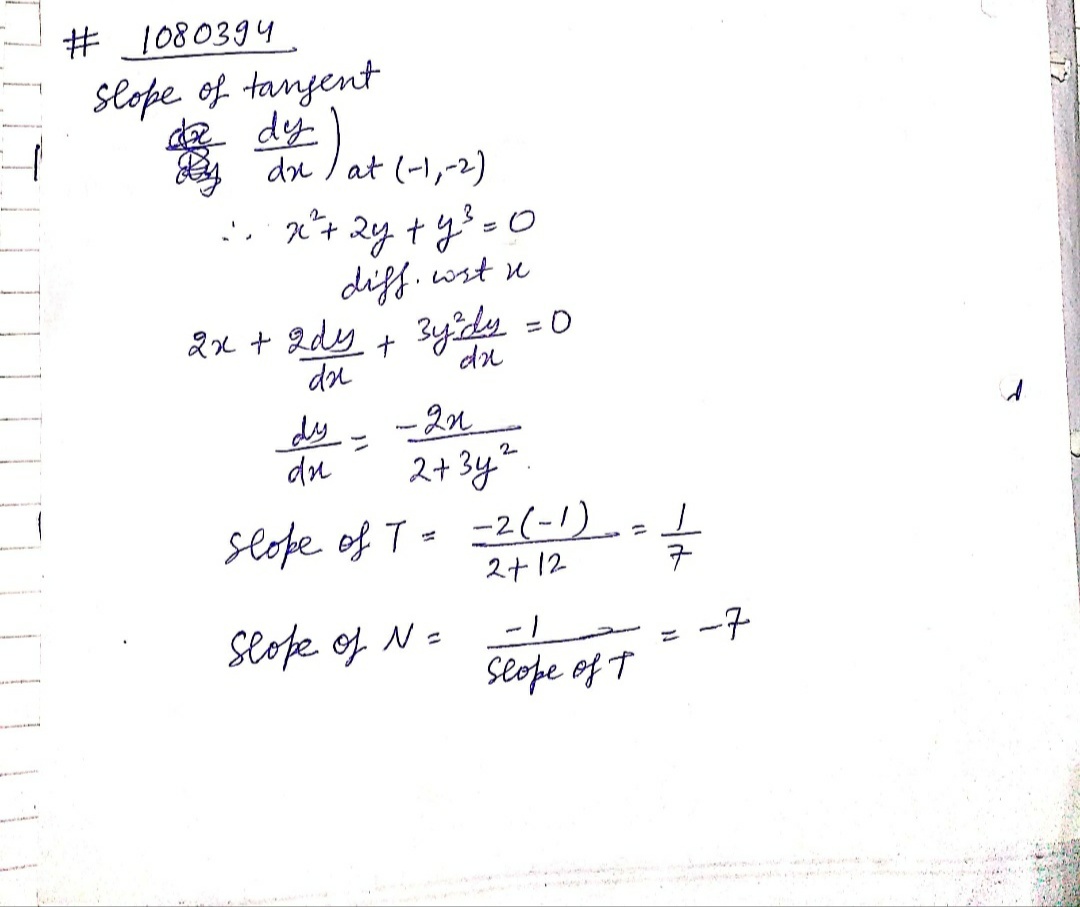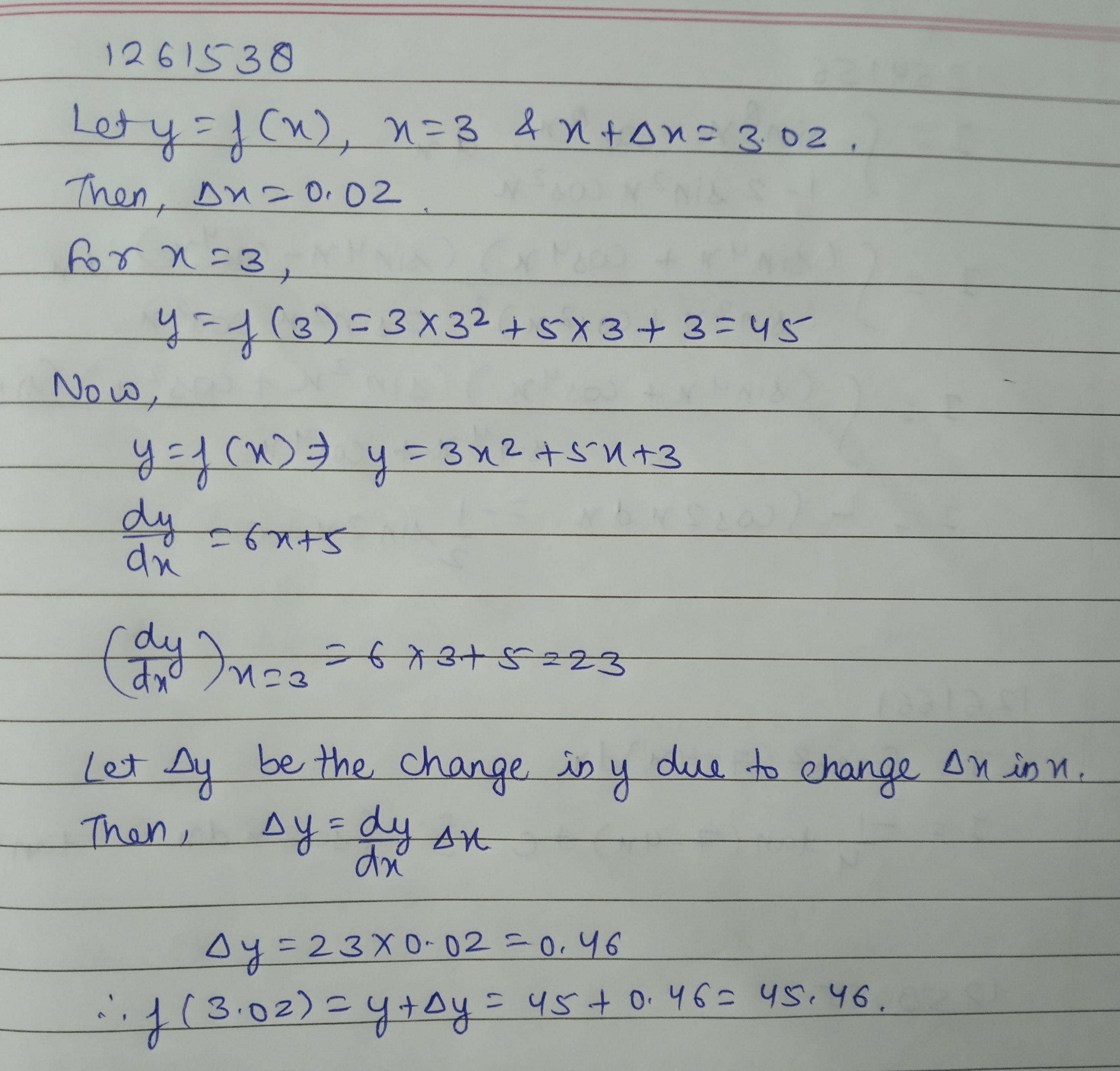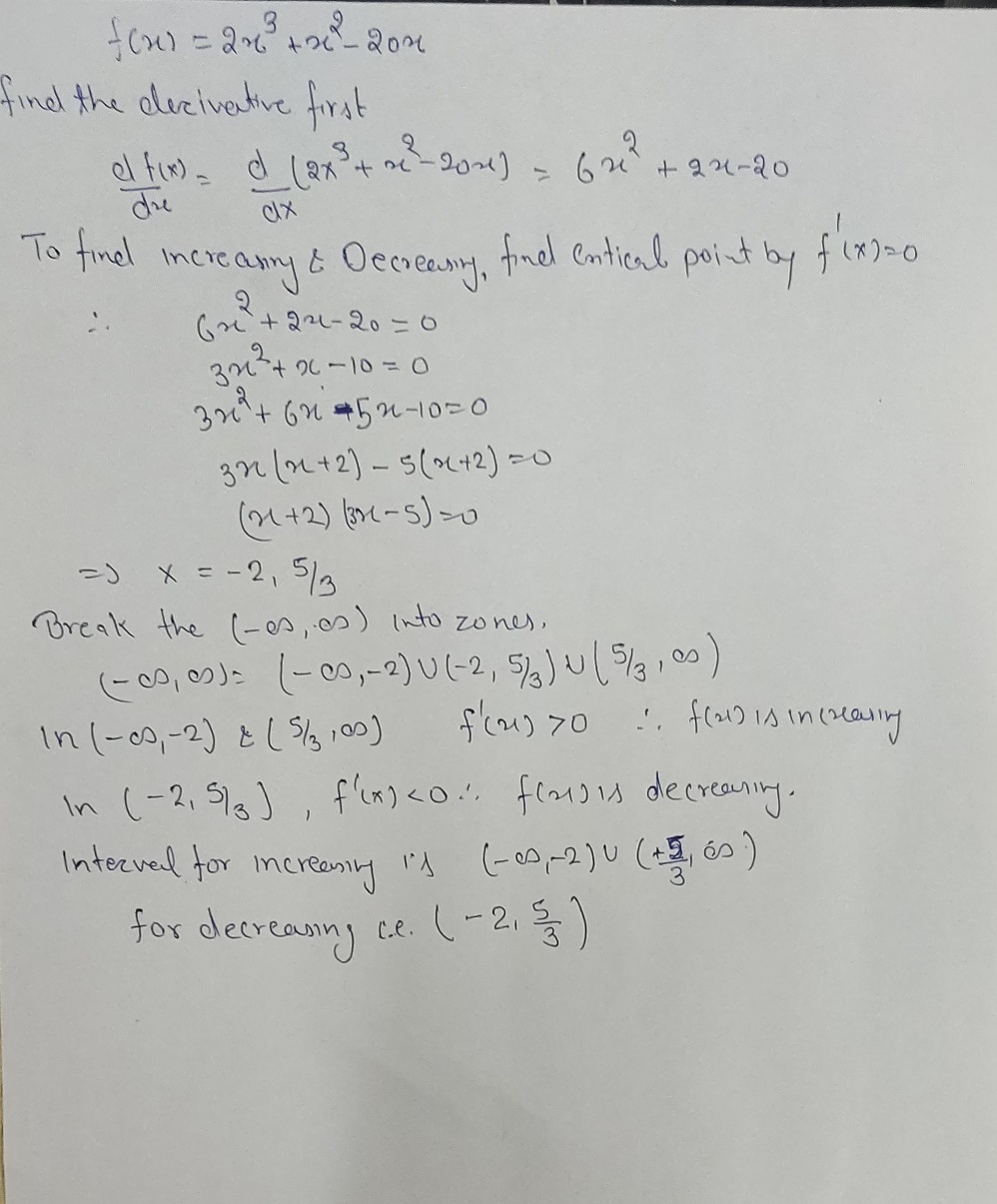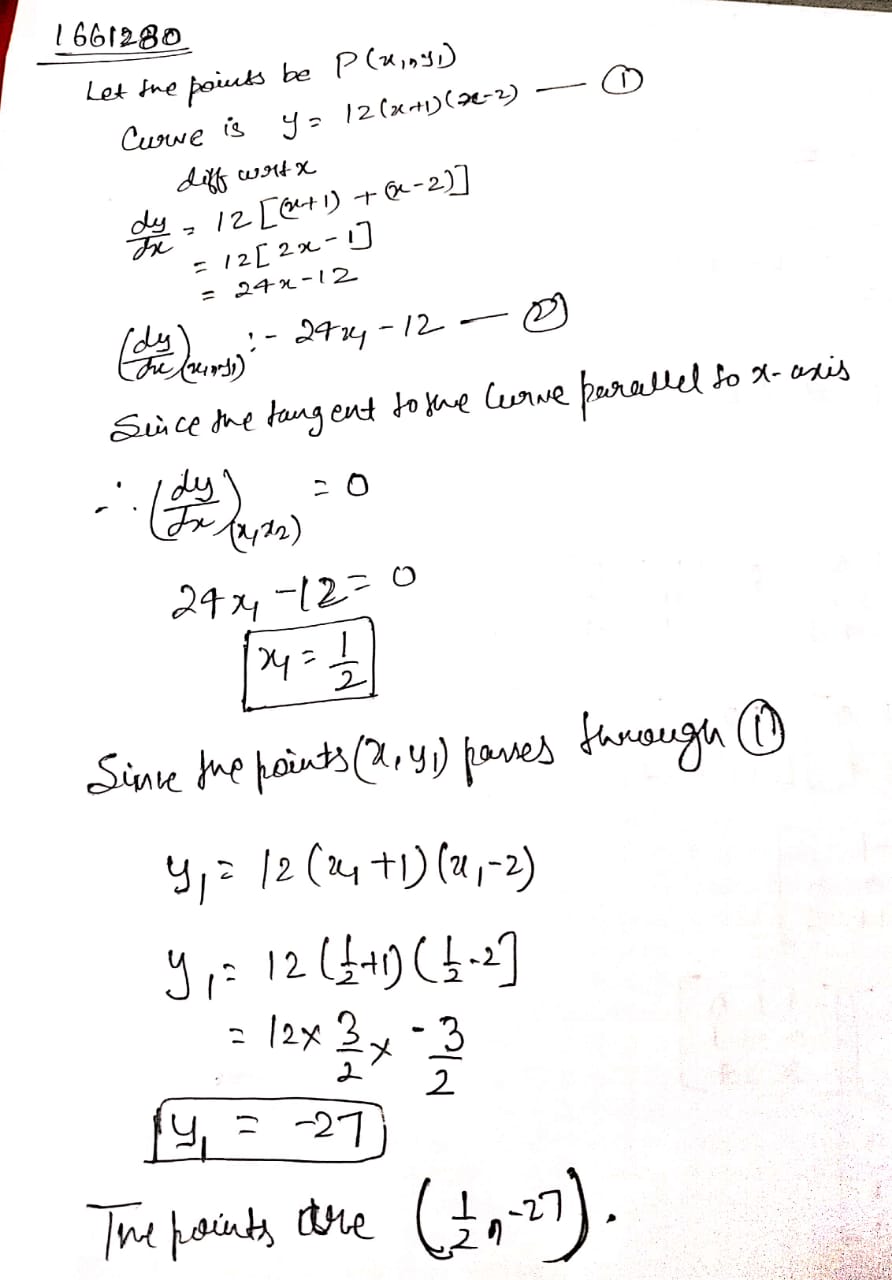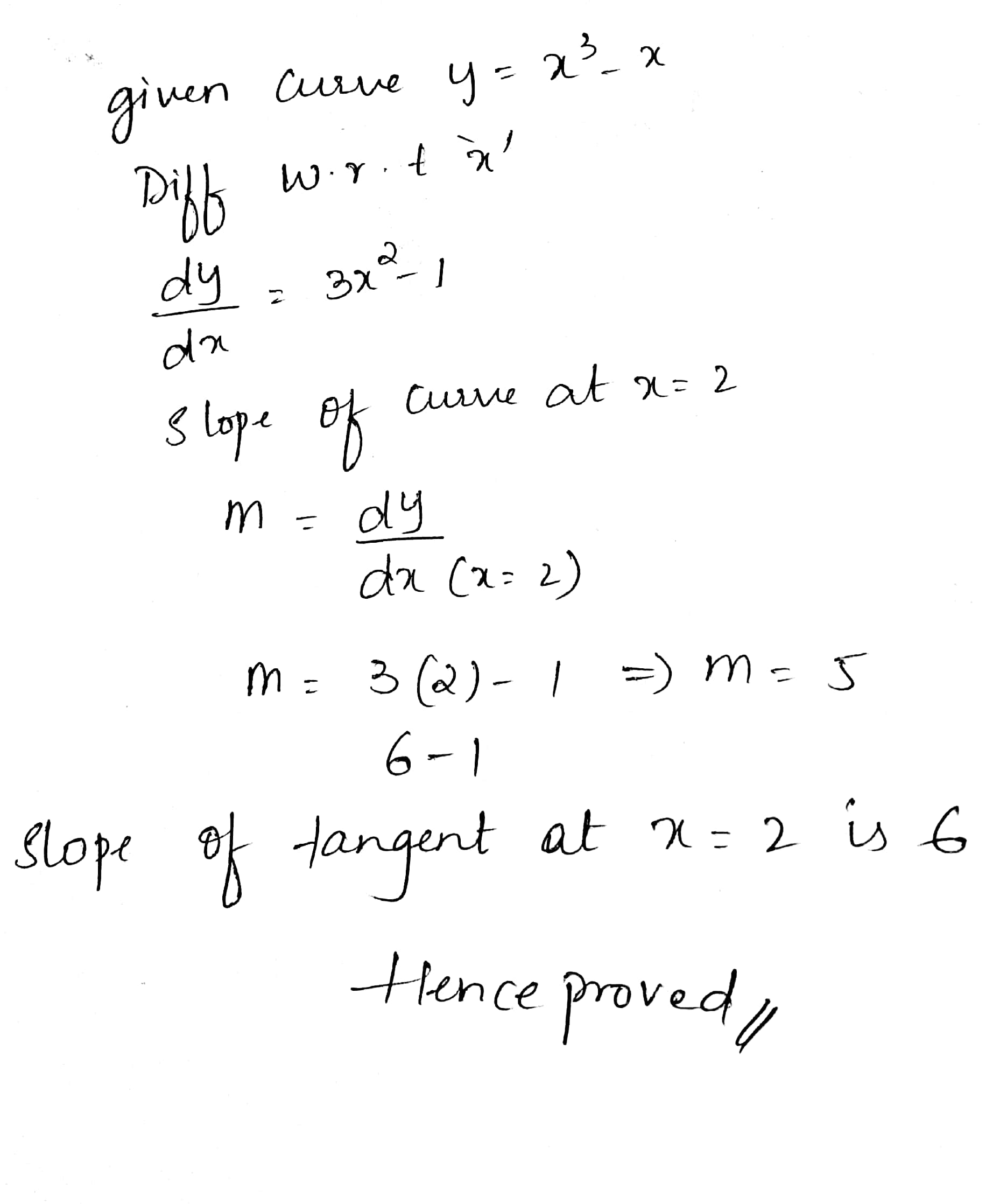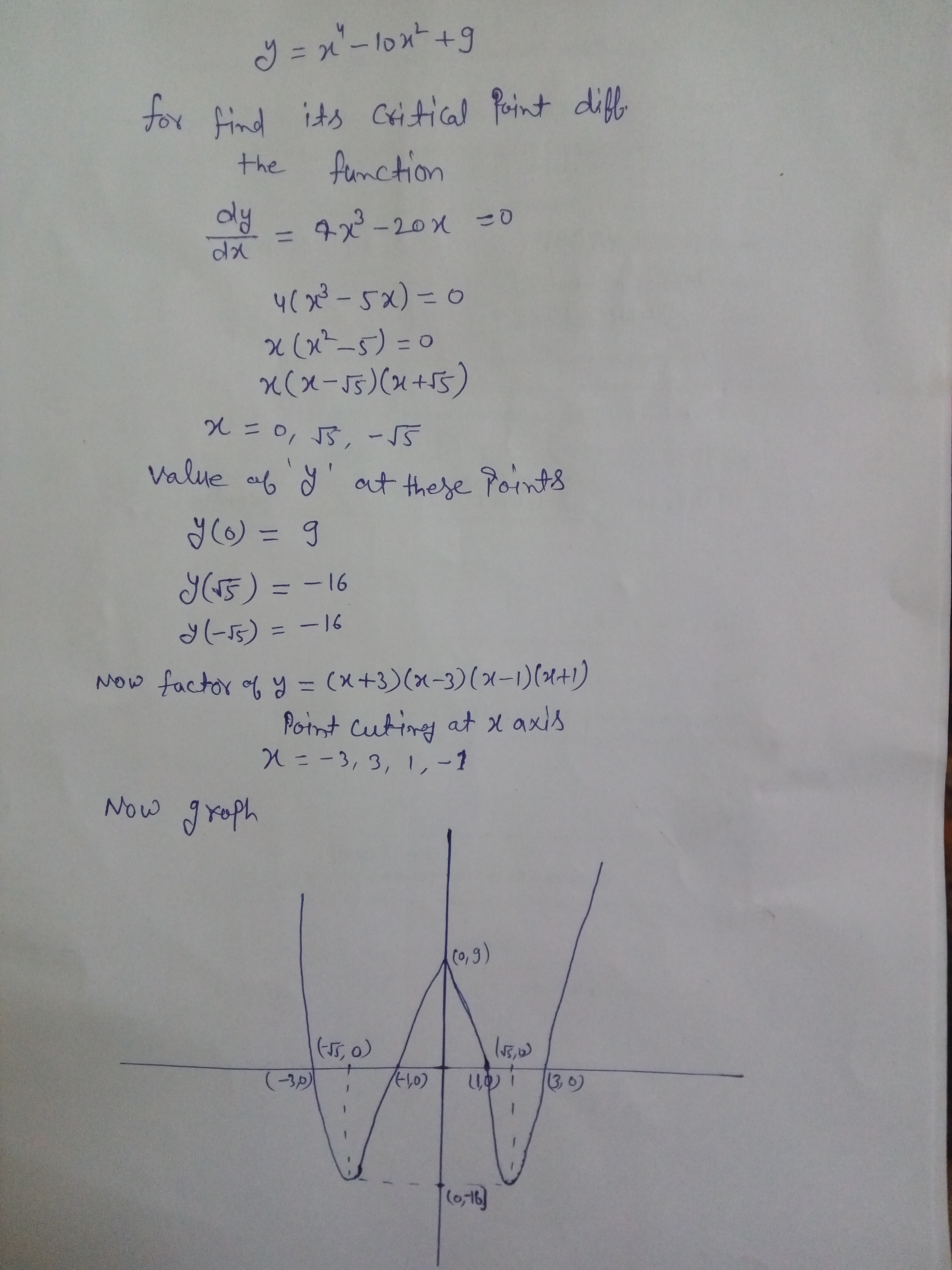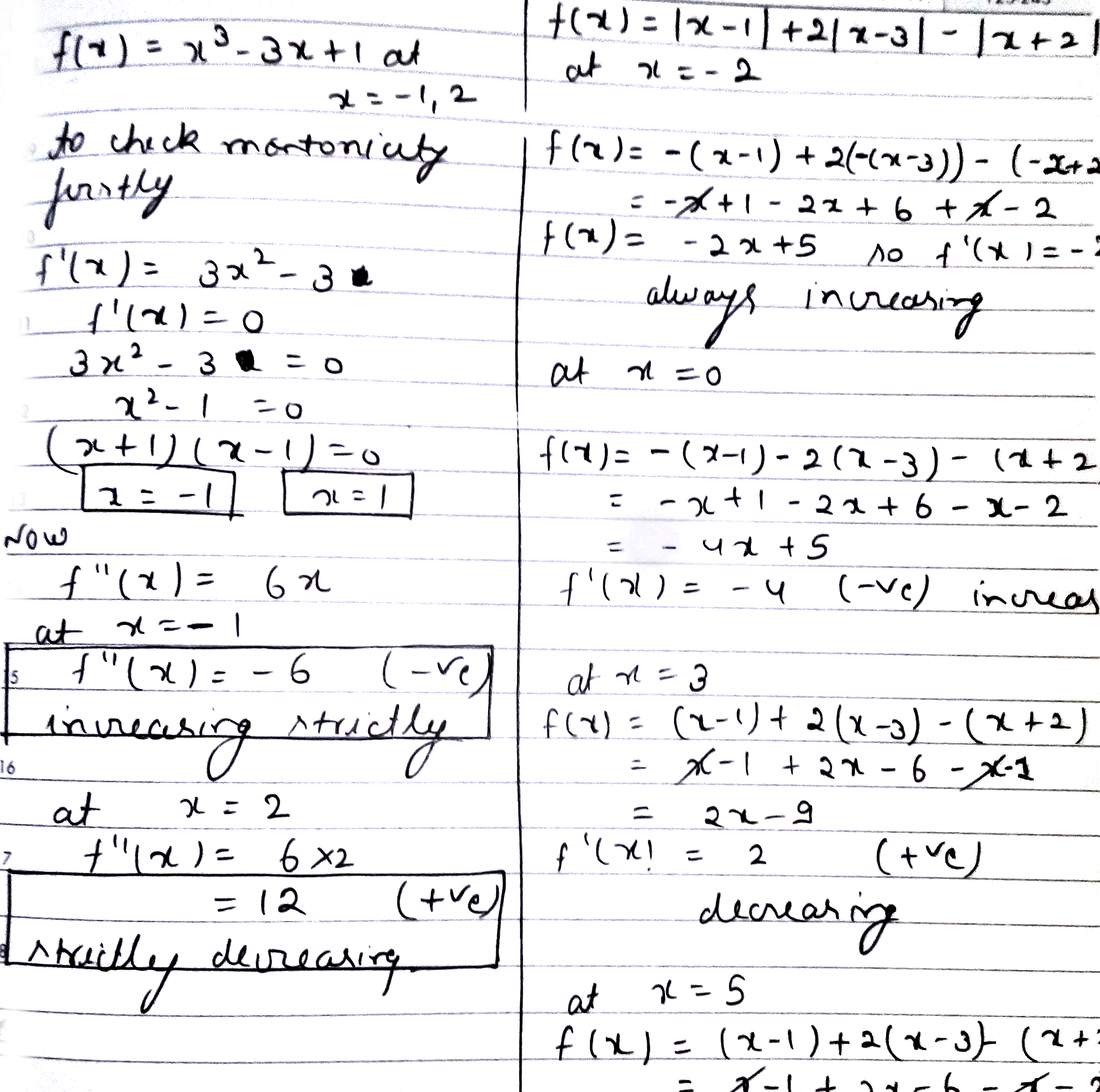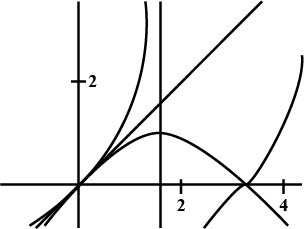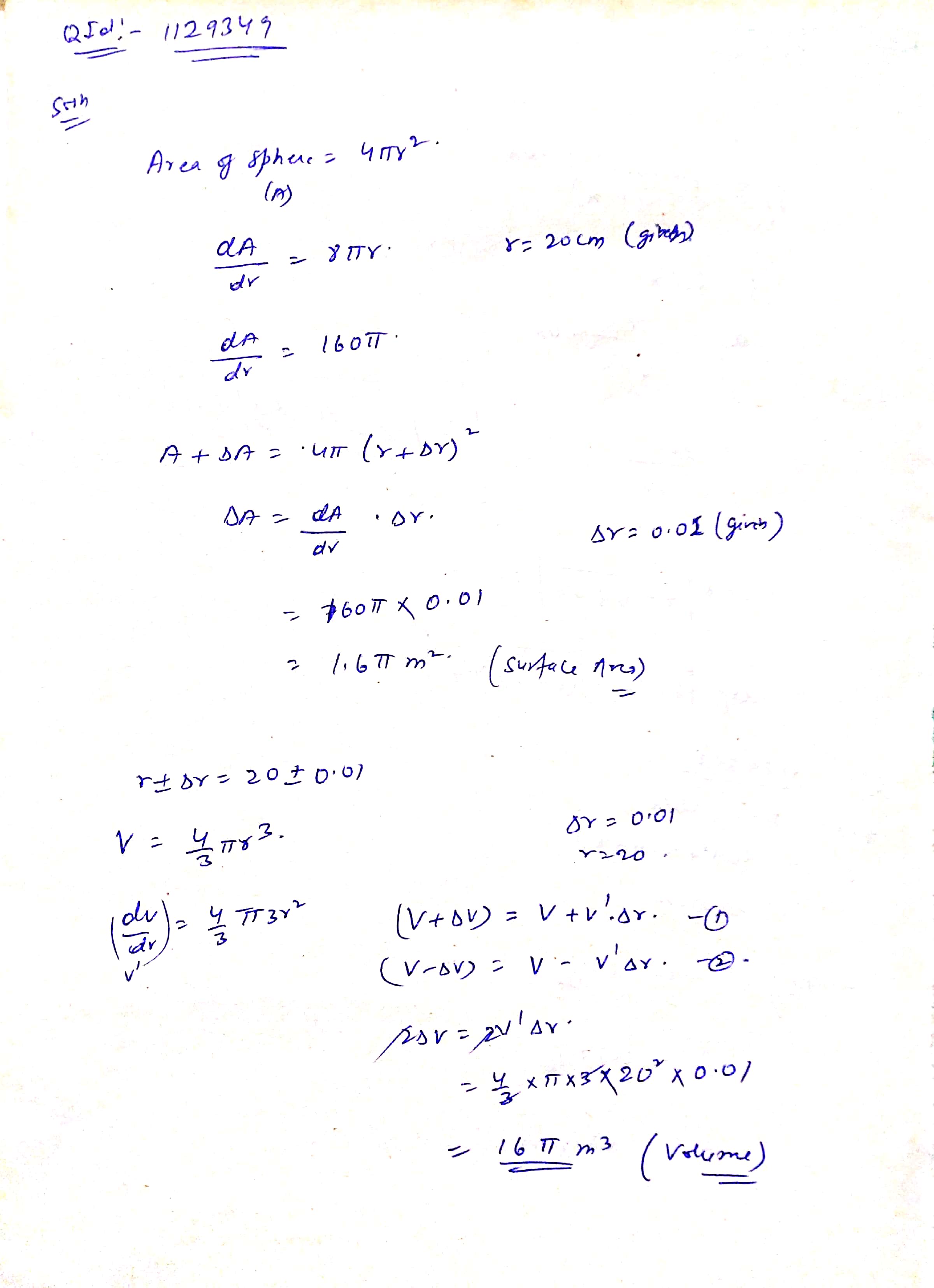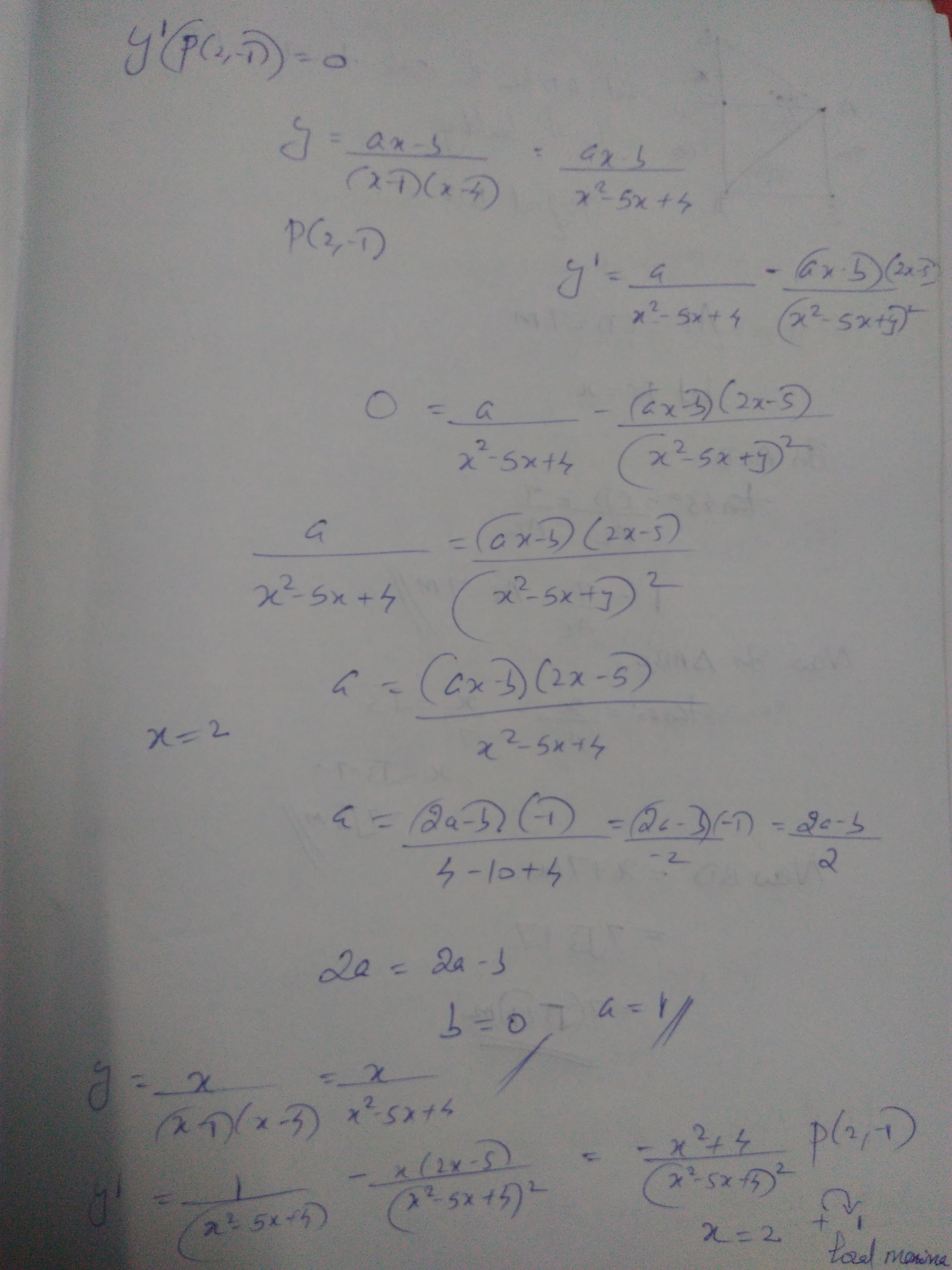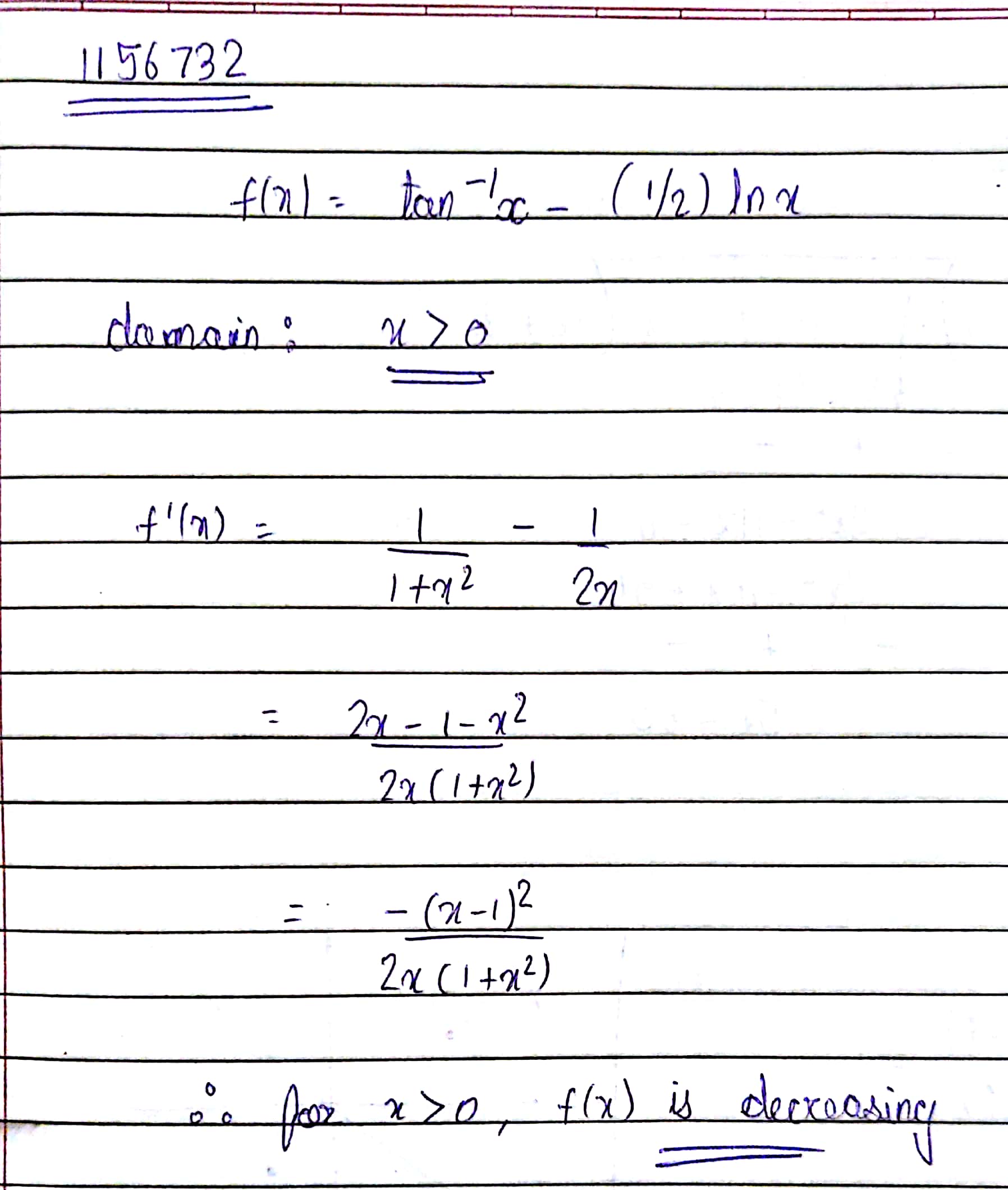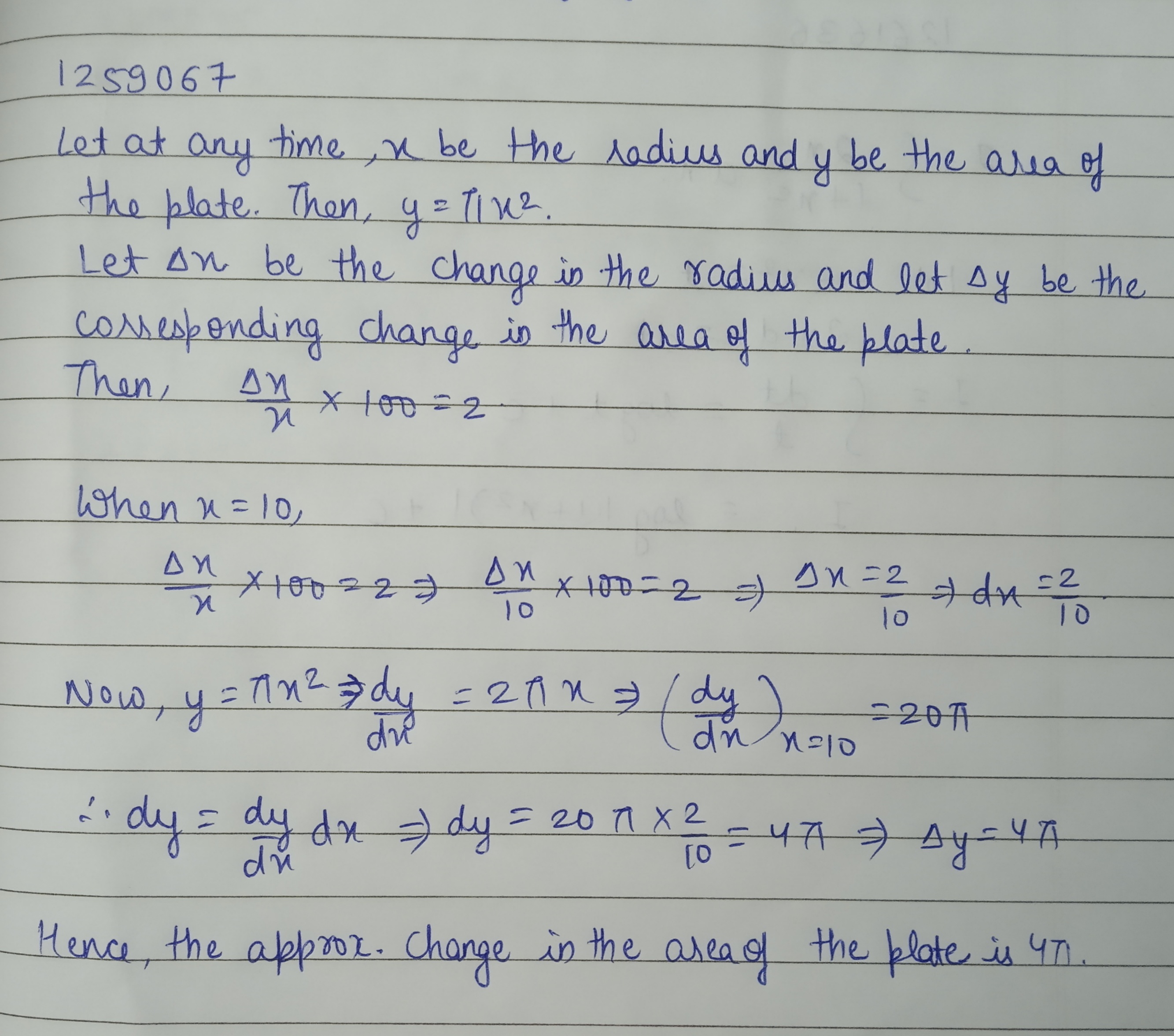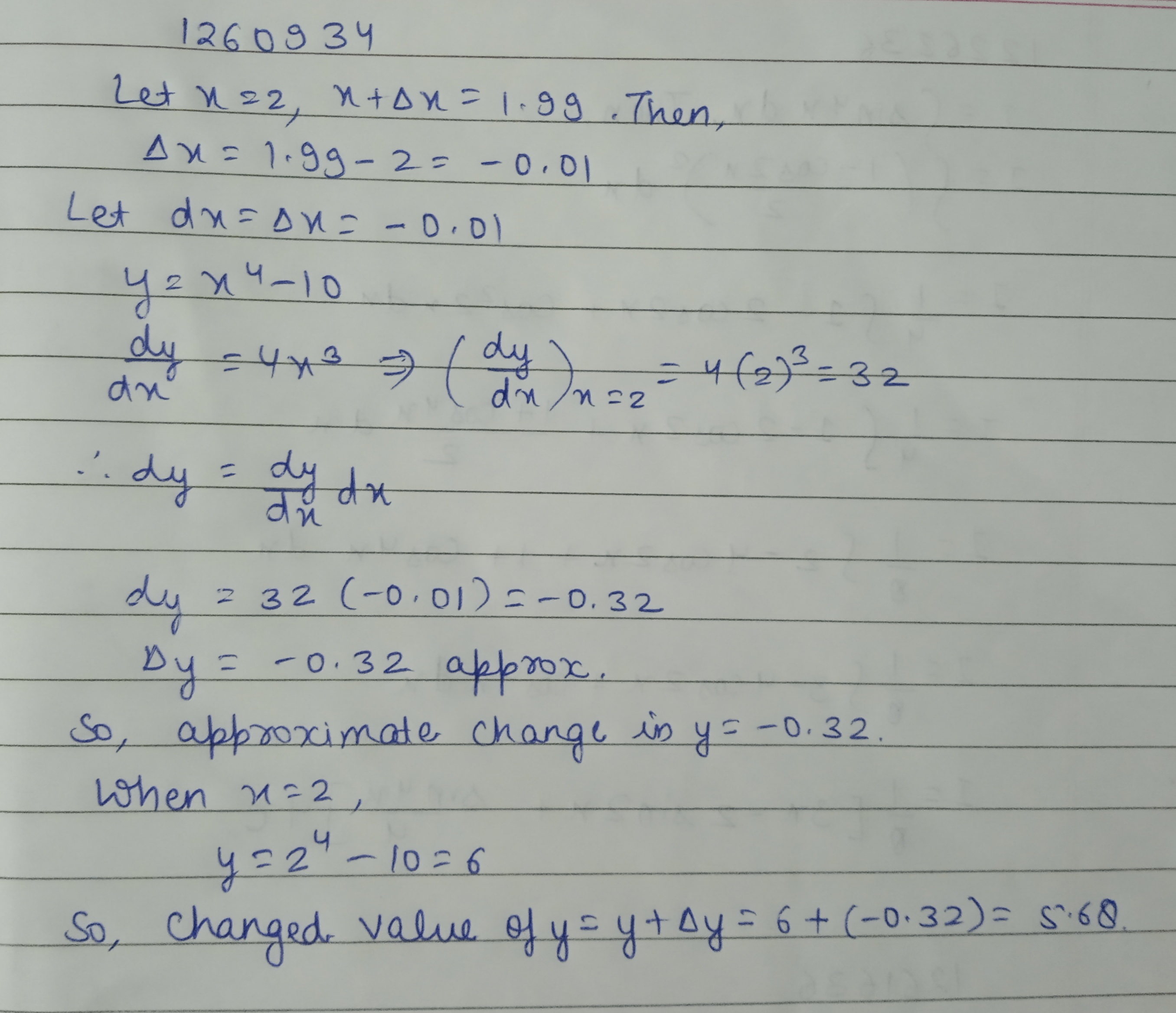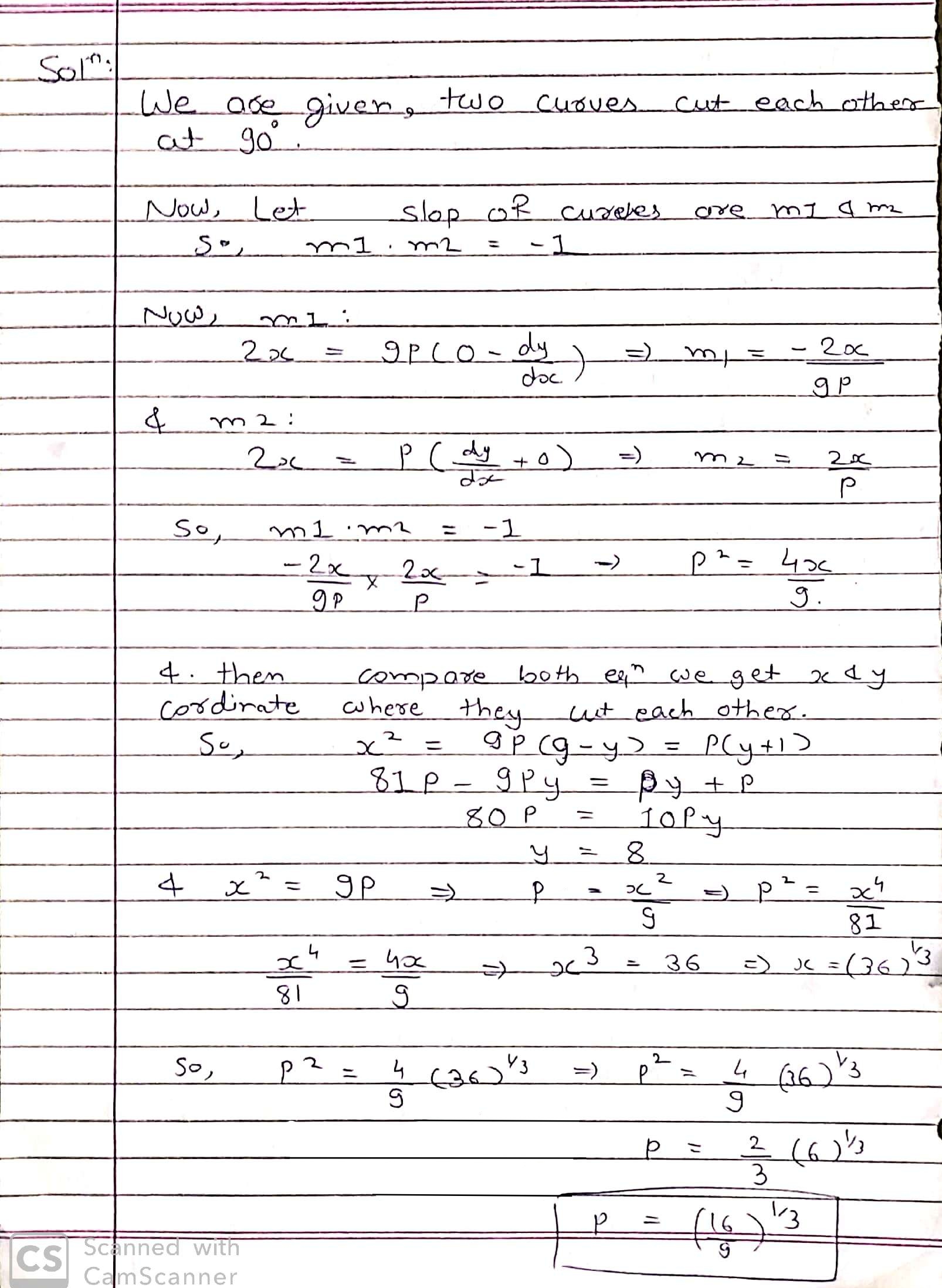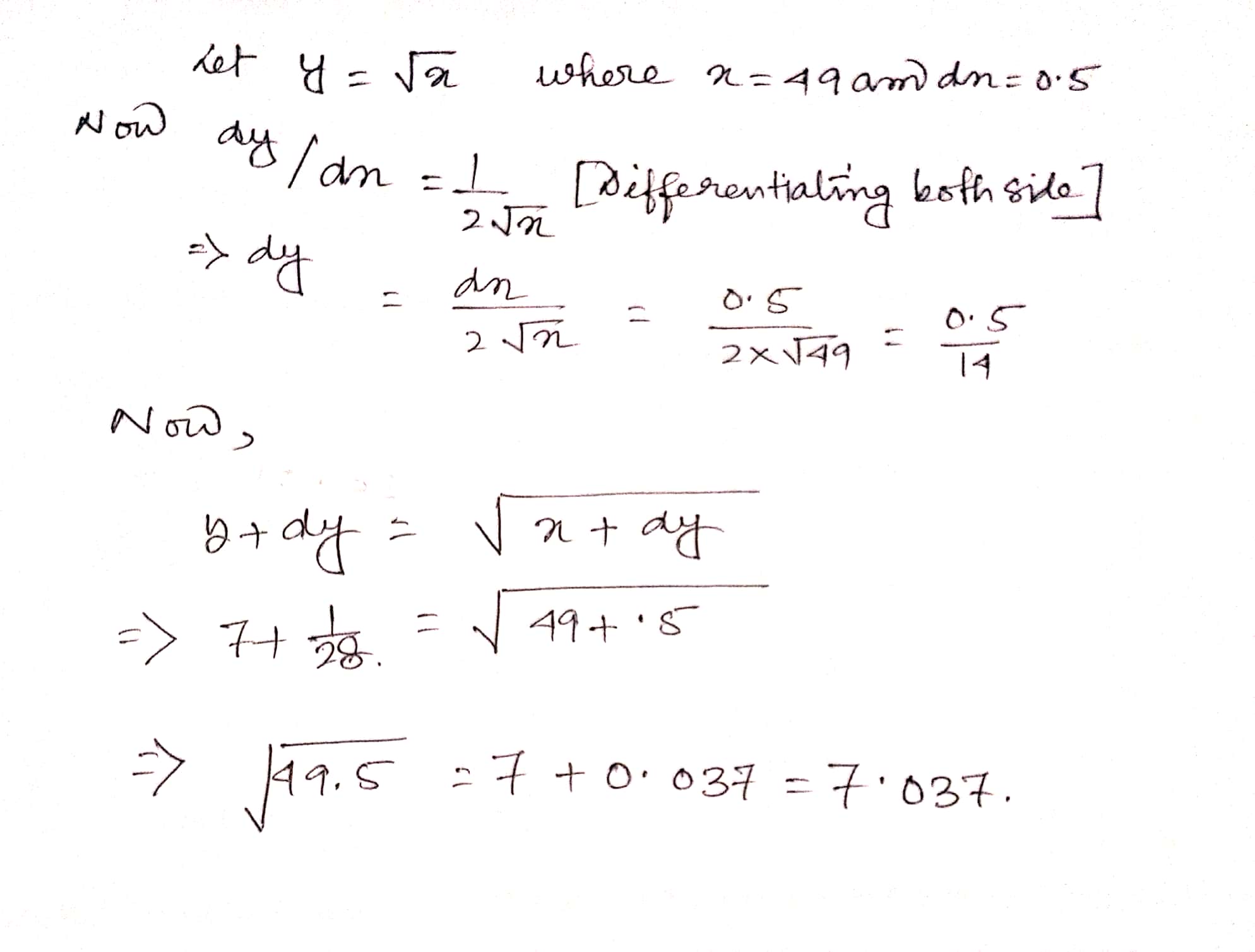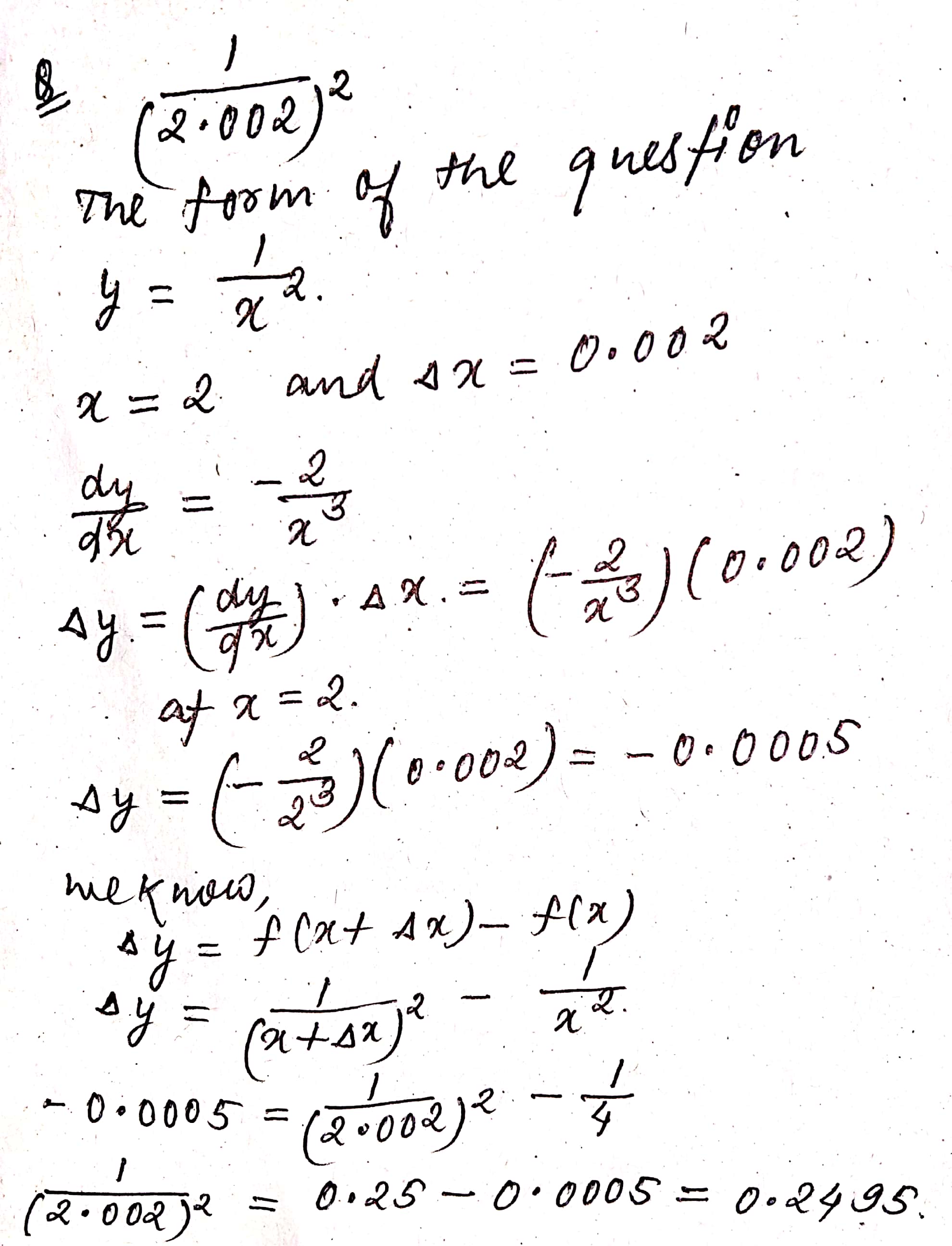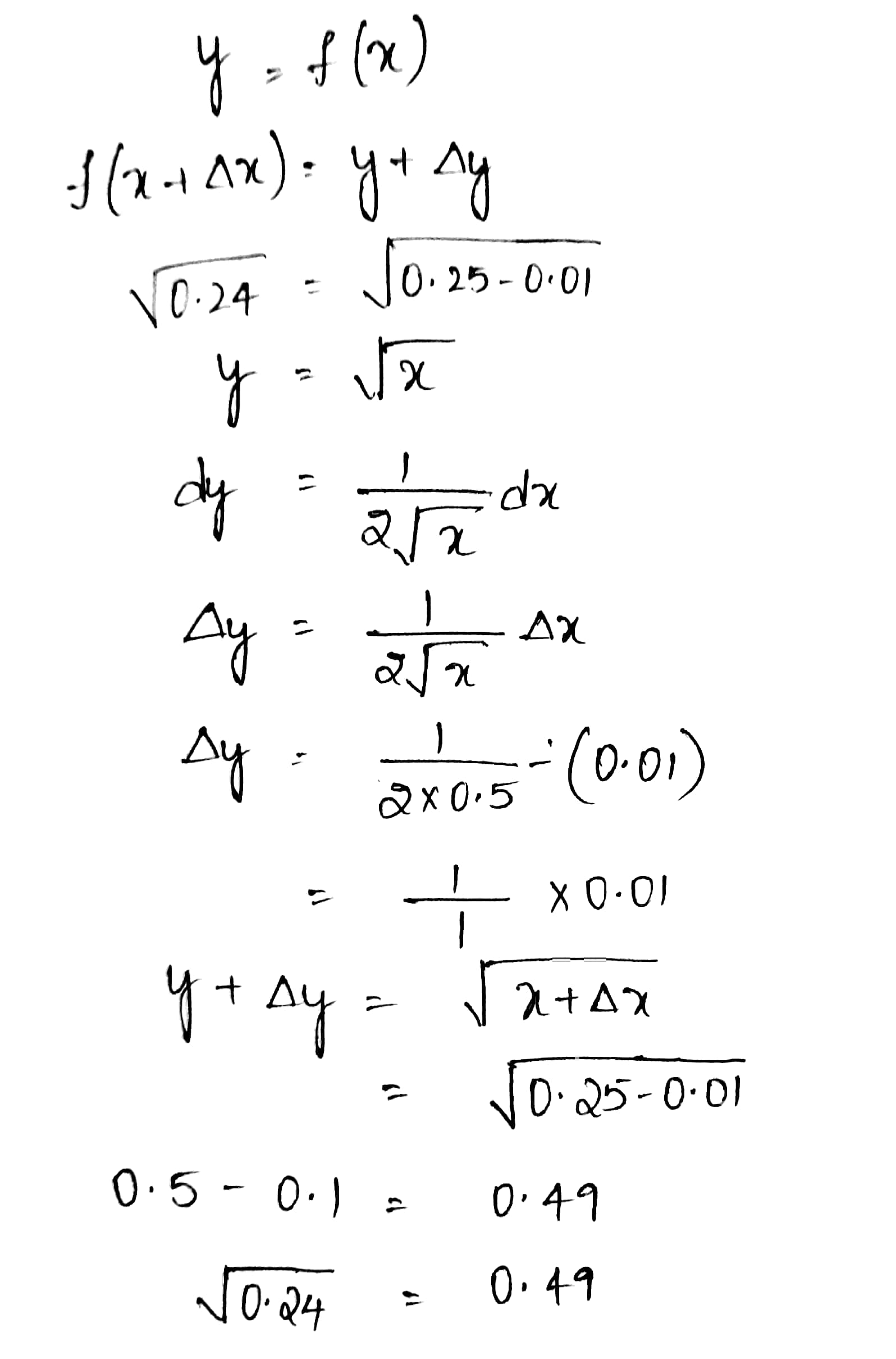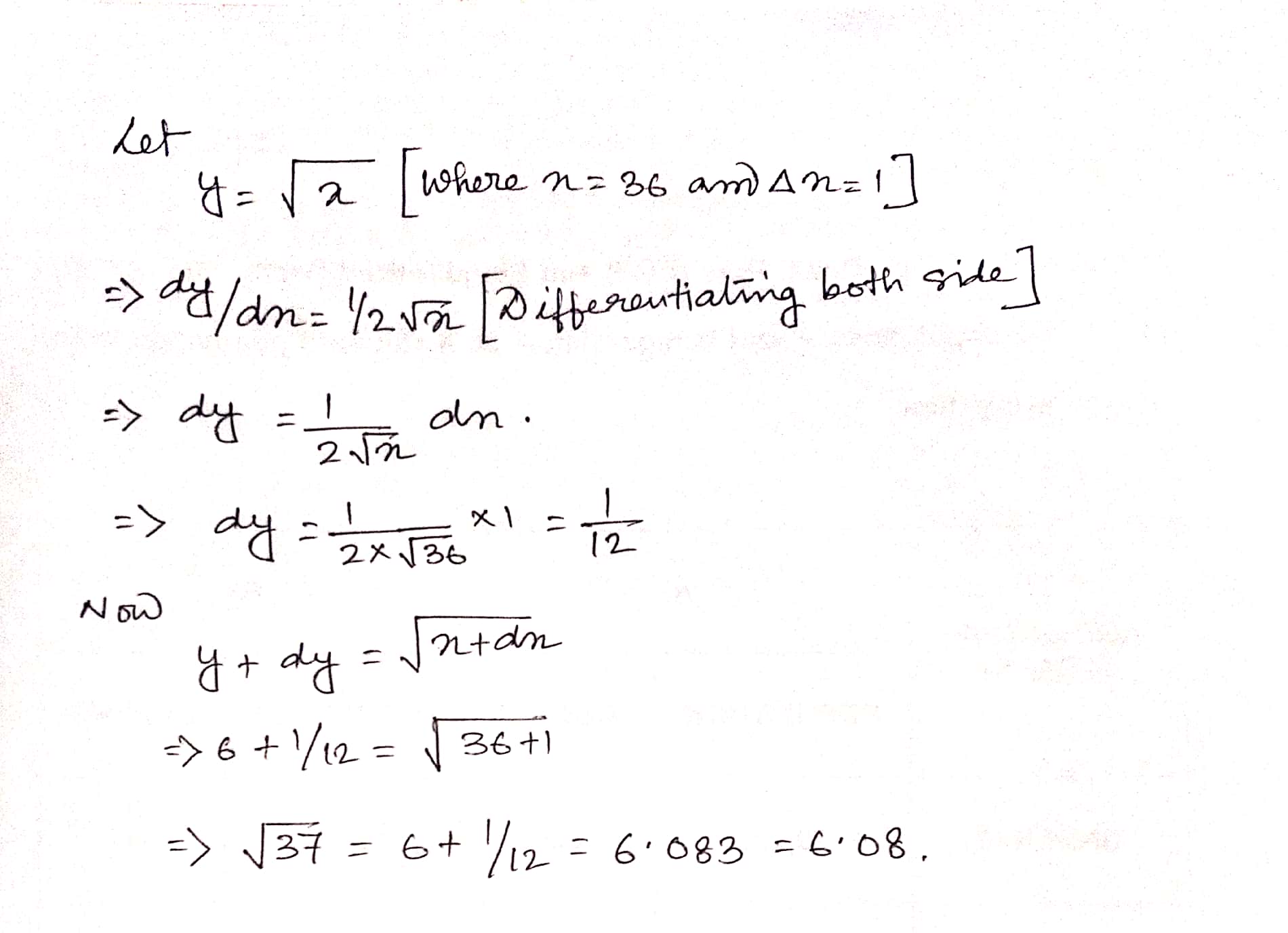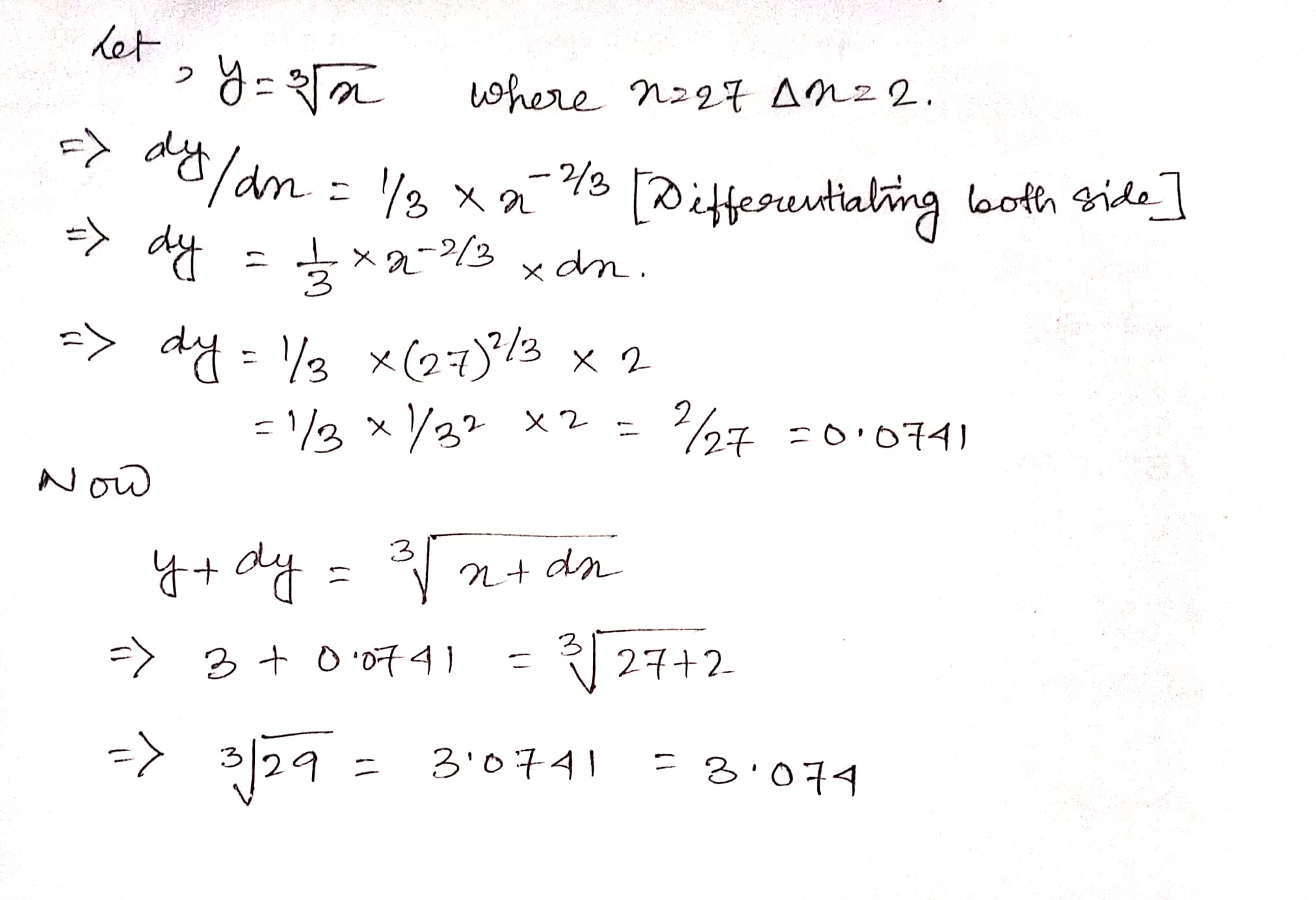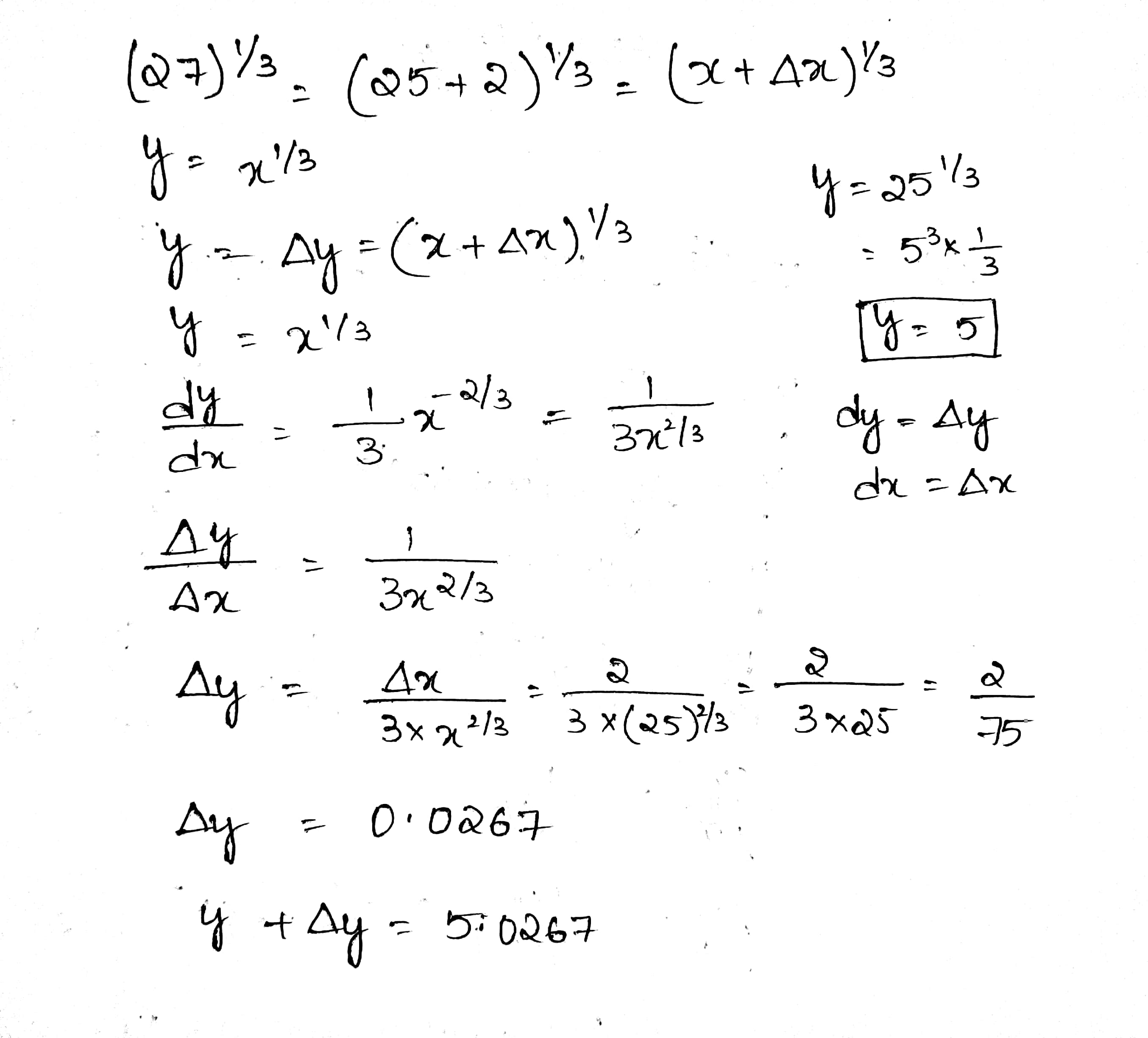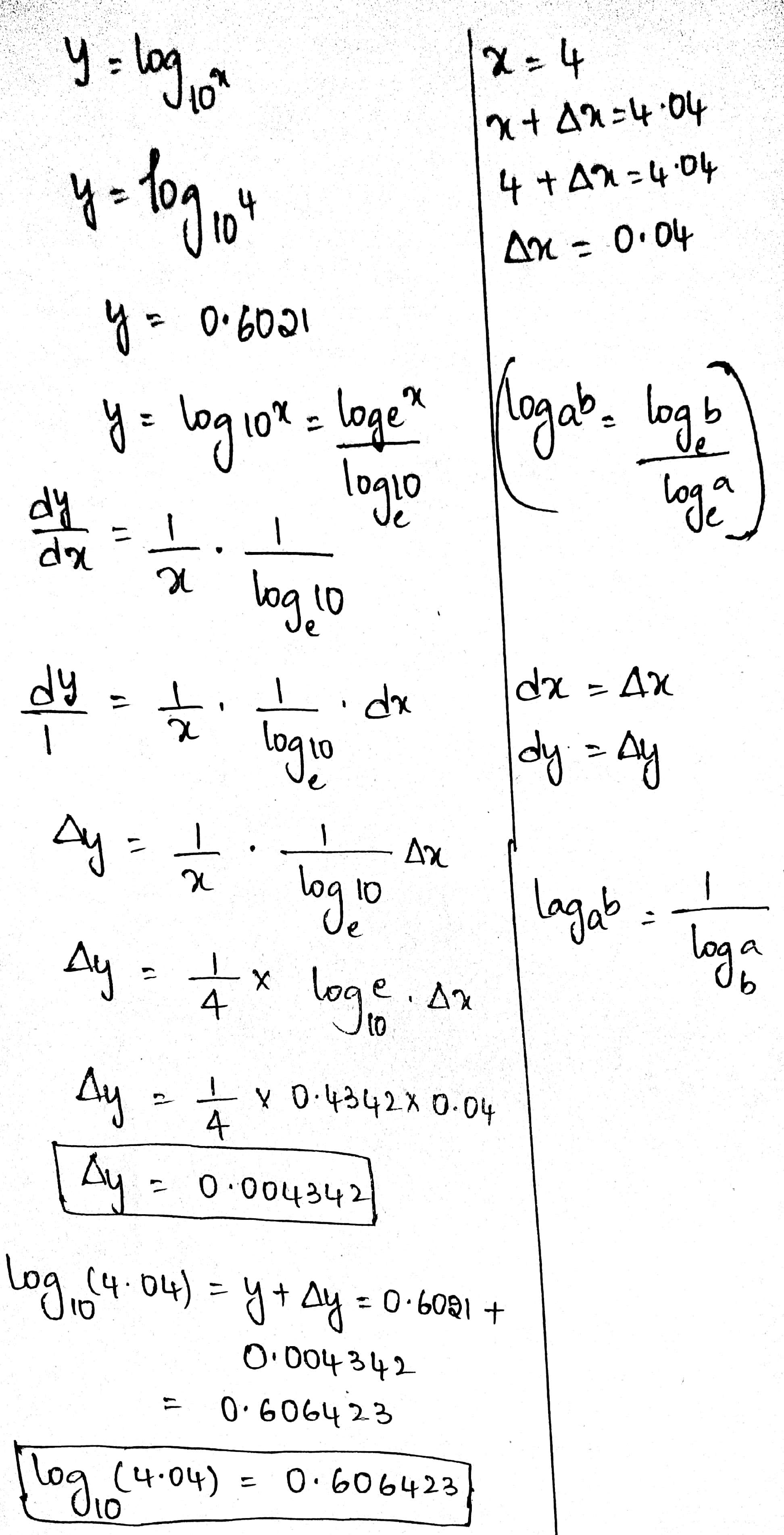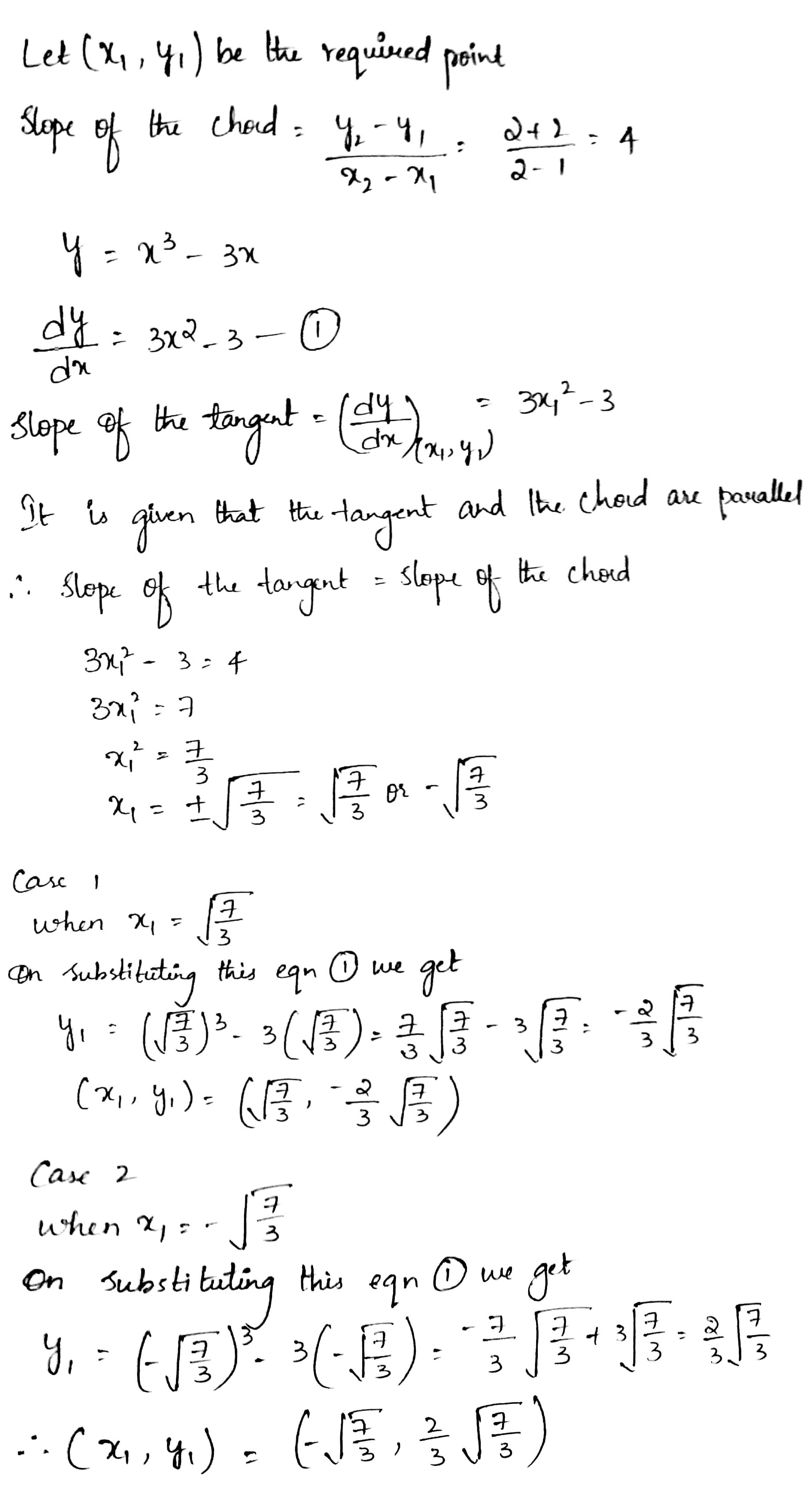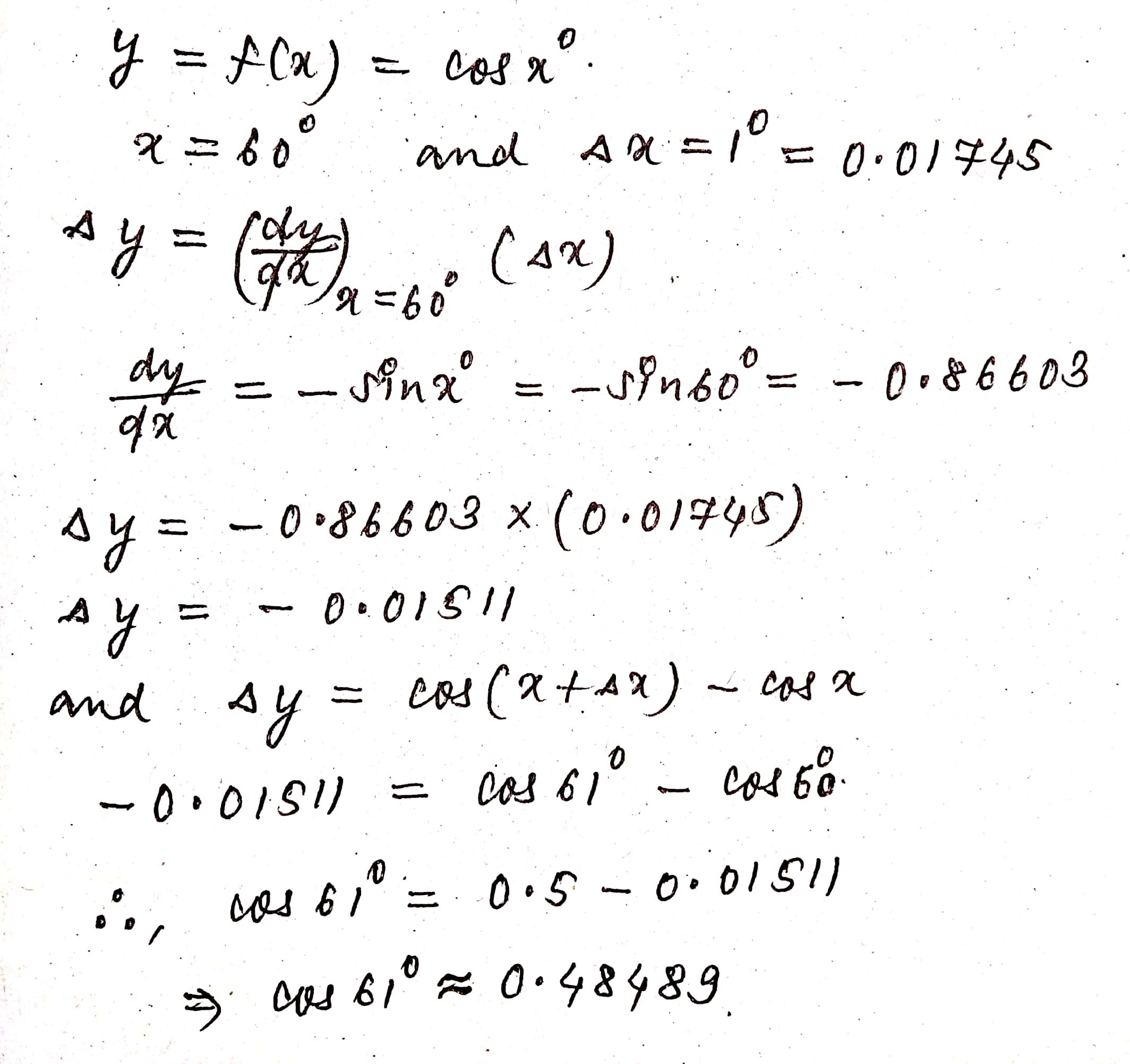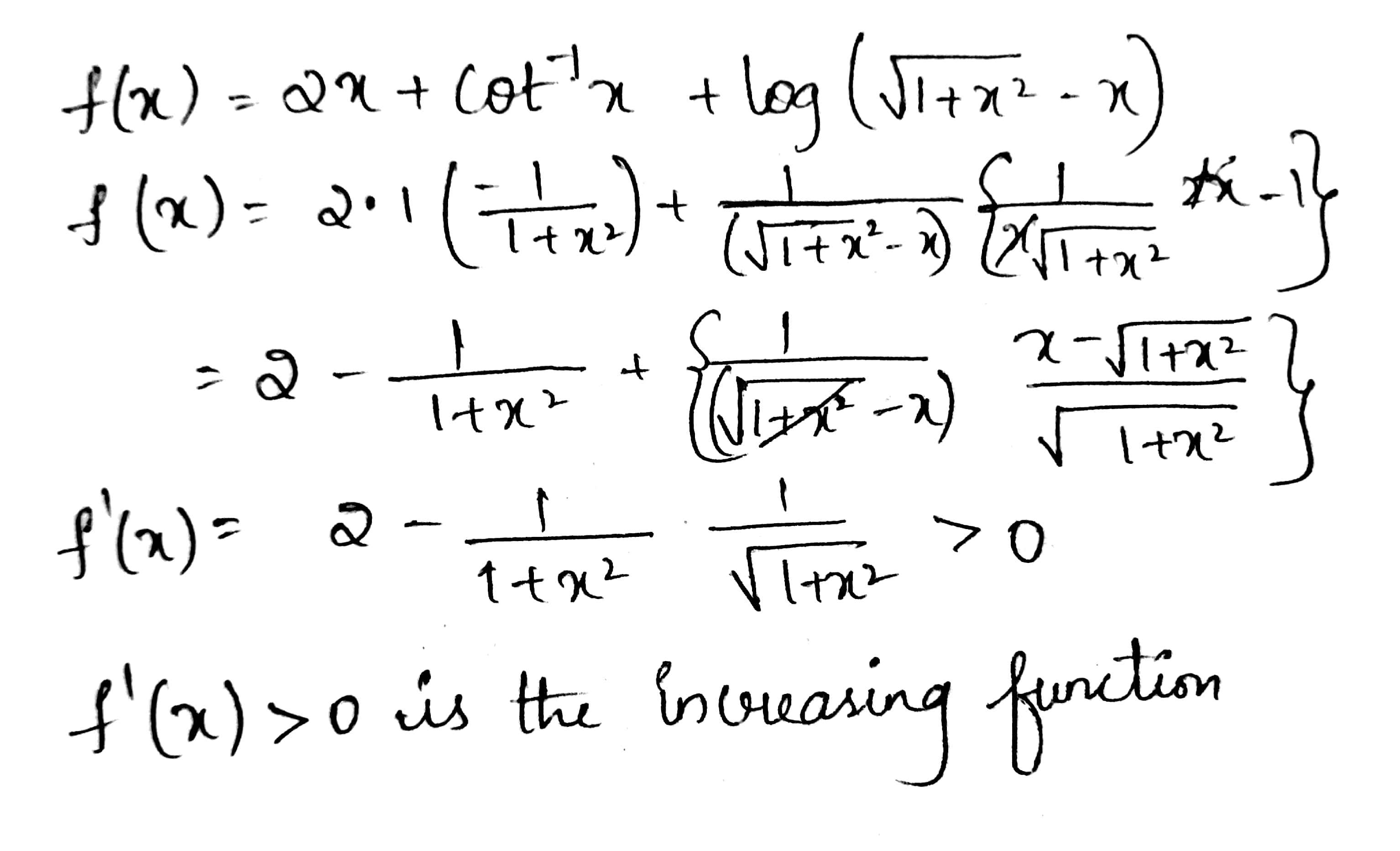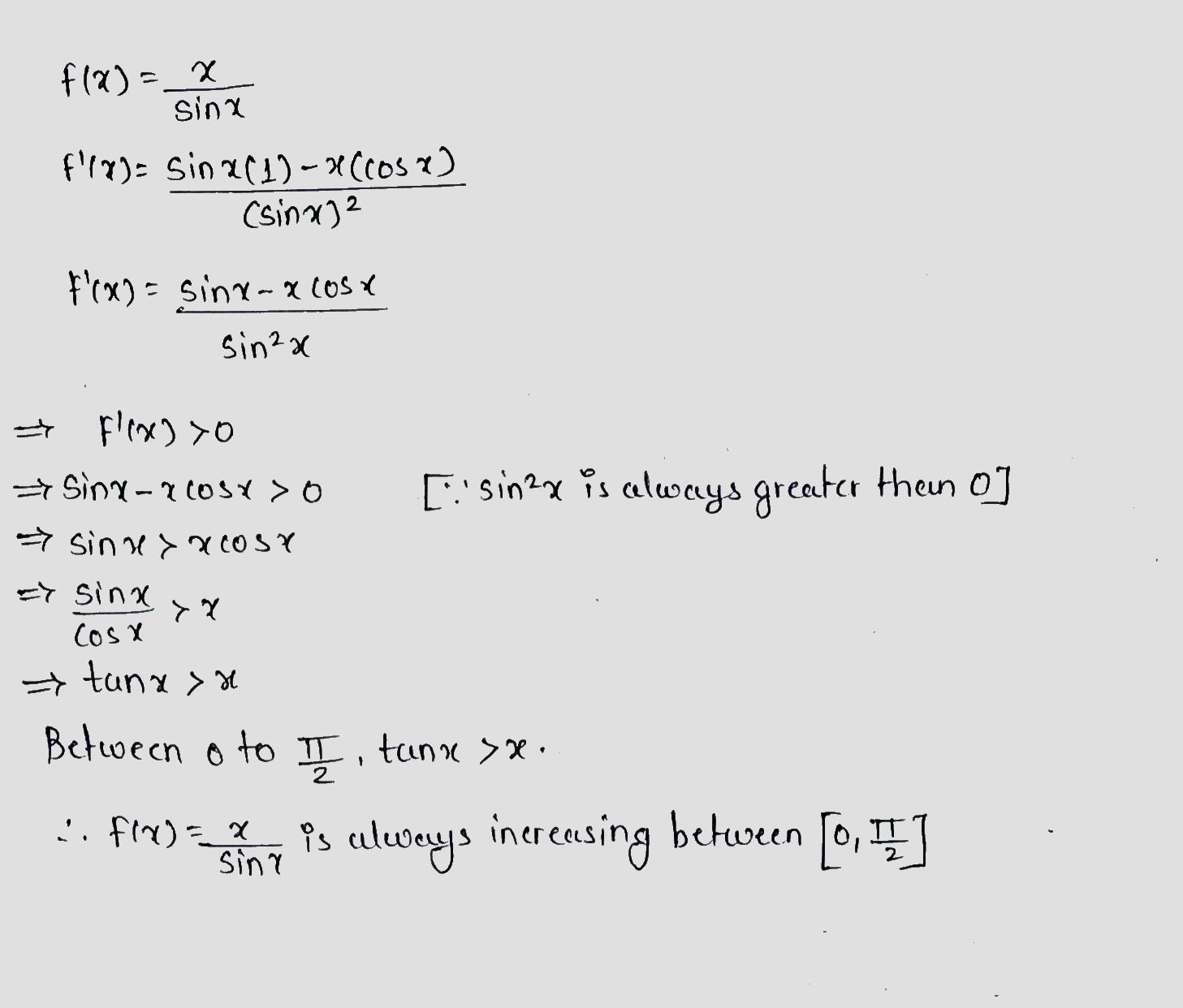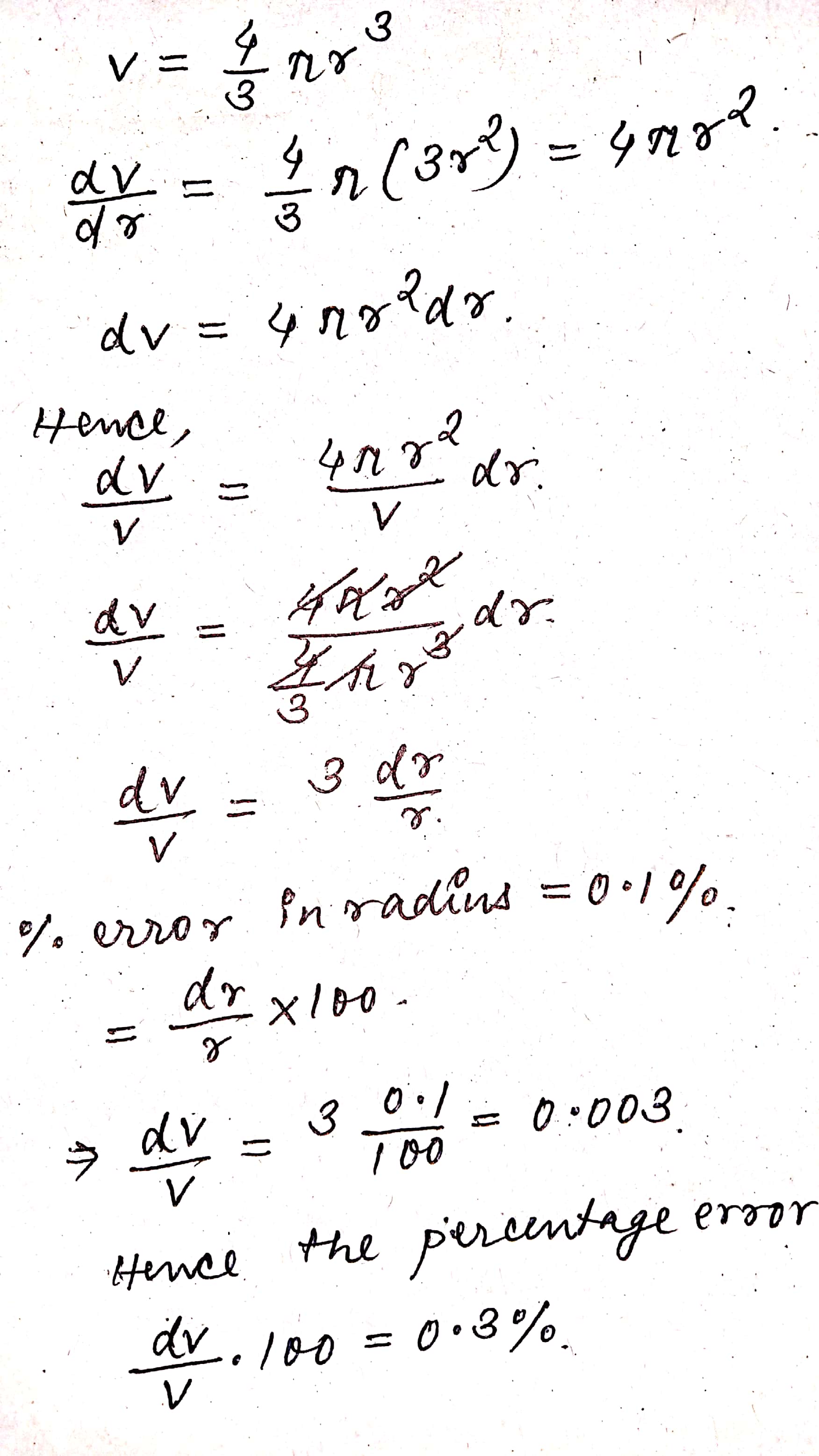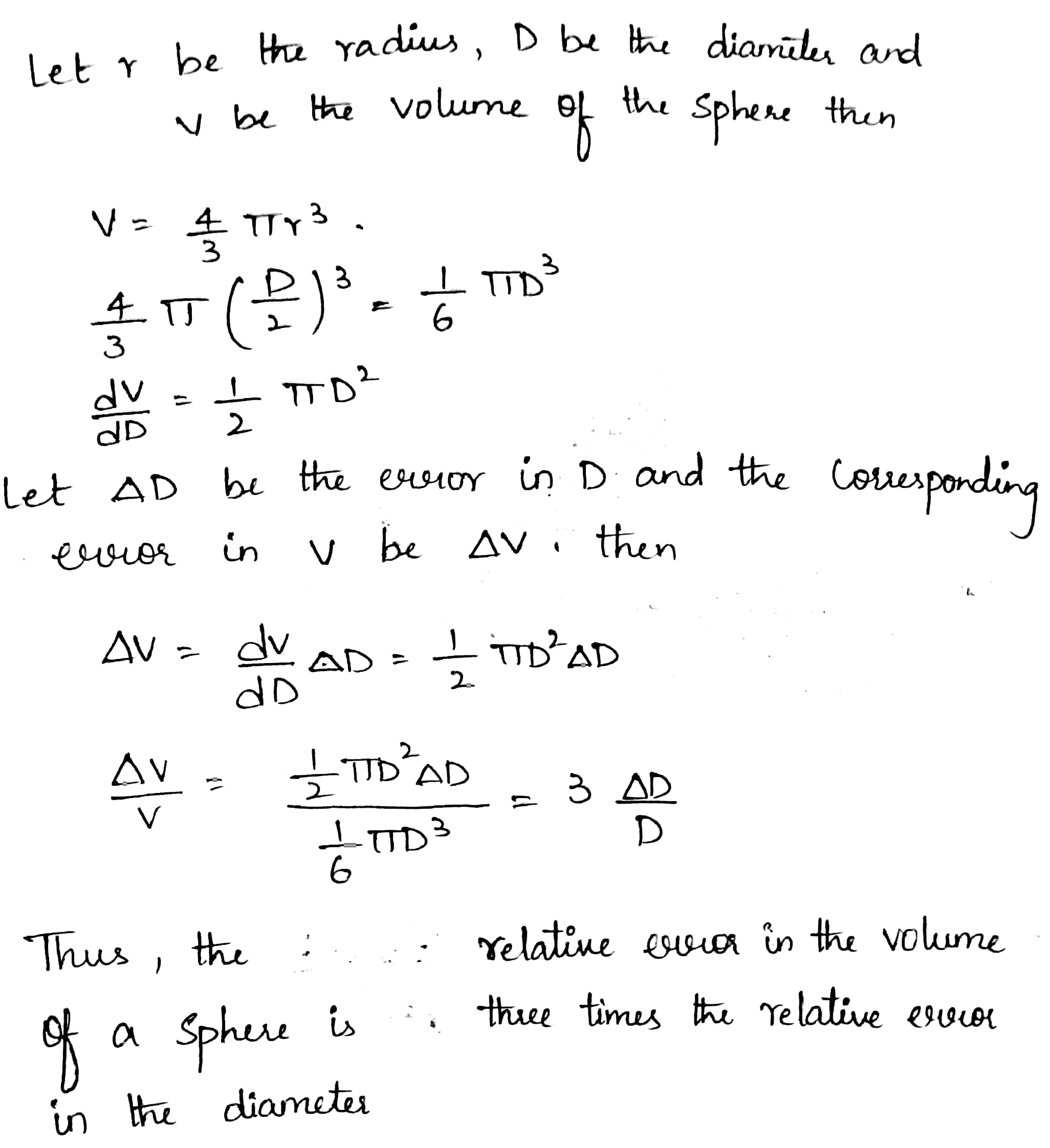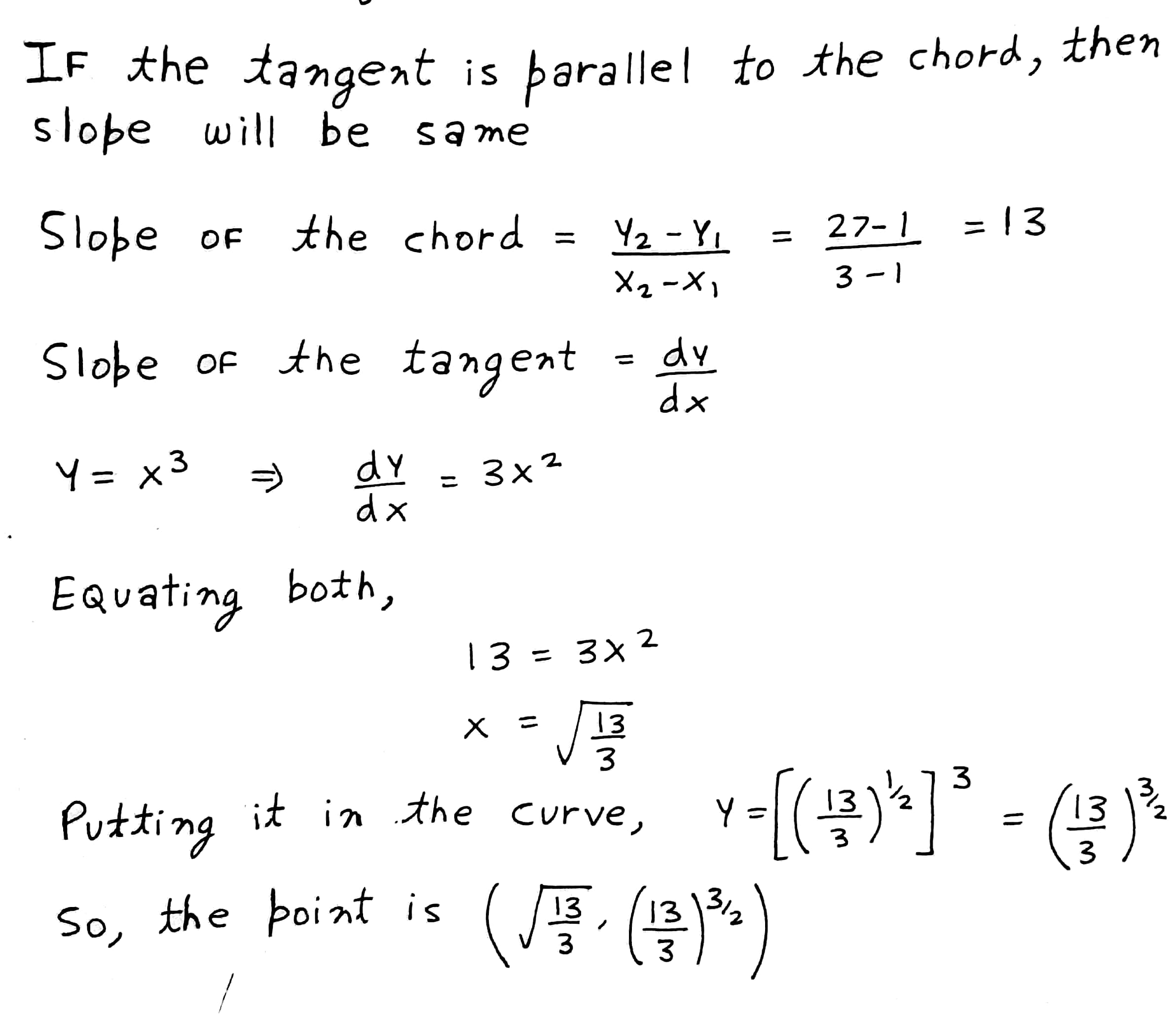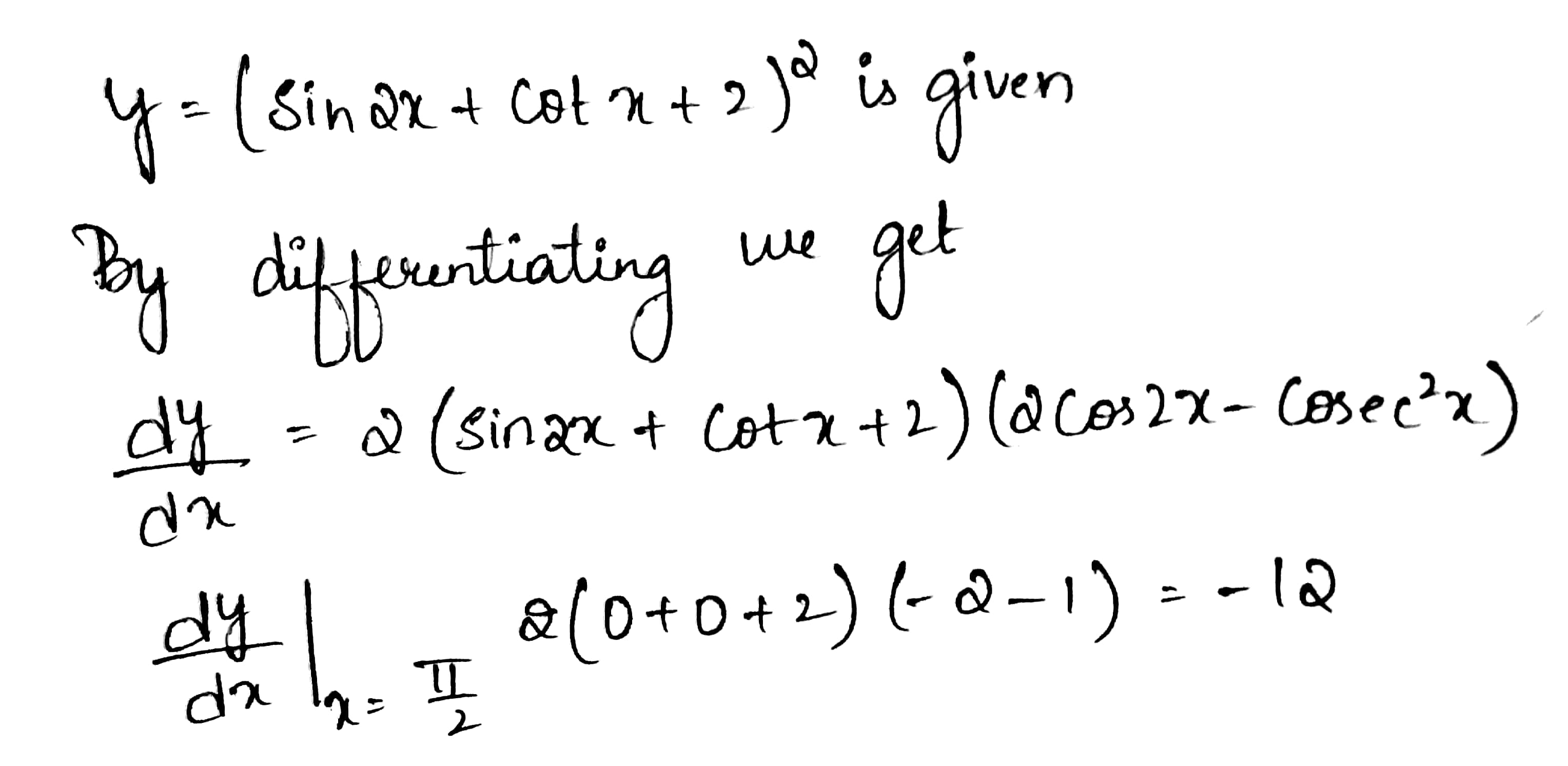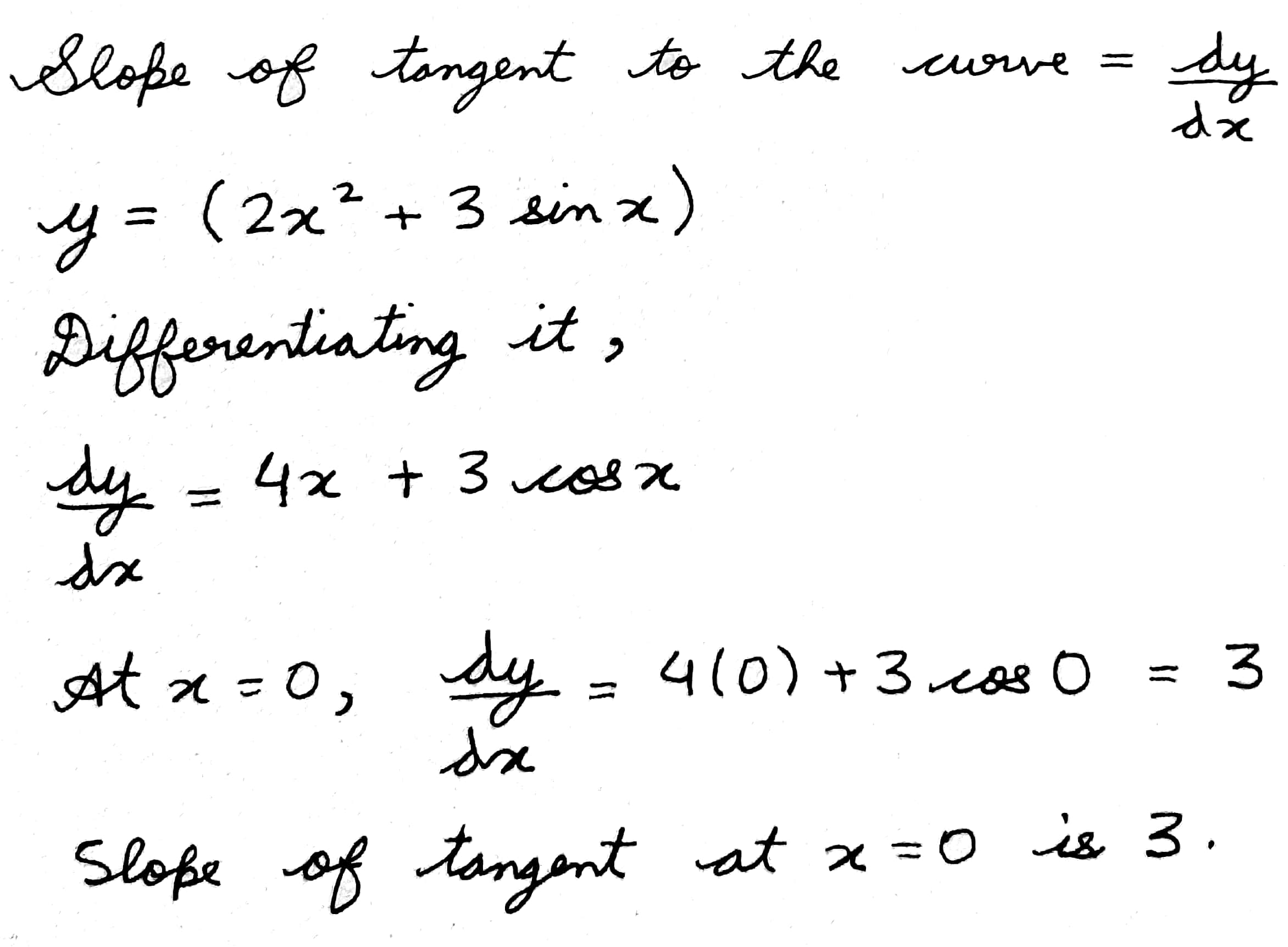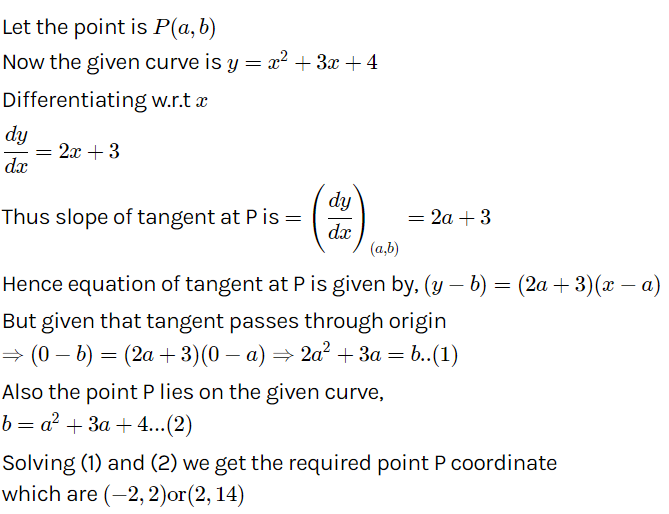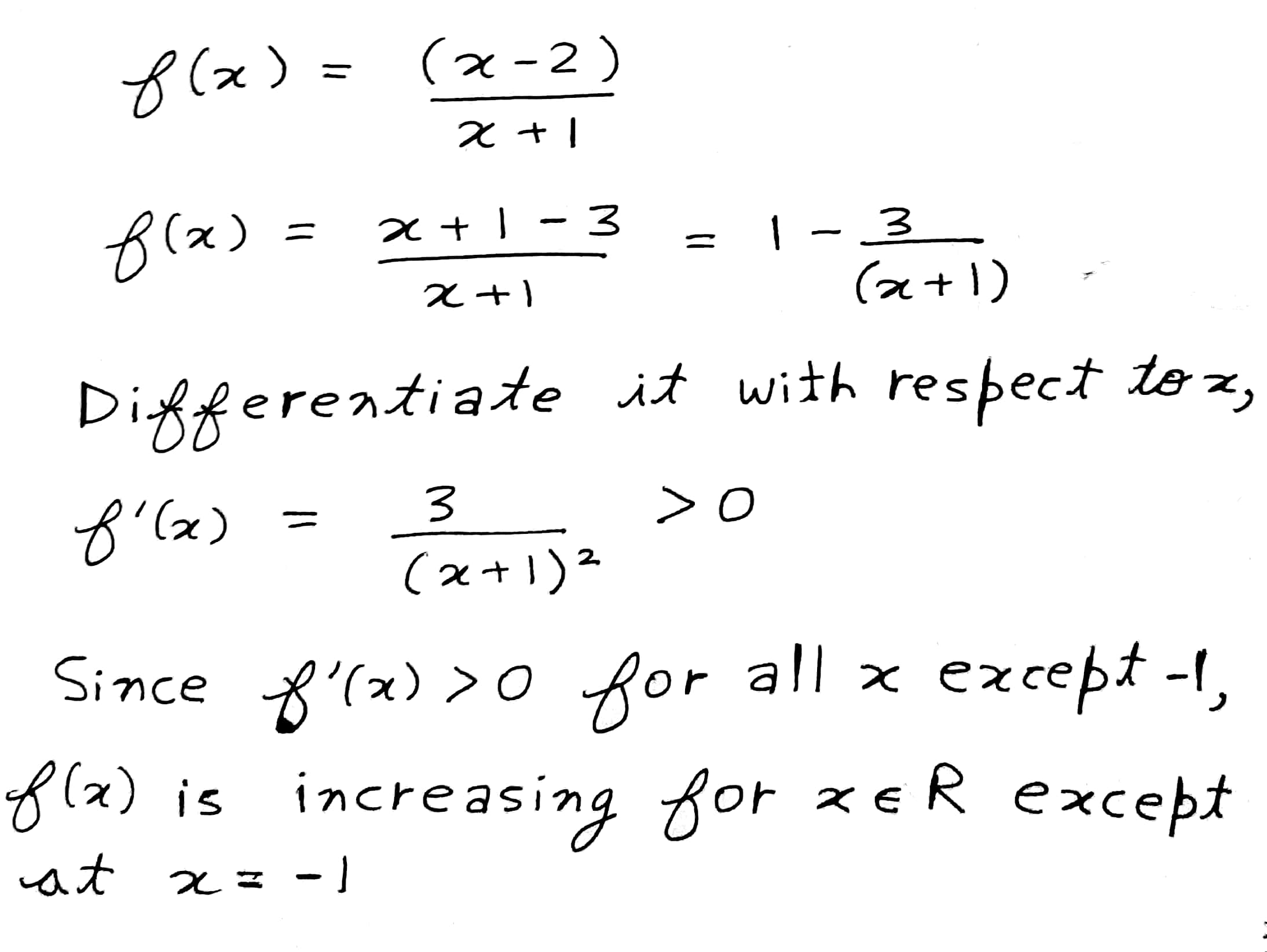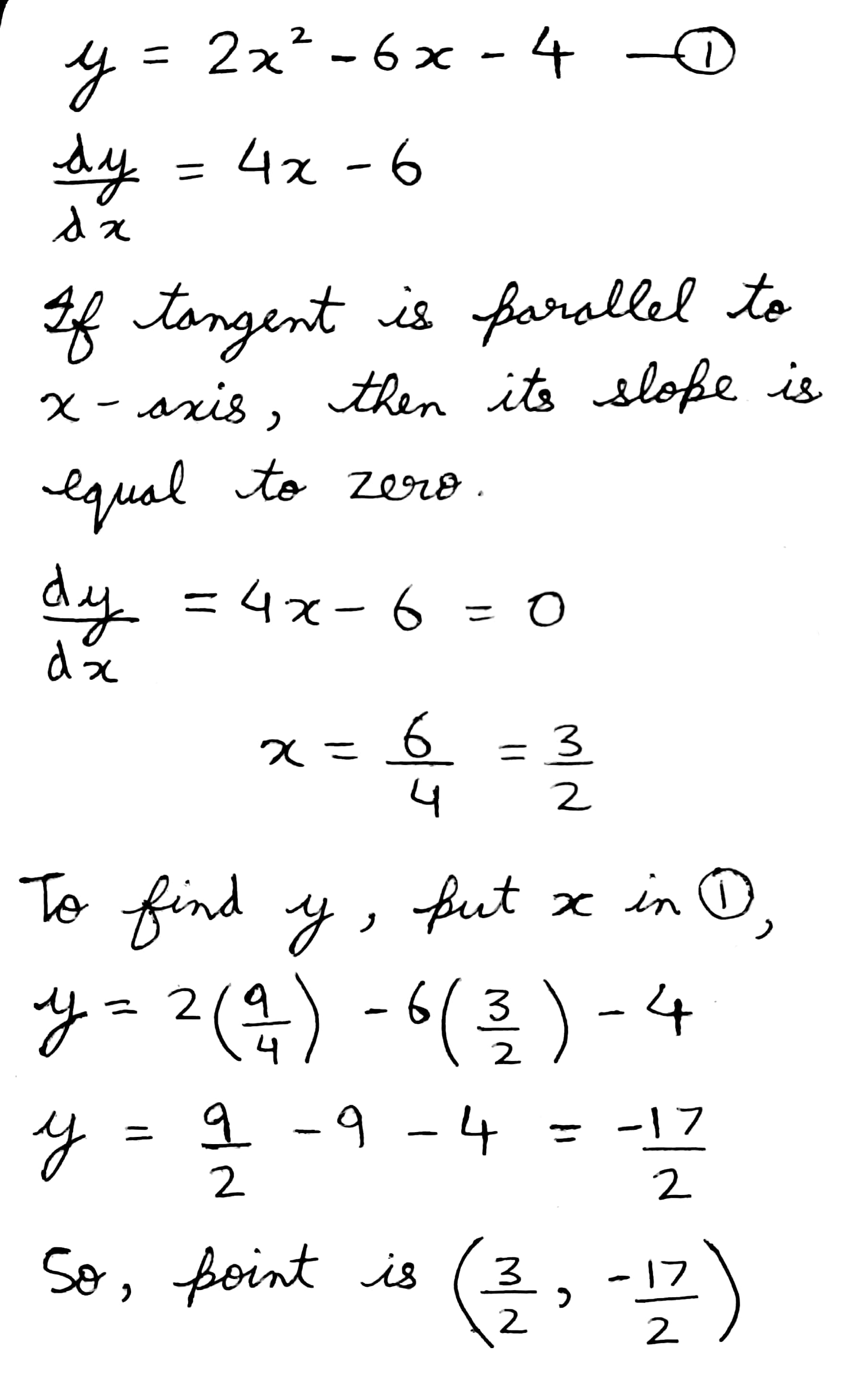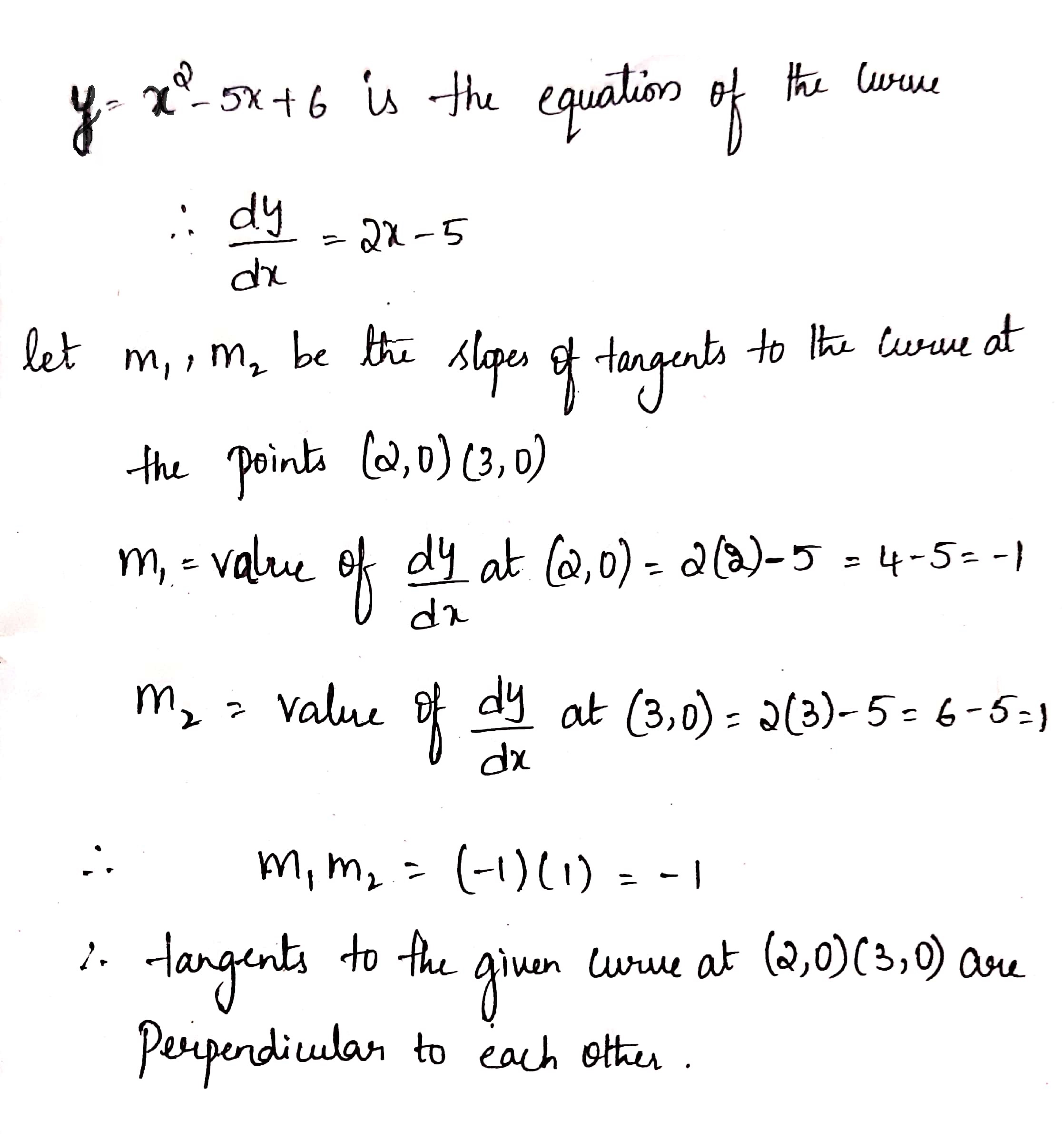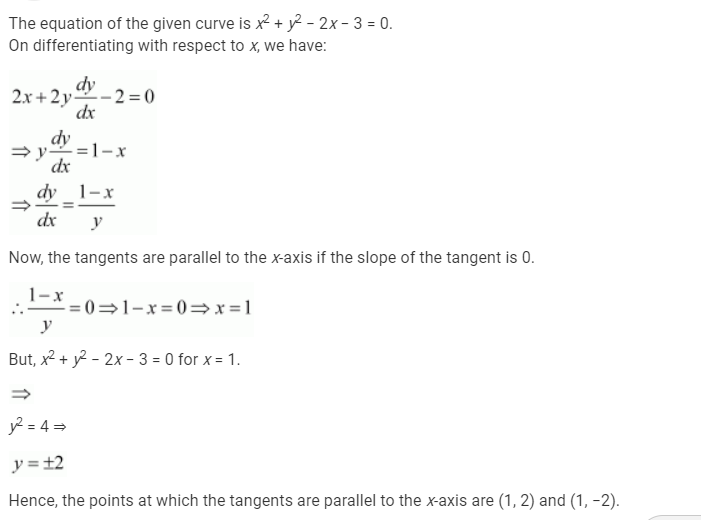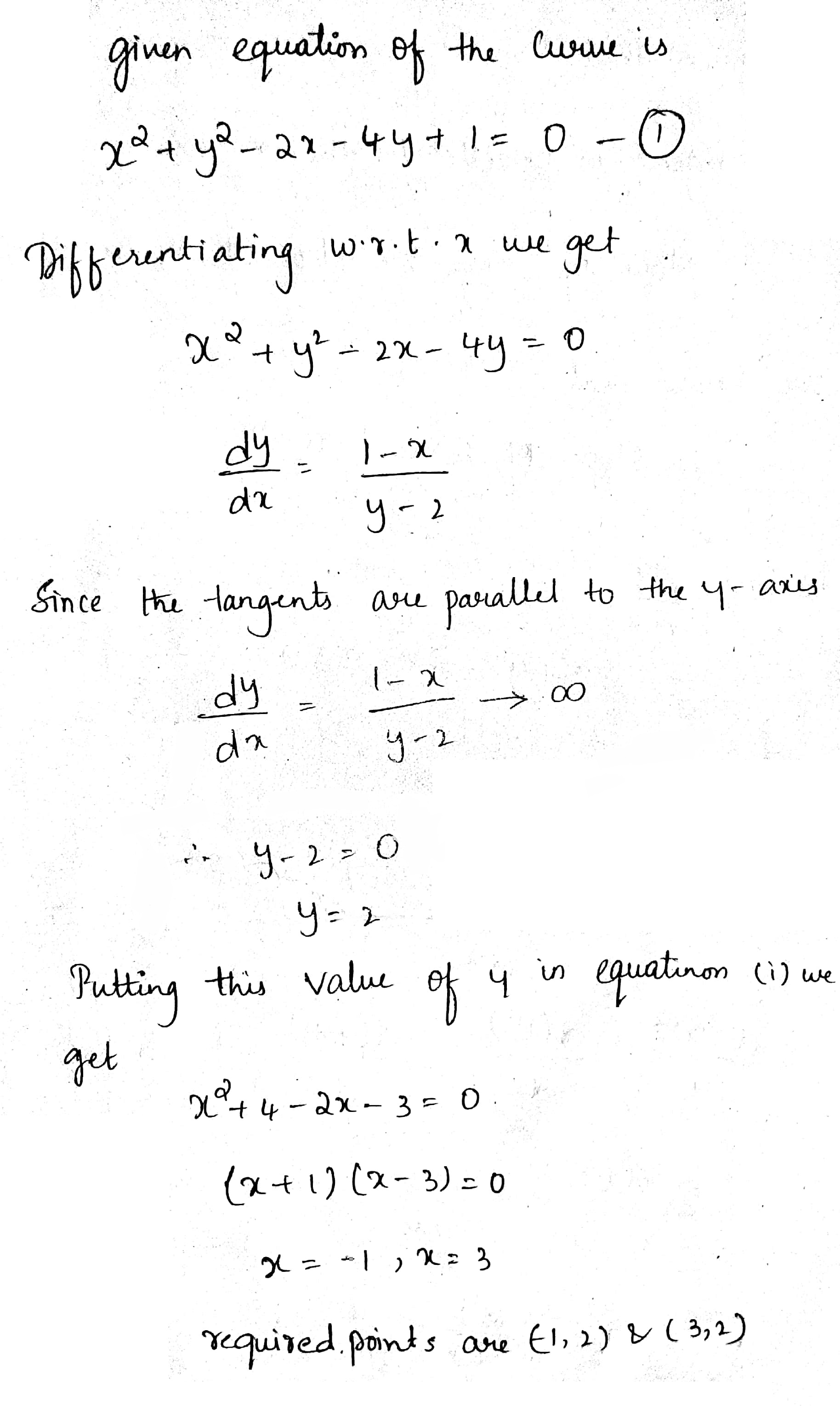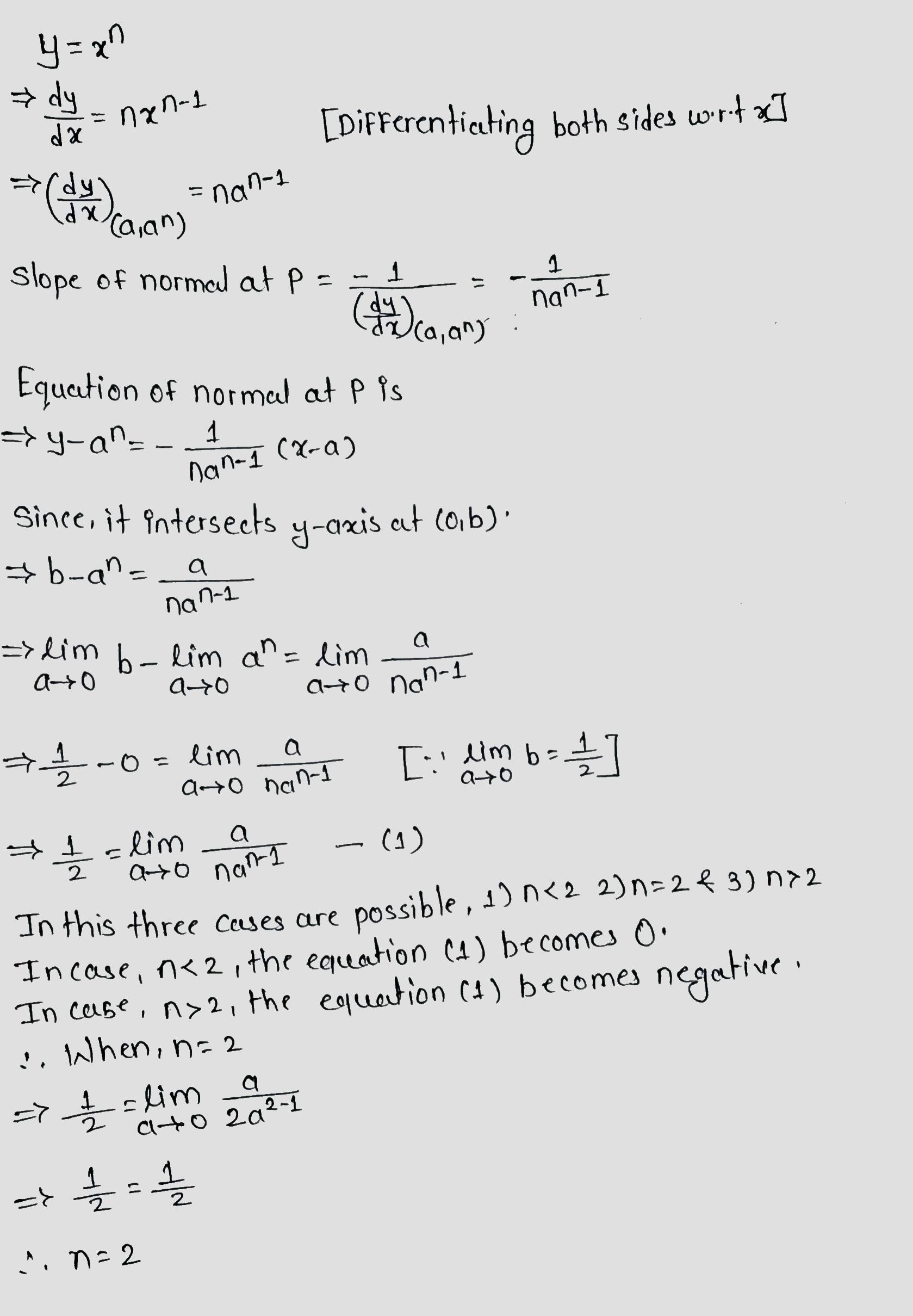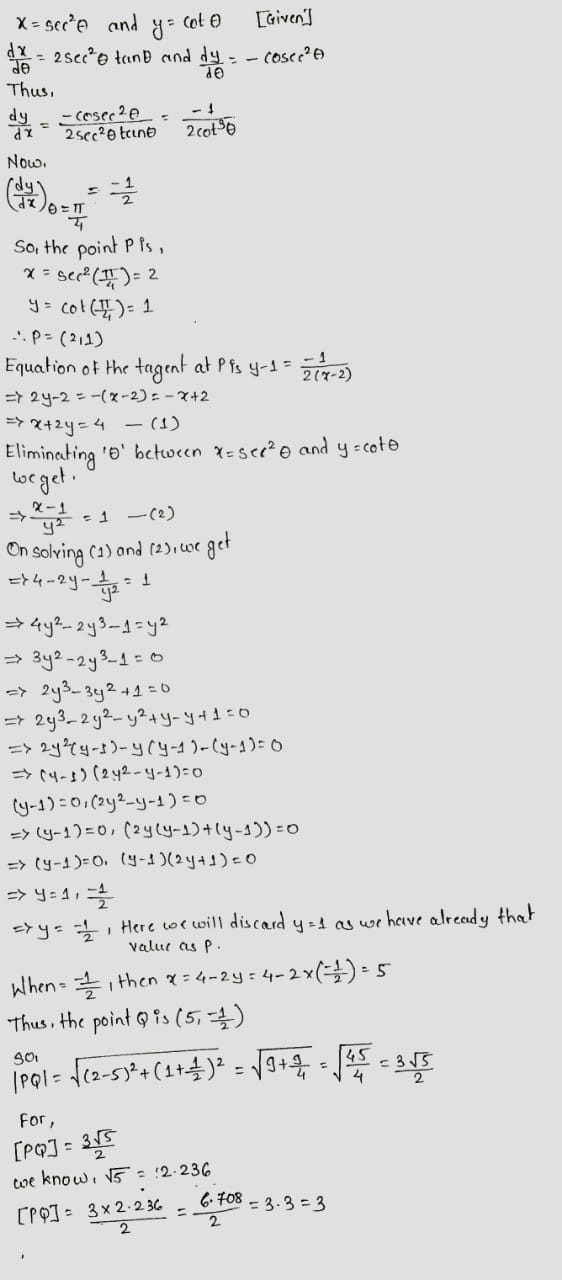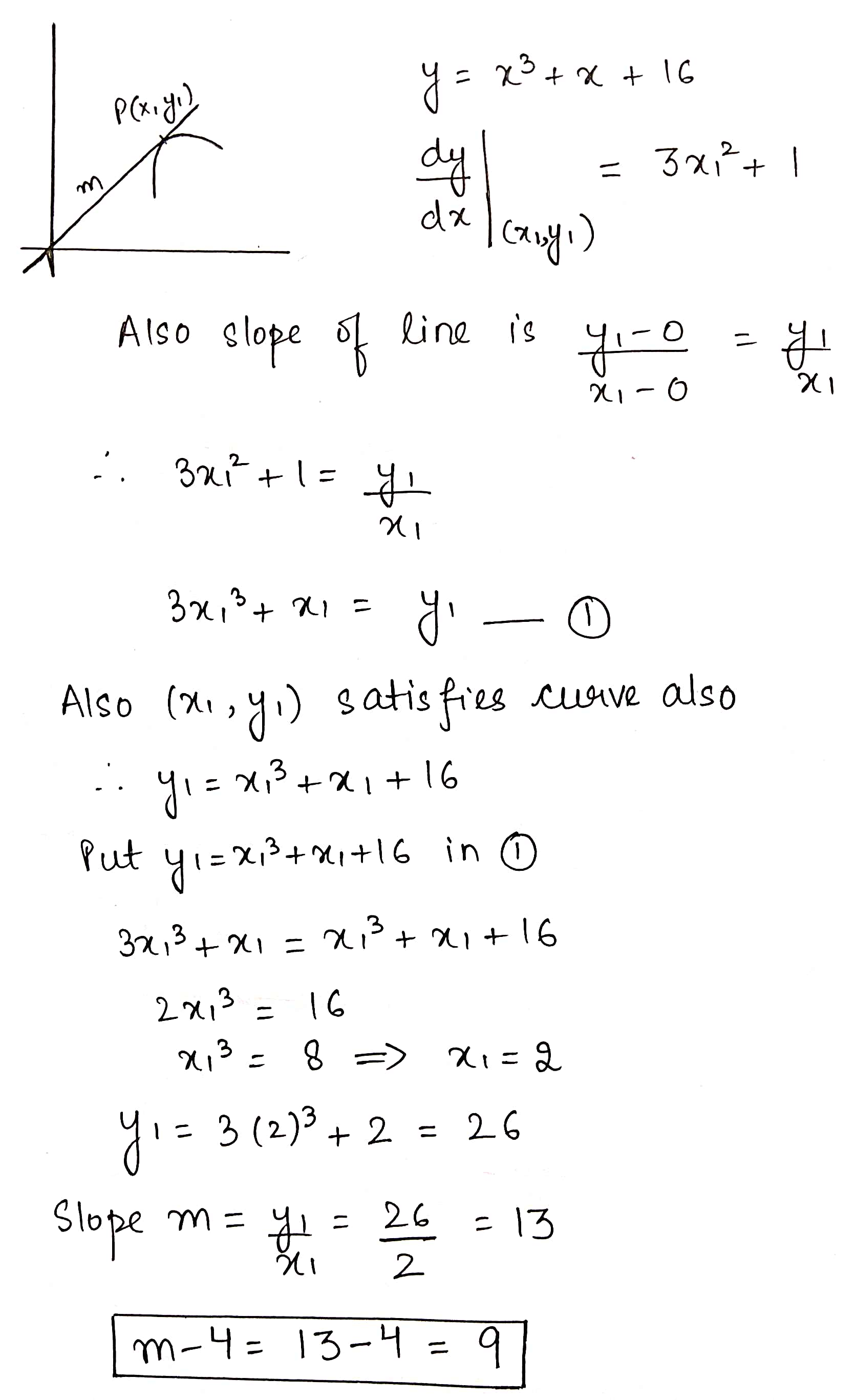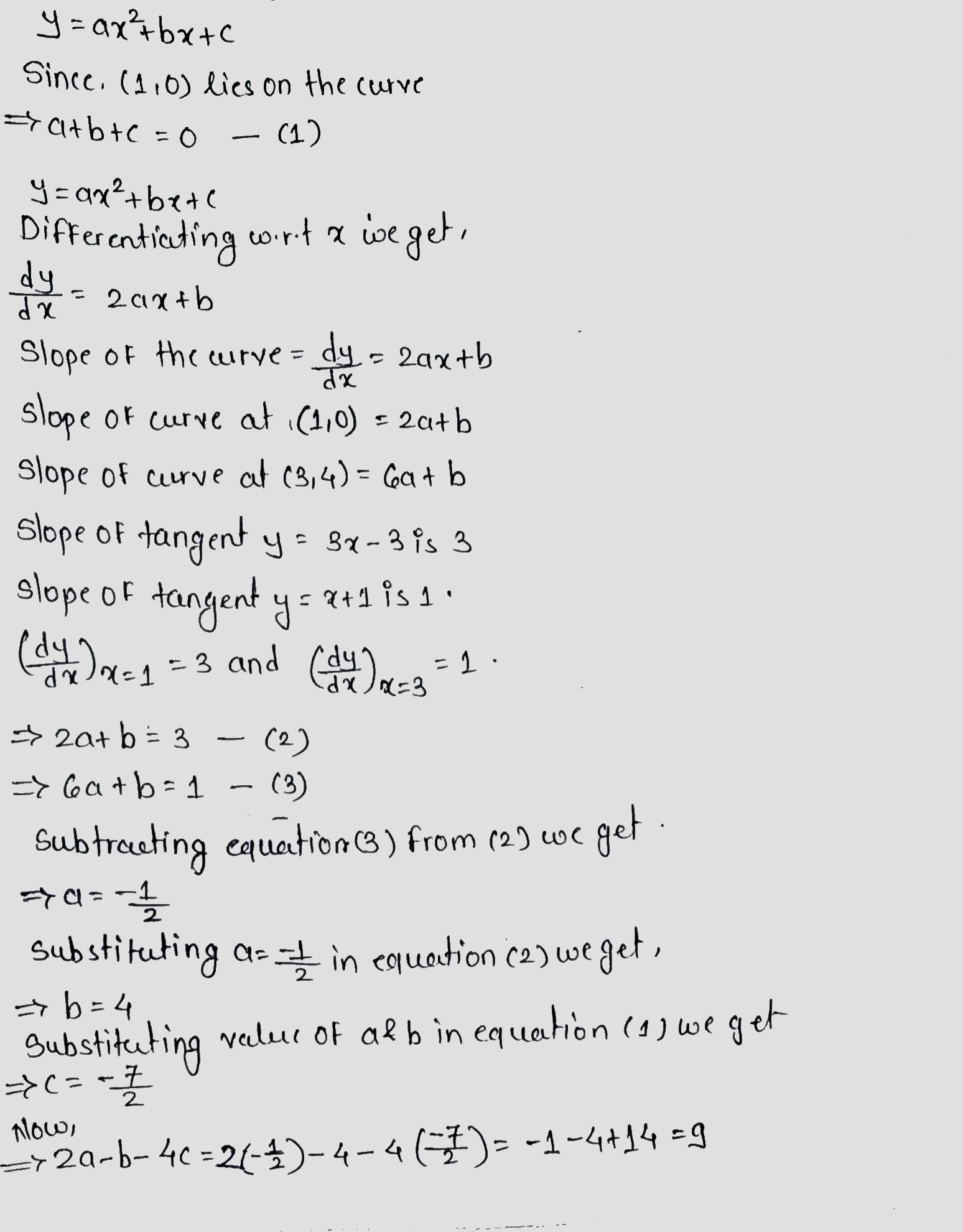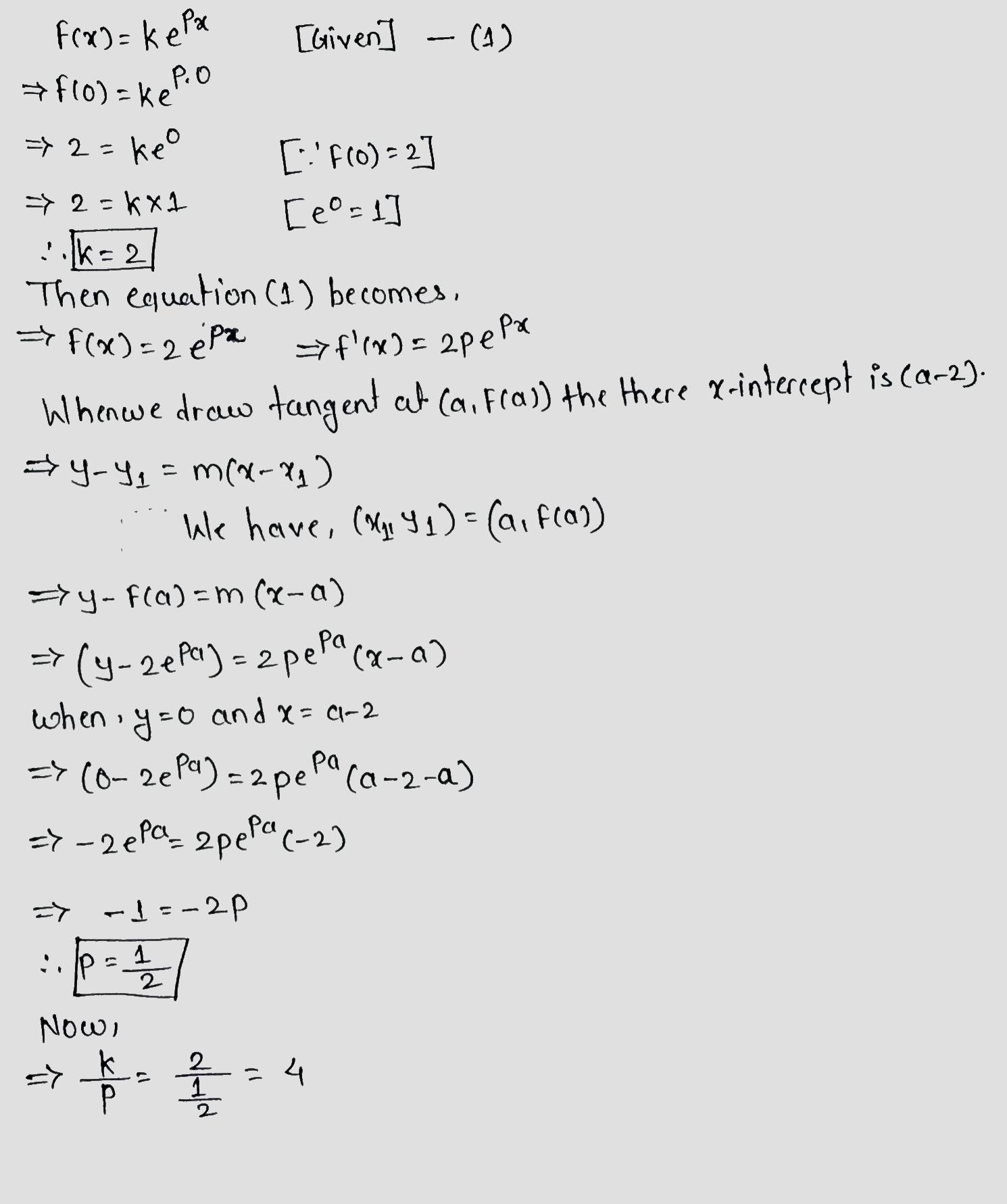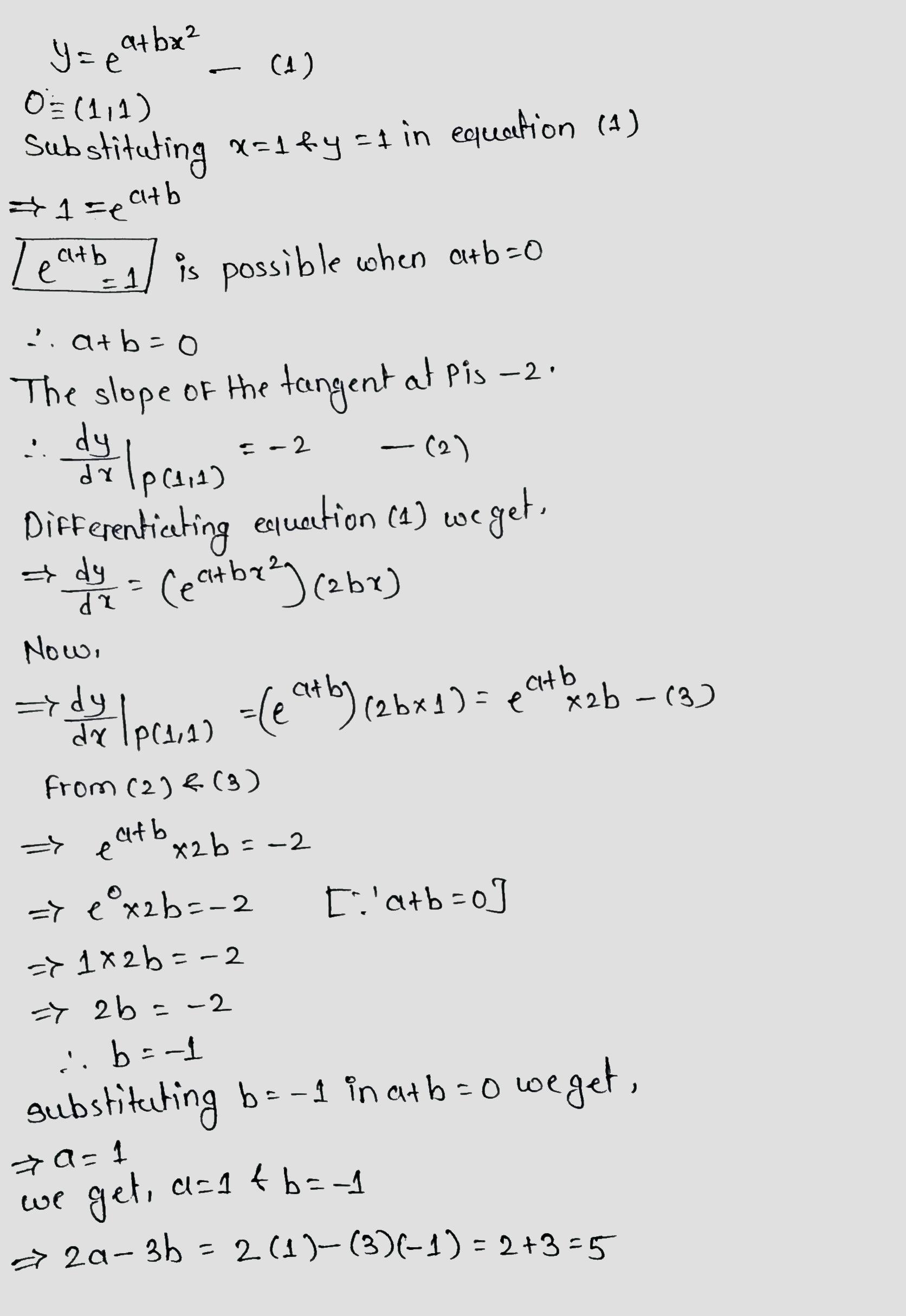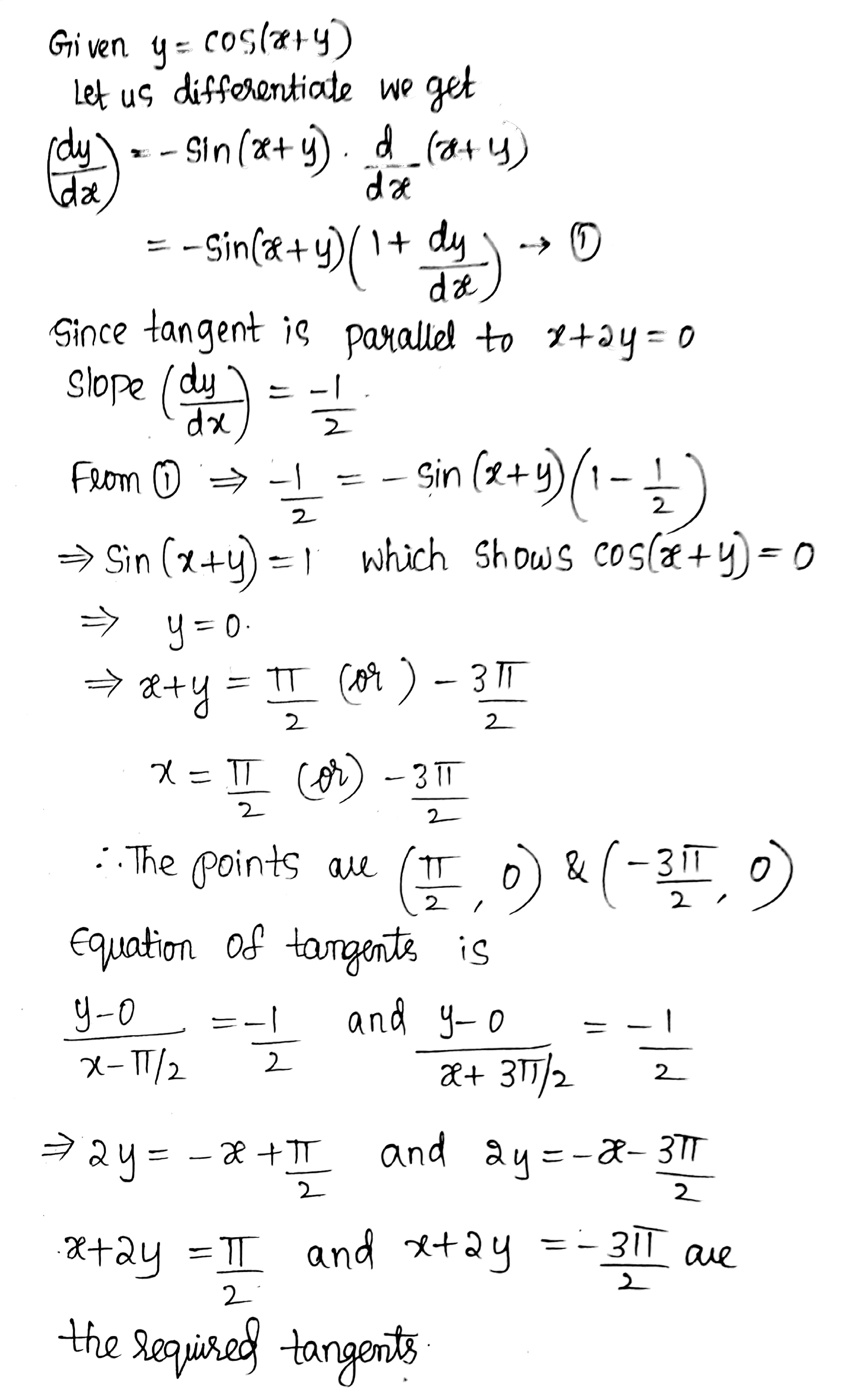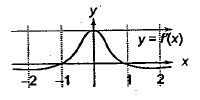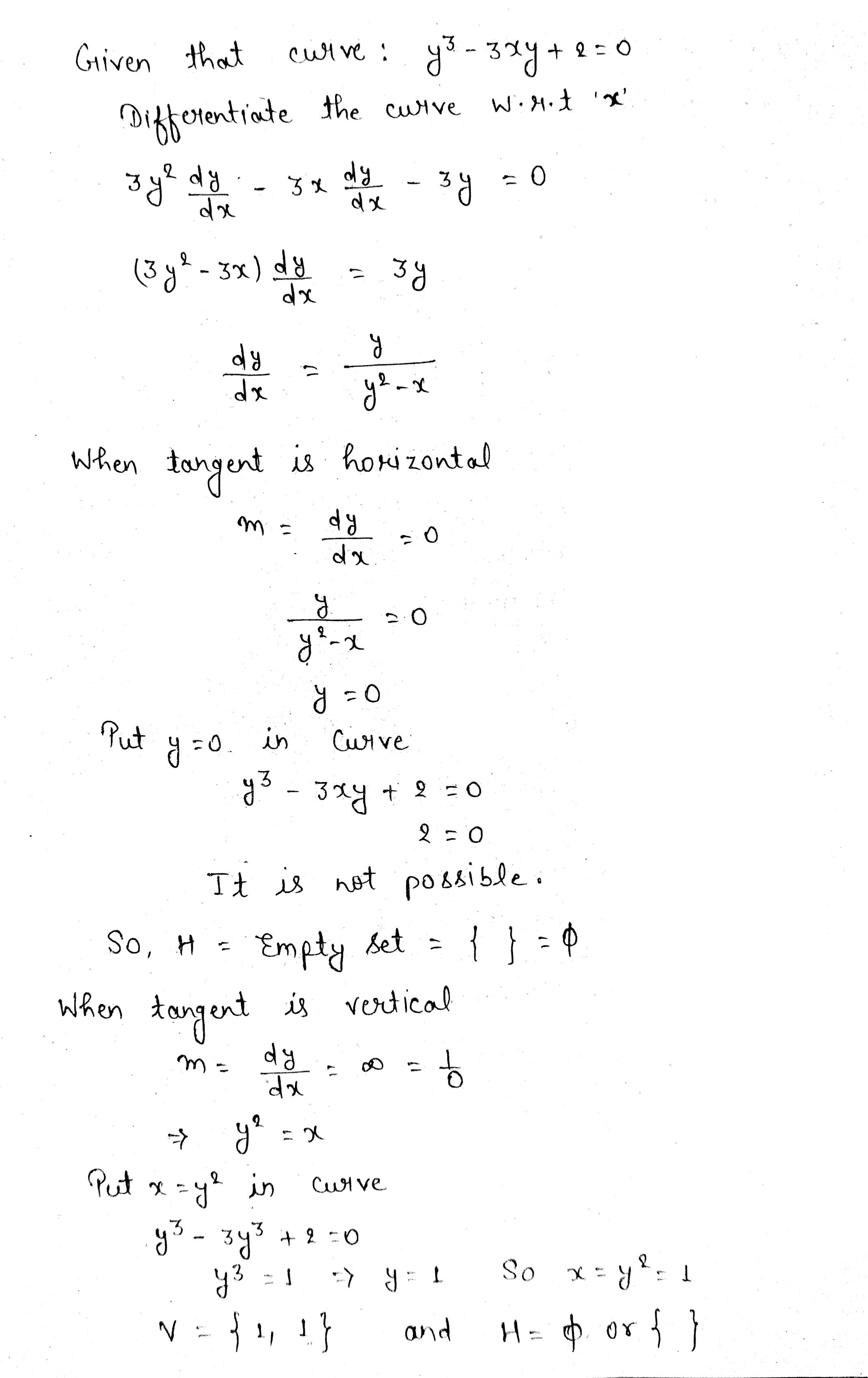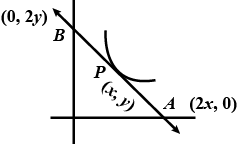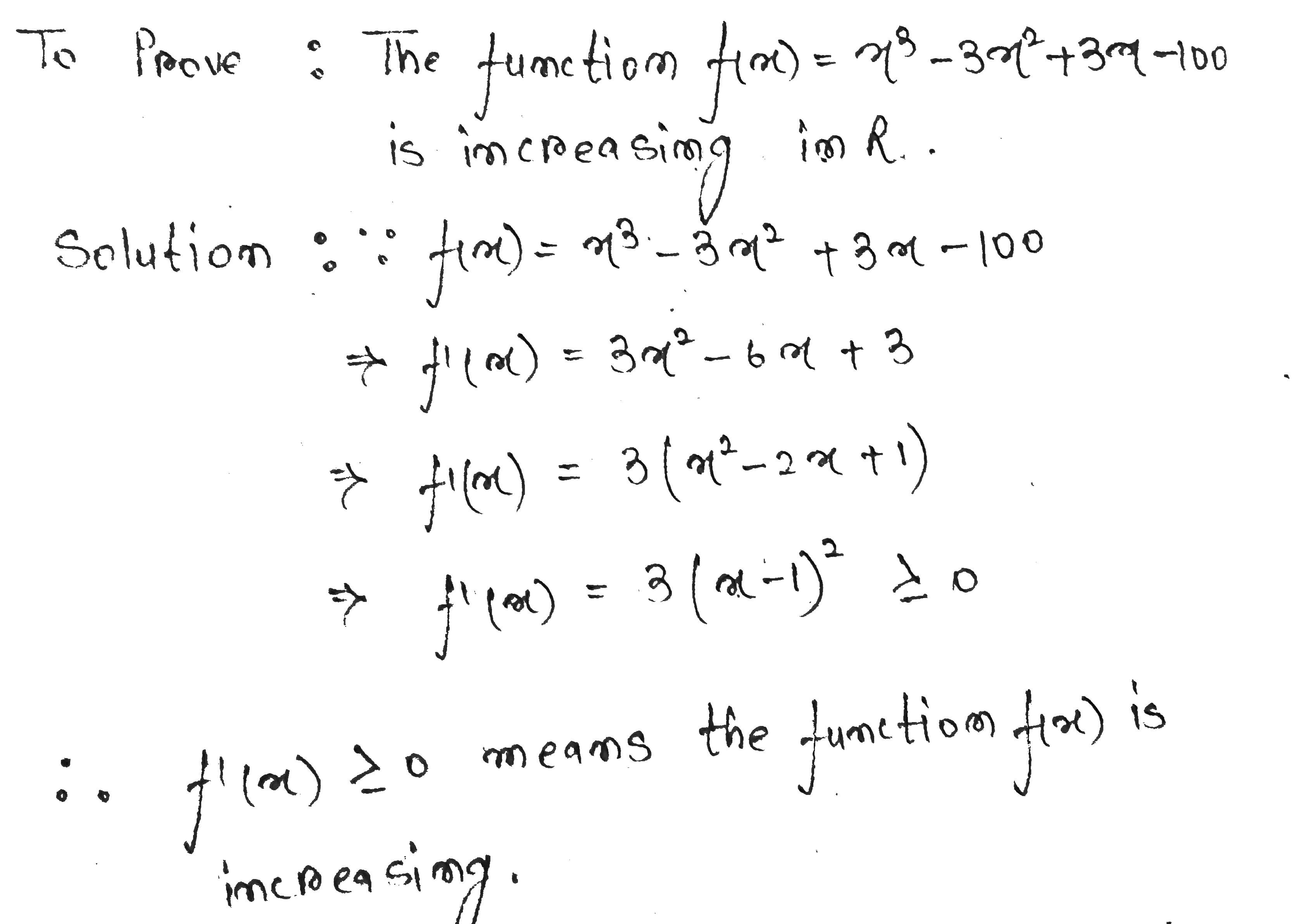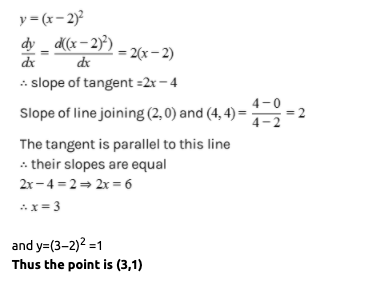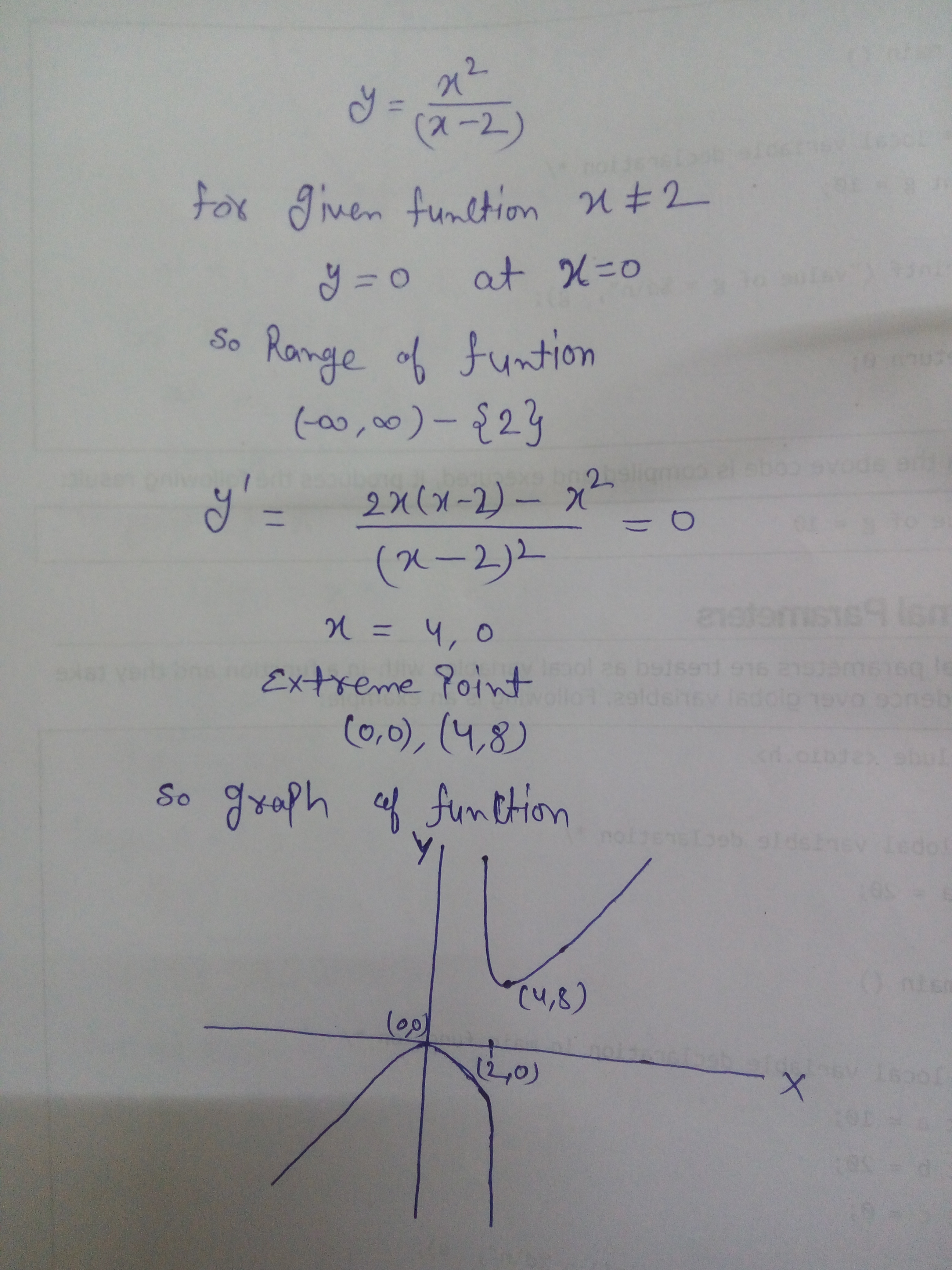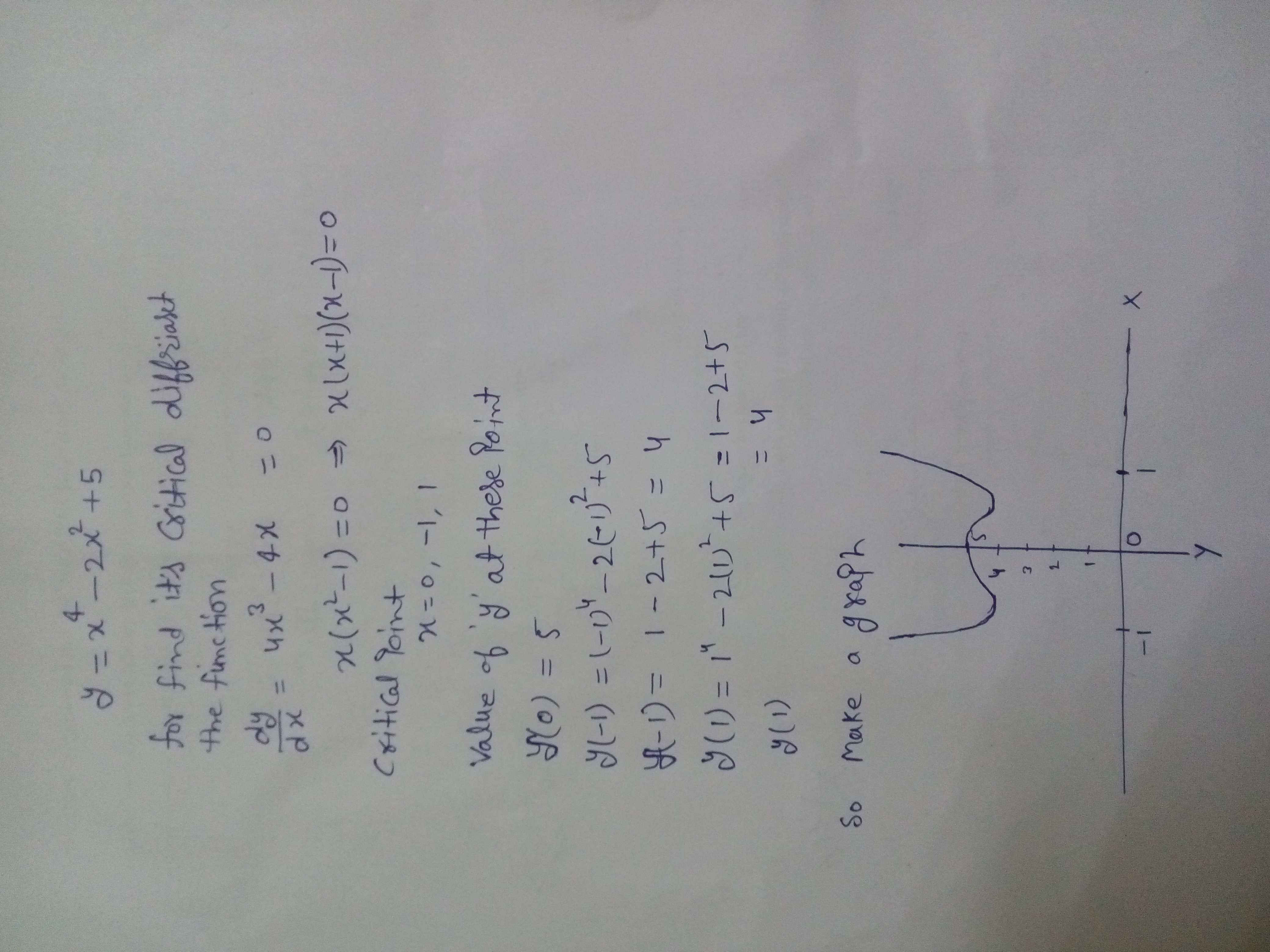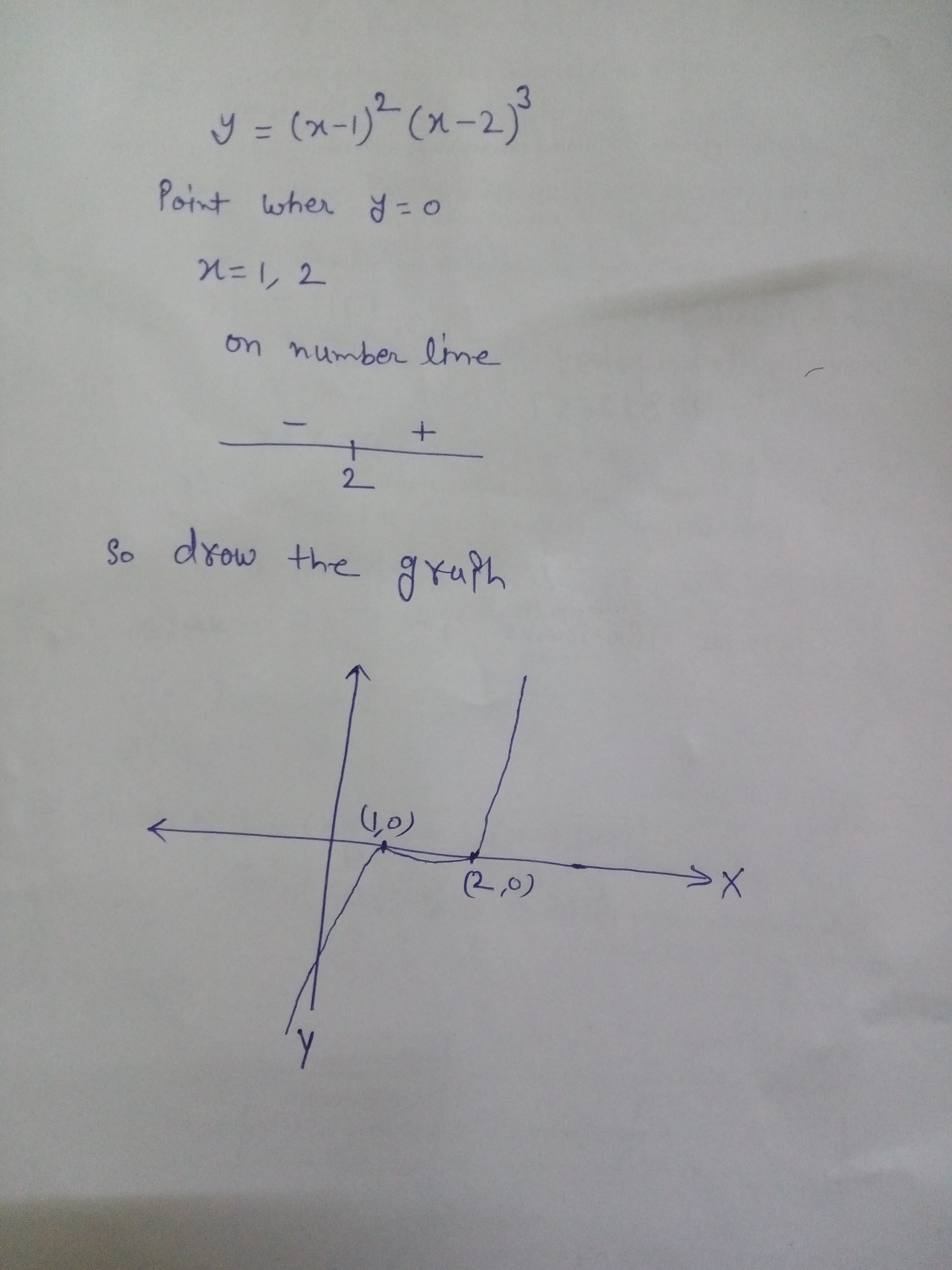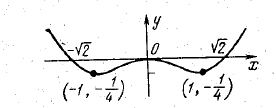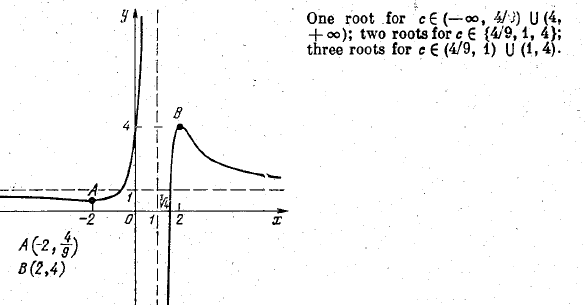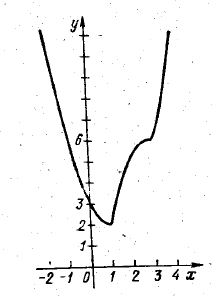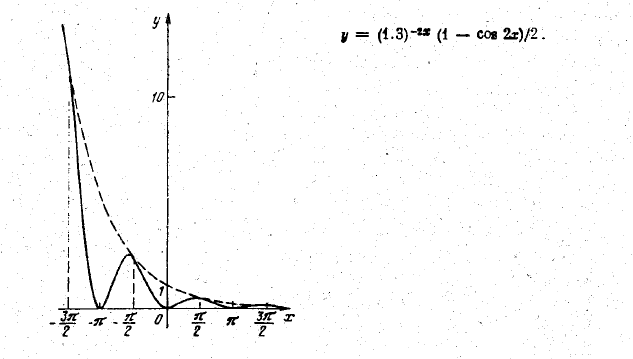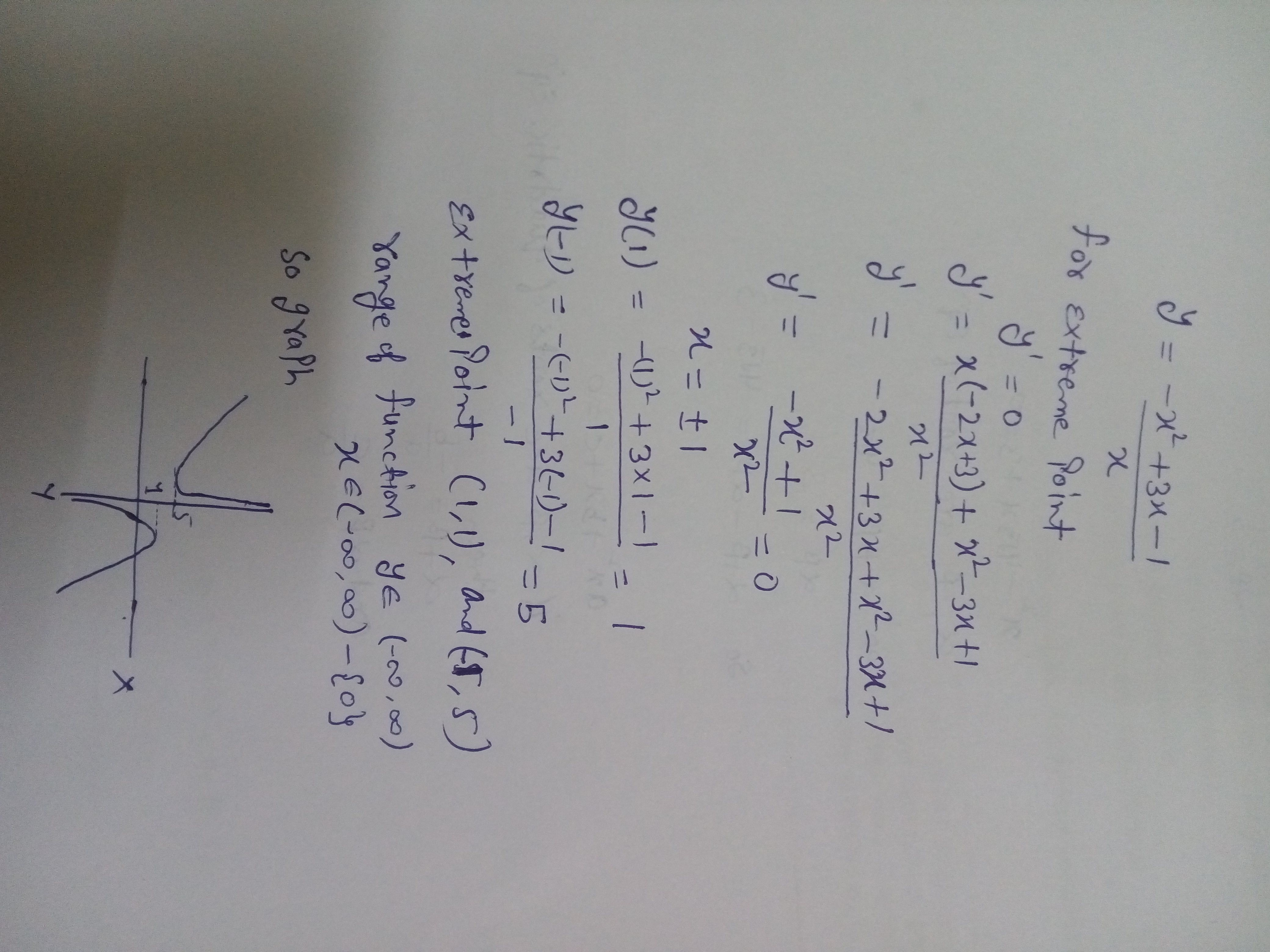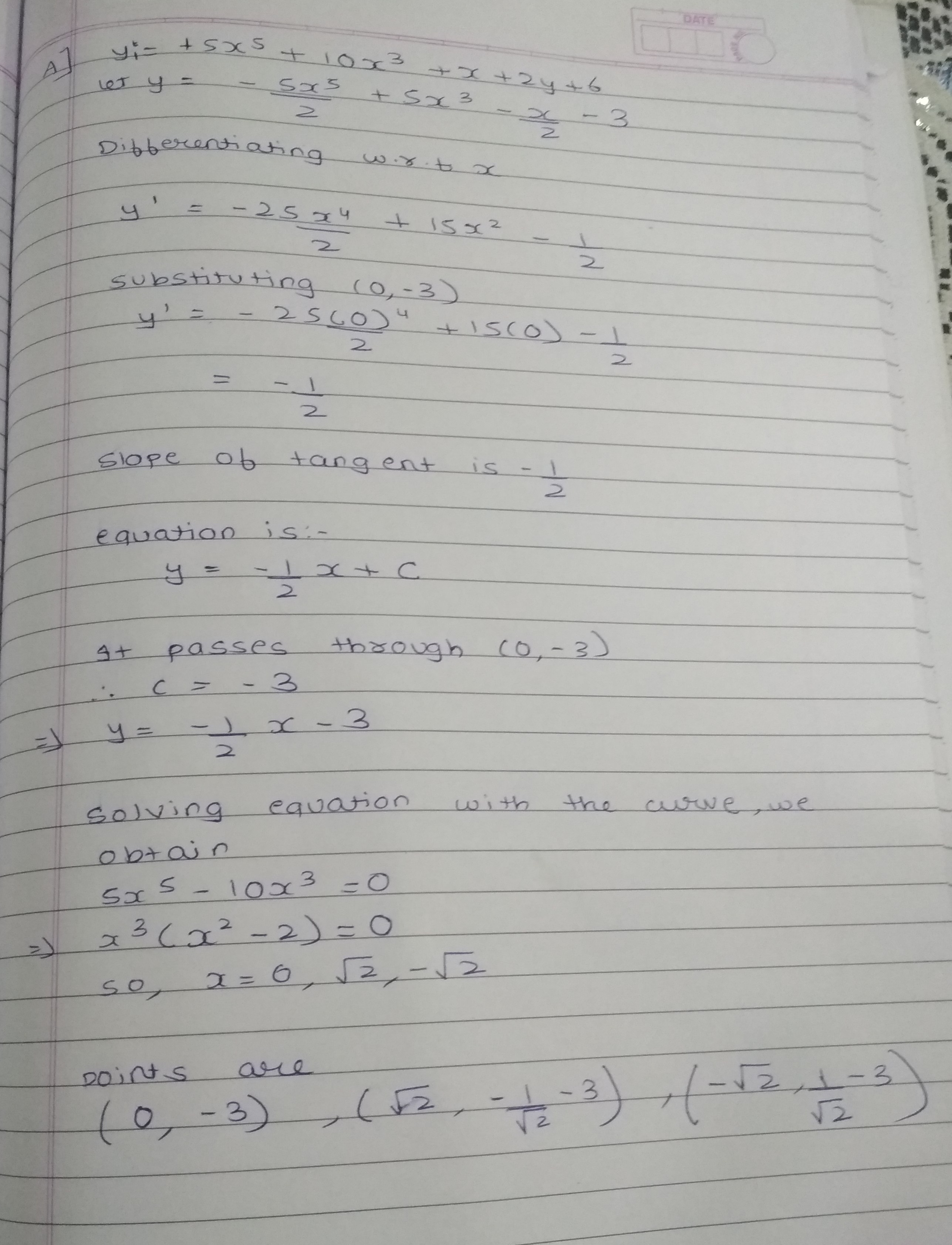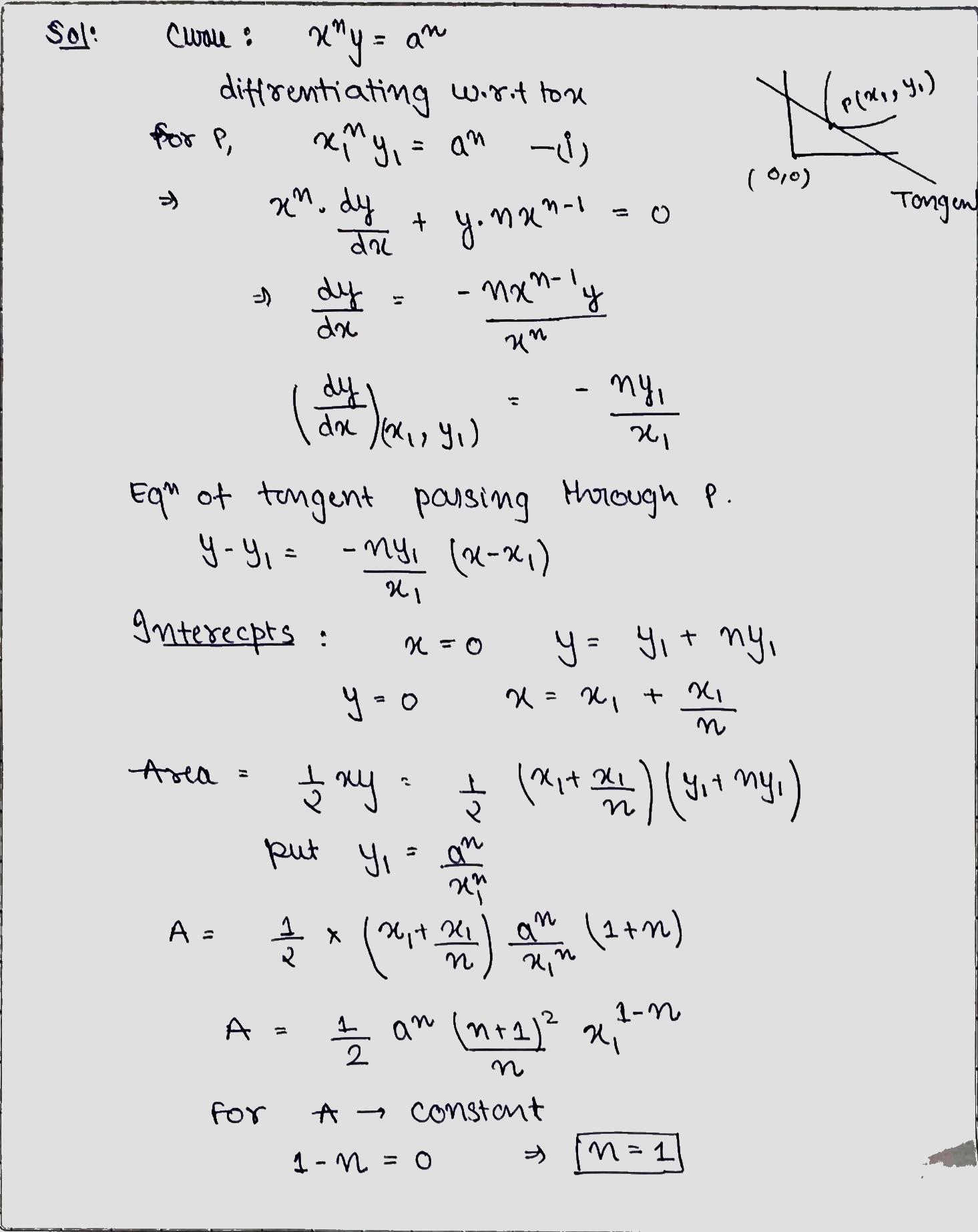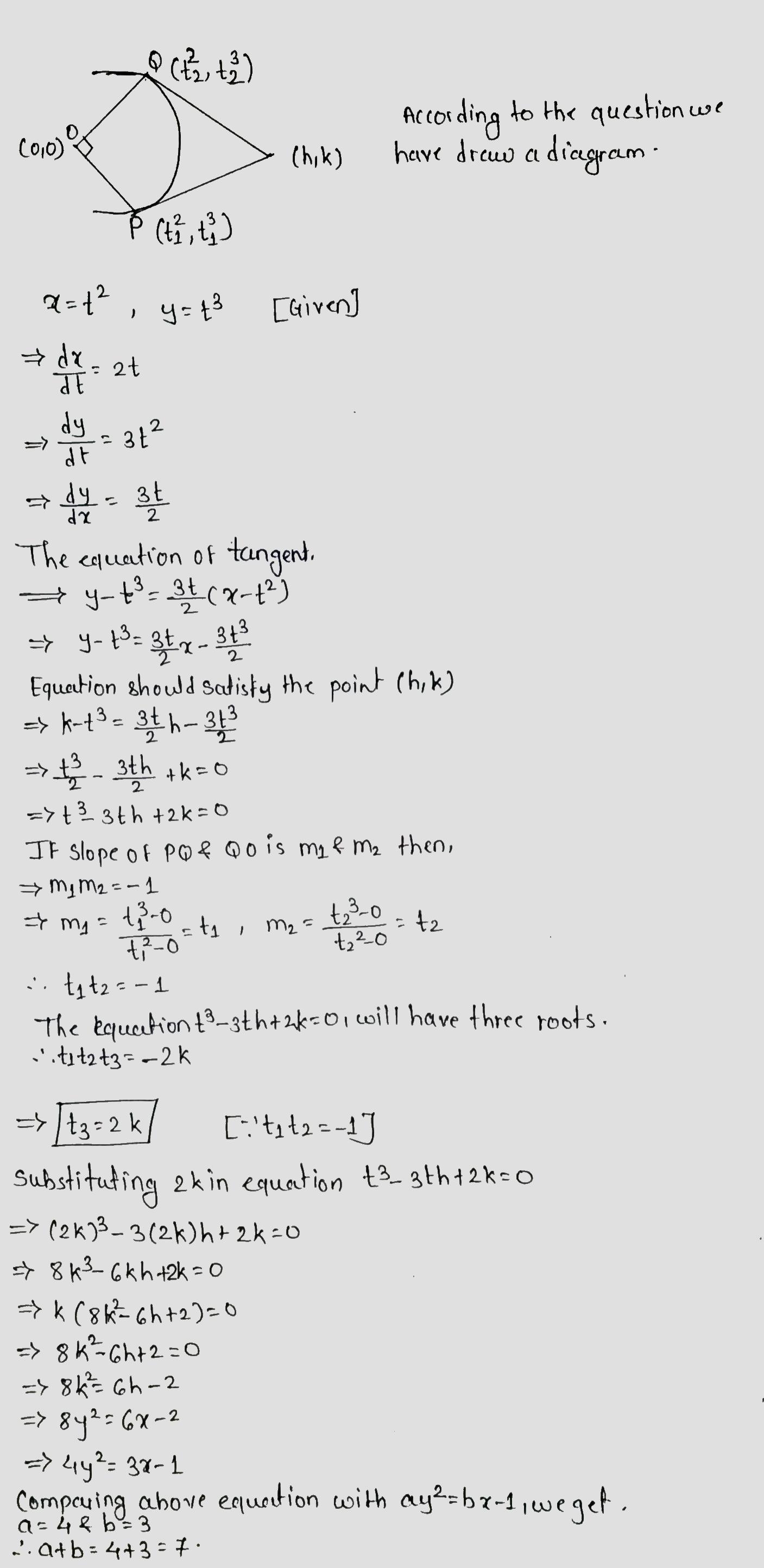Application Of Derivatives - Class 12 Commerce Maths - Extra Questions
Find the equation of tangent in $$1^{\mathrm{s}\mathrm{t}}$$ quadrant to the circle $$\mathrm{x}^{2}+\mathrm{y}^{2}=16$$ at $$(2,2 \sqrt 3)$$

Find the slope of the tangent to curve $$y = x^3- x + 1$$ at the point whose $$x$$-coordinate is $$2$$.
Find the slope of the tangent to the curve $$y = 3x^4- 4x$$ at x = 4.
Show that the function given by $$f(x) = \sin x$$ is (a) strictly increasing in $$\left ( 0, \dfrac{\pi}{2} \right )$$ (b) strictly decreasing in $$\left ( \dfrac{\pi}{2}, \pi \right )$$ (c) neither increasing nor decreasing in $$(0, \pi)$$.
Show that the tangents to the curve $$y = 7x^3+ 11$$ at the points where $$x = 2$$ and $$x = -2$$ are parallel.
Find the slope of the tangent to the curve $$y = x^3-3x + 2$$ at the point whose $$x$$ coordinate is $$3$$.
Find the slope of the tangent at $$(1,2)$$ on the curve $$y={ x }^{ 2 }-4x+5$$.
Find the slope of tangent to the curve $$y=3x^2-6$$ at the point on it whose x-coordinate is 2.
Write the differential equation representing the family of curves $$y=mx$$, where m is an arbitrary constant.
Find the slope of the tangent to the curve $$y=\dfrac{x-1}{x-2}, x\ne 2$$ at $$x=10$$.
If the tangent to the curve $$y = {x}^{3} + ax + b$$ at $$(1, -6)$$ is parallel to the line $$x - y + 5 = 0$$, find $$a$$ and $$b$$.
Find the points on curve $$y=x^3-11x+5$$ at which equation of tangent is $$y=x-11$$.
Find the equations of the common tangents to the parabolas $$\displaystyle y \, = \, x^2 \, - \, 5x \, + \, 6 \, and \, y \, = \, x^2 \, + \, x \, + \, 1.$$
Find the equation of the tangent at origin to the curve $$y=x^{{\cfrac{3}{2}}}$$.
Find the points at which the tangent to the curve $$\displaystyle y \, = \, x \, - \, 0.5 \, sin \, 2x \, - \, 0.5 \, cos \, 2x \, + \, 16 \, cos \, x$$ is parallel to the abscissa axis.
Find the co-ordinates of the points on the ellipse $$x^2+2y^2=9$$ at which tangent has slope $$\dfrac{1}{4}$$. Also find the equation of normal.
If the slope of tangent of $$xy+ax+by=2$$ at point $$(1,1)$$ is $$5$$ then find the values of $$a$$ and $$b$$.
Using differentiation, find the approximate value of each of the following:a) $${\dfrac {17}{81}}^{\dfrac {1}{4}}$$b) $${(33)}^{-\dfrac {1}{5}}$$
Find the equation of the tangent to the curve $$y\, = \,\sqrt {3x\, - \,2} $$ which is parallel to the line $$4x\, - \,2y\, + \,5\, = 0$$.
Further find the equation of the normal to the curve.
Find the maxima of function $$8-7x^2$$
If $$ a,b,c$$ are real number, then find the intervals in which $$f\left( x \right) = \left| {\begin{array}{*{20}{c}} {x + {a^2}}&{ab}&{ac} \\ {ab}&{x + {b^2}}&{bc} \\ {ac}&{bc}&{x + {c^2}} \end{array}} \right|$$ is increasing or decreasing.
Find the slope of tangent and normal to the curve $${x^2} + 2y + {y^2} = 0$$ at $$(-1 , 2)$$
Find the equation of the tangent and normal to the curves
(i) $$y = {x^2} - 4x - 5$$ at $$x = - 2$$
(ii) $$y = x - \sin x\cos x$$
(iii) $$y = 2{\sin ^2}3x\,$$ at $$x = \frac{\pi }{6}$$
Find the stationary point of $$y=x^2+5x-6$$.
Slope of the normal to the curve $$6y^{4}=ax^{3}+bx$$ at $$(1,-1)$$ is $$\dfrac{1}{2}$$. Solve the values of $$a$$ and $$b$$.
Find Stationary points of $$f\left( x \right) = \sin x$$, where $$0 < x < 2\pi $$
Show that the tangents to the curve $$y=2x^3-3$$ at the points where $$x=2$$ and $$x=-2$$ are parallel.
Find the equation of all lines having slope 2 which are tangents to the curve $$y=\dfrac{1}{x-3}, x\neq 3$$.
The normal lines to a given curve at each point pass through (2,0). The curve passes through (2,3). Formulate the differential equation and hence find out the equation of the curve.
Prove that the tangent drawn at any point to the curve $$f(x)= x^{5}+3x^{3}+4x+8$$ would make an acute angle with $$x$$-axis.
Find the approximate value of f(3.02), where $$f(x)=3x^2+5x+3$$.
The slope of the tangent to a curve at any point is reciprocal of twice the ordinate of that point. The curve passes through (4,3). Formulate the differential equation and hence find the equation of the curve.
Find the intervals in which $$f(x)=2x^3+x^2-20x$$ is increasing and decreasing.
Prove that $$f(x)=ax+b$$, where $$a,b$$ are constants and $$a<0$$ is strictly decreasing function on $$R$$.
A stone is dropped into a quiet lake and waves move in a circle at a speed of $$3.5$$ cm/sec. At the instant when the radius of the circular wave is $$7.5$$ cm, how fast is the enclosed area increasing ?
At what point of the curve $$y=x^2$$ does the tangent make an angle of $$45^o$$ with the $$x$$-axis?
Find the slopes of the tangent and the normal to the following curves at the indicated points.
$$x=a\cos^3\theta, y=a\sin^3\theta$$ at $$\theta =\pi/4$$.
Prove that $$f(x)=ax+b$$, where $$a,b$$ are constants and $$a> 0$$ is an increasing function on $$R$$.
Find the slope of the tangent to the curve $$x=t^2+3t-8, y=2t^2-2t-5$$ at $$t=2$$.
Find the slopes of the tangent and the normal to the following curves at the indicated points.
$$x=a(1-\cos\theta)$$ and $$y=a(\theta+\sin\theta)$$ at $$\theta =\pi/2$$.
The diagram shows the curve with equation $$y=4x^{\frac{1}{2}}$$.
The tangent to the curve at a point T is parallel to AB. Find the coordinates of T.Equation of line AB is is y=x+3.
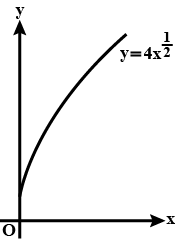
Find the slopes of the tangent and the normal to the following curves at the indicated points.
$$xy=6$$ at $$(1, 6)$$.
Find the slopes of the tangent and the normal to the following curves at the indicated points.
$$x^2+3y+y^2=5$$ at $$(1, 1)$$.
Find the slope of the normal to the curve $$x=a\cos^3 \theta, y=a\sin^3 \theta$$ at $$\theta =\dfrac{\pi}{4}$$.
At what points on the following curve, is the tangent parallel to $$x$$-axis?
$$y=12(x+1)(x-2)$$ on $$[-1,2]$$
Find the slope of the tangent to the curve
$$y=(x^{3}-x)$$ at $$x=2$$
Find the slope of the tangent to the curve $$y=x^3-3x+2$$ at the point whose $$x$$ coordinate is 3.
Find the values of $$b$$ for which the function $$f(x)=\sin x-bx+c$$ is a decreasing function on $$R$$.
Find $$a$$ for which $$f(x)=a(x+\sin x)+a$$ is increasing on $$R$$.
If the tangent line at a point $$(x, y)$$ on the curve $$y=f(x)$$ is parallel to y-axis, find the value of $$\dfrac{dx}{dy}$$.
Find the equation of the normal to the curve $$y=2x^2+3 \sin x $$at $$x=0$$.
Let $$f(x)=ax^3+bx^2+cx+d \sin x$$. If the condition that f(x) is always one-one function is $$b^t < ka(c-|d|)$$ Find $$k+t$$
The number of critical points for $$ \left( x+3 \right) { \left( 3x-2 \right) }^{ 5 }{ \left( 7-x \right) }^{ 3 }{ \left( 5x+8 \right) }^{ 2 }\ge 0$$ is
$$\displaystyle y^{2}=8x$$ and $$\displaystyle x^{2}=4y-12.$$ both touch each other at (k,m).Find $$k+m$$?
Let the abscissa of the point on the curve $$\displaystyle ay^{2}= x^{3},$$ the normal at which cuts off equal intercepts from the axes be ka/m. Find $$m-k$$?
If the critical point as well as stationary point of the function $$f(x)\, =\, \displaystyle \frac{e^x}{x}$$ is $$x=a$$, then value of $$a$$ is:
Find the intervals in which the following functions are strictly increasing or decreasing:
(a) $$x^2 + 2x - 5$$
(b) $$ 10- 6x -2x^ 2$$
(c) $$-2x^3 - 9x^2 - 12x + 1$$
(d) $$6-9x-x^2$$
(e) $$f(x)=(x + 1)^3(x - 3)^3 $$
Find the intervals in which the function $$f$$ given by $$f(x) = 2x^3- 3x^2 -36x + 7$$ is (a) strictly increasing (b) strictly decreasing.
Find the slope of the normal to the curve $$x =1 - a \sin \theta, y = b \cos^2 \theta $$ at $$\theta =\dfrac{\pi}{2}$$.
Find points at which the tangent to the curve $$y = x^3 - 3x^2 -9x + 7$$ is parallel to the $$x$$-axis.
Find a point on the curve $$y = (x - 2)^2$$ at which the tangent is parallel to the chord joining the points $$(2, 0)$$ and $$(4, 4)$$.
Find points on the curve $$\displaystyle \frac{x^2}{9}+\frac{y^2}{16}=1$$ at which the tangents are
(i) Parallel to $$x$$-axis .
(ii) Parallel to $$y$$-axis.
Prove that the function $$f$$ given by $$f (x) = \log \cos x$$ is strictly decreasing on $$\left ( 0, \dfrac{\pi}{2} \right )$$and strictly increasing on $$\left ( \dfrac{\pi}{2}, \pi \right )$$.
Find the points on the curve $$y = x^3$$ at which the slope of the tangent is equal to the $$y$$ coordinate of the point.
Find the slope of the normal to the curve $$x = a \cos^3 \theta , y = a \sin^3 \theta$$ at $$\theta =\cfrac{\pi}{4}$$.
Find the point on the curve $$y = x^3-11x + 5$$ at which the tangent is $$y = x -$$
Find the slope of the tangent to the curve $$y=\cfrac{x-1}{x-2}, x\neq 2$$ at $$x=10.$$
Find the values of $$x$$ for which $$y = [x(x - 2)]^2$$ is an increasing function.
If the radius of a sphere is measured as $$9\ m$$ with an error of $$0.03\ m$$, then find the approximate error in calculating in surface area.
Find the points on the curve $$x^2+ y ^2-2x -3 = 0$$ at which the tangents are parallel to the $$x$$-axis.
Using differentials, find the sum of digits approximate value of the following up to $$3$$ places of decimal.
$$(0.999)^{\tfrac{1}{10}}$$
If the radius of a sphere is measured as $$7 m$$ with an error of $$0.02m$$, then find the approximate error in calculating its volume.
Using differentials, find the approximate value of the following up to $$3$$ decimal places.$$\sqrt {49.5}$$
Show that $$y=\log { \left( 1+x \right) } -\cfrac { 2x }{ 2+x } ,x>-1$$, is an increasing function of $$x$$ throughout its domain.
Using differentials, find the sum of digits approximate value of the following up to $$3$$ places of decimal.
$$(0.999)^{\tfrac{1}{3}}$$
Using differentials, find the sum of digits approximate value of the following up to $$3$$ places of decimal.
$$(26)^{\tfrac{1}{3}}$$
Find the approximate value of $$f (2.01)$$, where $$f (x) = 4x^2 + 5x + 2$$.
Find the intervals in which the function $$f$$ given by $$f(x) ={x}^{3}+\cfrac{1}{{x}^{3}}$$, $$x\ne 0$$ is
(i) increasing (ii) decreasing.
Let $$f$$ be function defined on $$[a,b]$$ such that $$f'(x)> 0$$, for all $$x\in (a,b)$$. Then prove that $$f$$ is an increasing function on $$(a,b)$$.
Show that the normal at any point $$\theta$$ to the curve
$$x=a\cos{\theta}+a\theta \sin{\theta}$$, $$y=a\sin{\theta}-a\theta \cos{\theta}$$ is at constant distance from the origin.
Using differentials, find the approximate value of $${ \left( \cfrac { 17 }{ 81 } \right) }^{ \tfrac { 1 }{ 4 } }$$
At any point (x, y) of a curve, the slope of the tangent is twice the slope of the line segment joining the point of contact to the point (-4, -3). Find the equation of the curve given that it passes through (-2, 1).
Using differentials, find the approximate value of $${(33)}^{\tfrac { 1 }{ 5 } }$$
Find the equation of a curve passing through the origin given that the slope of the tangent to the curve at any point (x, y) is equal to the sum of the coordinates of the point.
Find the equation of a curve passing through the point (0, 2) given that the sum of the coordinates of any point on the curve exceeds the magnitude of the slope of the tangent to the curve at that point by 5.
Find the coordinates of the points on the curve $$y = x - \dfrac{4}{x}$$, where the tangents are parallel to the line $$y = 2x$$.
If the radius of a sphere is measured as $$9\ cm$$ with an error of $$0.02\ cm$$, then find the approximate error in calculating its volume.
If the normal to the curve $$x^{\tfrac{2}{3}} + y^{\tfrac{2}{3}} = a^{\tfrac{2}{3}}$$ makes an angle $$\theta$$ with $$x$$-axis then the slope of the normal is:
Show that the percentage error in the $$n^{th}$$ root of a number is approximately $$\dfrac{1}{n}$$ times the percentage error in the number.
Let $$P$$ be a point on the curve $$y={x}^{3}$$ and suppose that the tangent line at $$P$$ intersects the curve again at $$Q$$. Prove that the slope at $$Q$$ is four times the slope at $$P$$.
Find the intervals of convexity and concavity of the Gaussian curve $$y = e^{-x^{2}}$$ and also find the point of inflection
Show that the function $$f(x) = x^3 - 3x^2 + 6x - 100$$ is increasing on R.
Test whether the function, $$f(x) = x - \dfrac {1}{x}, x\epsilon R, x\neq 0$$, is increasing or decreasing
Find the equation of the curve passing through the point (1, 1), given that the slope of the tangent to the curve to the any point is $$\dfrac{y}{x}+1$$
Prove that, $$f(x) = x^{3} - 3x^{2} + 3x - 100$$ is an increasing function in $$R$$.
Find limits of the error when $$\displaystyle\frac{916}{191}$$ is taken for $$\sqrt{23}$$.
(i) Find the critical numbers of $${ x }^{ \frac { 3 }{ 5 } }\left( 4-x \right) $$
(ii) Determine the domain of convexity of $$y={ e }^{ x }$$
Find the critical points of the following functions and test them for their maxima and minima.
$$\displaystyle\, f(x) \, =\, \frac{x^2 \, -\, 3x\, +\, 2}{x^2\, +\, 3x\, +\, 2}$$
Find the critical points of the following functions.
$$y \, = \, \dfrac{x^3}{3} \, + \, 2x^2 \, - \, 5x \, + \, 4$$
Find the critical points of the following functions and test them for their maxima and minima.
$$\displaystyle\, f(x) = \frac{x^2}{17} - \ln(x^28)$$
Find the critical points of the following function and test them for their maxima and minima.
$$\displaystyle\, y \, = \, x^4 \, -\, 10x^2 \, +\, 9$$
Find the critical points of the following function and test them for their maxima and minima.
$$\displaystyle f(x) \, = \, 3x^4 \, - \, 4x^3$$
Given a function y = $$x^4 \, - \, 10x^2 \, + \, 9$$. Investigate its behaviour and construct a rough drawing of the graph.
Show that $$y=log(1+x)-\dfrac{2x}{2+x},x>-1$$, is an increasing function of x throughout its domain.
Check monotonocity at following points for
(i) $$f(x) = x^3-3x +1$$ at $$x= -1, 2$$
(ii)$$ f(x) =|x -1| +2 | x- 3| -| x+2| $$at $$ x= -2, 0, 3, 5$$
Find the abscissa of point $$P$$ and $$Q$$ on the curve $$y=e^{x}+e^{-x}$$ such that tangents at $$P$$ and $$Q$$ make $$60^{o}$$ with $$x-axis$$.
Show that $$f\left( x \right) =2x+\cot ^{ -1 }{ x } +\log { \left( \sqrt { 1+{ x }^{ 2 } } -x \right) } $$ is increasing in $$R$$.
Find the intervals in which the function $$f(x) = \log (1 + x) - \dfrac{{2x}}{{2 + x}}$$ is increasing or decreasing.
A particle moves along the curve $$6y = {x^3} + 2$$. Find the points on the curve at which y - coordinate is changing 2 times as fast as x - coordinate.
Find the condition tht the curves $$2x=y^{2}$$ and $$2xy=k$$ intersect orthogonally.
Find the co-ordinates of the point on the curve $$\sqrt {x} + \sqrt {y}=4$$ at which tangent is equally inclined to the axes.
If a variable tangent to the curve $${x}^{2}y={c}^{3}$$ makes intercepts $$a,b$$ on $$x$$ and $$y$$ axis respectively, then prove that $${a}^{2}b=(27/4){C}^{3}$$.
Find the slope of the tangent to the curve $$x=at^{2},\ y=2at$$ at $$t=1$$
For the curve $$y=4x-2x^2$$, find the equation of tangent passes through the origin.
Tangent at a point $$P_{1}$$ (other then $$(0,0)$$ on the curve $$y=x^3$$ meets it again at $$P_{2}$$. The tangent at $$P_{2}$$ meets the curve at $$P_{3}$$ & so on. Show that the abscissa of $$P_{1},P_{2},P_{3},......P_{n}$$ form a $$G.P$$. Also find the ratio $$\dfrac {area of \Delta(P_{1}P_{2}P_{3})}{area of \Delta (P_{2}P_{3}P_{4})}$$
If $$g(x)=f(x)+f(2a-x)$$ and $$f''(x)> 0$$ for all $$x\in [0,a]$$, then shown that $$g(x)$$ is decreasing on $$[0,a]$$
Prove that $$\sin x < x < \tan x \forall x \in (0, \pi/2)$$.
Find the critical points of the function $$g(x) = \sqrt{x^2 - 2x - 3}$$
Find the points on the curve $$y=x^3-2x^2-x$$, where the tangents are parallel to $$3x-y+1=0$$.
The number of distinct line(s) which is/ are tangent at a point on curve $$4x^{3} = 27 y^{2}$$ and normal at other point, is
Find the values of a for which $$f(x)=ax^3-9ax^2+9x+25$$ is increasing on R.
The diameter of a sphere is measured to be $$40\ cm$$. If an error of $$0.02\ cm$$ is made in it, then find approximate errors in volume and surface area of the sphere.
The function $$y=\dfrac {ax+b}{(x-1)(x-4)}$$ has turning point at $$P(2,-1) $$. Then find the value of $$a$$ and $$b$$.
Prove that $$f(x)=a^x, 0 < a < 1$$, is decreasing in R.
Find the values of $$x$$, for which the function $$f(x)=x^{3}+12x^{2}+36x+6$$ is increasing.
Find the slope of the tangent and normal to the curve $$y=(\sin 2x+\cot x +2)^2$$ at $$x=\dfrac{\pi}{2}$$.
If $$f(x)=\tan ^{ -1 }{ x } -(1/2)\log { x } $$. Then comment on the nature of curve of f(x).
For the curve $$y =4x^{3}-2x^{5}$$, fnd all the points on the curve at which the tangent passes through the original.
Find the condition for the line $$y = m x + c$$ to be a tangent to the parabola $$x ^ { 2 } = 4 a y$$.
Equation of the curve whose sub tangent is constant is
The $$x-$$intercept of the tangent at any arbitrary point of the curve $$\dfrac { a } { x ^ { 2 } } + \dfrac { b } { y ^ { 2 } } = 1$$ is proportional to
The radius of a sphere is measured as $$14\ cm$$. Later it was found that there is an error $$0.02\ cm$$ in measuring the radius. Find the approximate error in surface area of the sphere.
Find the stationary points of $$f(x)=\cos x $$ where $$0<x<2\pi$$
The point on the curve $$y = 5x - {x^2}$$ at which normal is perpendicular to the line $$x + y = 0$$ is
The stationary points of $$f ( x ) = x ^ { 3 } - 9 x ^ { 2 } + 24 x - 12$$ are
If line $$y=4x-5$$ touches curve $$y^2=ax^3+b$$ at point $$(2, 3)$$ then find the values of a and b.
A circular metal plate expands under heating so that it radius increases by 2%. Find the approximate increase in the area of the plate if the radius of the plate before heating is 10 cm.
If $$y=x^4-10$$ and if x changes from 2 to 1.99, what is the approximate change in y ? Also, find the changed value of y.
The equation of tangent at $$(1,2)$$ to $$x^2+y^2=5$$
Show that $$\dfrac{x}{p} + \dfrac{y}{q} = 1$$ touches the curve $$y = qe^{\frac{-x}{p}}$$ at the point, where the curve crosses the axis of $$y-$$axis.
Find points on the curve $$\dfrac {x^{2}}{9}+\dfrac {y^{2}}{16}=1$$at which tangents are
parallel to $$y-$$axis
Find the slope of a line. Which bisects the first quadrant angle.
Find the value of $$x$$ such that $$f(x)=2x^3-15x^2+36x+1$$ is an increasing function.
Find the equation of a curve passing through $$\left( 1,\dfrac { \pi }{ 4 } \right) $$ if the slope of the tangent to the curve at any point $$p\left( x,y \right) $$ is $$\dfrac { y }{ x } -\cos { ^{ 2 } } \dfrac { y }{ x } $$.
The diagram shows part of the curve $$y=\dfrac{1}{16}(3x-1)^2$$, which touches the x-axis at the point P. The point $$Q(3,4)$$ lies on the curve and the tangent to the curve at $$Q$$ crosses the x-axis at $$R$$.
State the x-coordinate of $$P$$.
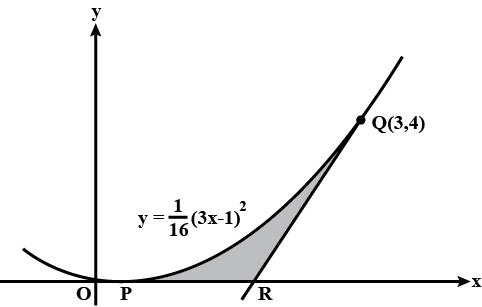
The diagram shows part of the curve with equation $$y=\sqrt{(x^3+x^2)}$$. The shaded region is bounded by the curve, the x-axis and the line $$x=3$$.
P is the point on the curve with x-coordinate $$3$$. Find the y-coordinate of the point where the normal to the curve at P crosses the y-axis.
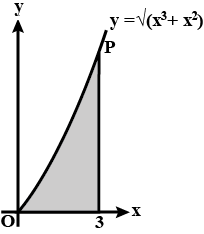
A curve has equation $$y=(2x-1)^{-1}+2x$$. $$x\neq\dfrac{1}{2}$$
Find the x-coordinates of the stationary points
Find the value of p for when the curves $$x^{2}=9p(9-y)$$ and $$x^{2}=P(y+1)$$ cut each other at right angles .
Find the slopes of the tangent and the normal to the following curve at the indicated point.
$$y=\sqrt{x^3}$$ at $$x=4$$.
Find the slopes of the tangent and the normal to the following curve at the indicated point.
$$y=\sqrt{x}$$ at $$x=9$$.
The diagram shows part of the curve with equation $$y=\sqrt{(x^3+x^2)}$$. The shaded region is bounded by the curve, the x-axis and the line $$x=3$$.
Find the y-coordinate of the point where the normal to the curve at P crosses the y-axis.
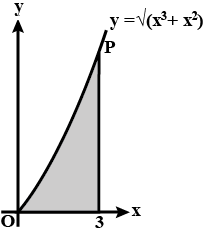
If the tangent to the curve $$y=x^3+ax+b$$ at $$(1, -6)$$ is parallel to the line $$x-y+5=0$$, find $$a$$ and $$b$$.
Find the equation of the tangent and the normal to the following curves at the indicated points.
$$\dfrac{x^2}{a^2}-\dfrac{y^2}{b^2}=1$$ at $$(a\sec\theta, b\tan\theta)$$.
Find the slopes of the tangent and the normal to the following curve at the indicated point.
$$y=(\sin 2x+\cot x+2)^2$$ at $$x=\dfrac {\pi}{2}$$.
Find the slope of the tangent and the normal to the following curve at the indicated point.
$$y=2x^2+3\sin x$$ at $$x=0$$.
Find the point on the curve $$y=x^2$$, where the slope of the tangent is equal to the $$x$$-coordinate of the point.
Find the slope of the tangent and the normal to the following curves at the indicated points.
$$y=x^3-x$$ at $$x=2$$.
Find the slopes of the tangent and the normal to the following curve at the indicated point.
$$x=a(\theta -\sin\theta), y=a(1+\cos\theta)$$ at $$\theta =-\dfrac {\pi}{2}$$.
Find the values of $$a$$ and $$b$$, if the slope of the tangent to the curve $$xy+ax+by=2$$ at $$(1, 1)$$ is $$2$$.
Find the points on the curve $$xy+4=0$$ at which the tangents are inclined at an angle of $$45^o$$ with the $$x$$-axis.
Find the points on the curve $$y^2=2x^3$$ at which the slope of the tangent is $$3$$.
Prove that the function $$f(x)=\log _{ e }{ x } $$ is increasing on $$(0,\infty)$$.
Using differential, find the approximate value of the following:
$$\sqrt{401}$$
Prove that $$\left(\dfrac{x}{a}\right)^n+\left(\dfrac{y}{b}\right)^n=2$$ touches the straight line $$\dfrac{x}{a}+\dfrac{y}{b}=2$$ for all $$n\in N$$, at the point (a, b).
A stone is dropped into a quiet lake and waves move in circles at a speed of $$4$$ cm/sec. At the instant when the radius of the circular wave is $$10$$ cm, how fast is the enclosed area increasing?
Prove that the function $$f(x)=\log _{ a }{ x } $$ is increasing on $$(0,\infty )$$, if $$a> 1$$ and decreasing on $$(0,\infty )$$, if $$0< a< 1$$.
The pressure $$P$$ and the volume $$v$$ of a gas are connected by the relation $$pv^{1.4}=$$ const. Find the percentage error in $$p$$ corresponding to a decrease of $$\dfrac {1}{2}\%$$ in $$v$$.
lf there is an error of $$0.1\%$$ in the measurement of the radius of a sphere, find approximately the percentage error in the calculation of the volume of the sphere.
Find the equation of all lines of slope zero and that are tangent to the curve $$y=\dfrac{1}{x^2-2x+3}$$.
Using differentials, find the approximate value of the following:
$$\sqrt{37}$$
A man $$160$$ cm tall, walks away from a source of light situated at the top of a pole $$6$$ m high, at the rate of $$1.1$$ m/sec. How fast is the length of his shadow increasing when he is $$1$$ m away from the pole?
If $$y = 7x-x^{3}$$ and $$x$$ increases at the rate of $$4$$ units per second, how fast is the slope of the curve changing when $$x = 2$$?
A particle moves along the curve $$ y = x^3.$$ Find the points on the curve at which the y-coordinate changes three times more rapidly than the x-coordinate.
Write the coordinates of the point on the curve $$y^2=x$$ where the tangent line makes an angle $$\dfrac{\pi}{4}$$ with x-axis.
Let $$C$$ be a curve defined parametrically as $$x=a\cos^{3}\theta, y=a\sin^{3}\theta, 0\le \theta \le \dfrac{\pi}{2}$$. Determine a point $$P$$ on $$C$$, where the tangent to $$C$$ is parallel to the chord joining the points $$(a,0)$$ and $$(0,a)$$
If the radius of a sphere is measured as $$7$$ m with an error of $$0.02$$ m, find the approximate error in calculating its volume.
Find the slope of the normal at the point '$$t$$' on the curve $$x=\dfrac{1}{t}, y=t$$.
Show that the curves $$4x=y^2$$ and $$4xy=k$$ cut at right angles, if $$k^2=512$$.
If the straight line $$x\cos \alpha +y\sin \alpha =p$$ touches the curve $$\dfrac{x^2}{a^2}-\dfrac{y^2}{b^2}=1$$, then prove that $$a^2\cos^2\alpha -b^2\sin^2\alpha =p^2$$.
Show that the curves $$2x=y^2$$ and $$2xy=k$$ cut at right angles, if $$k^2=8$$.
Write the slope of the normal to the curve $$y=\dfrac{1}{x}$$ at the point $$\left(3, \dfrac{1}{3}\right)$$.
What are the values of $$a$$ for which $$f(x)={a}^{x}$$ is decreasing on $$R$$?
What are the values of $$a$$ for which $$f(x)={a}^{x}$$ is increasing on $$R$$?
Write the set of values of $$a$$ for which $$f(x)=\log _{ a }{ { x }_{ } } $$ is increasing in its domain.
Find the set of values of $$a$$ for which $$f(x)=x+\cos x+ax+b$$ is increasing on $$R$$.
Find the set of values of $$b$$ for which $$f(x)=b(x+\cos x)+4$$ is decreasing on $$R$$.
Write the set of values of $$a$$ for which $$f(x)=\log _{ a }{ { x }_{ } } $$ is decreasing in its domain.
Write the set of values of $$k$$ for which $$f(x)=kx-\sin x$$ is increasing on $$R$$.
Write the set of values of $$a$$ for which the function $$f(x)=ax+b$$ is decreasing for all $$x\in R$$.
At what points on the following curve, is the tangents parallel to $$x$$-axis?
$$y=x^{2}$$ on $$[-2,2]$$
Solve the following equation:
$$\tan 3x+\tan x=2\tan 2x$$
Find the slope of the tangent and the normal to the curve $$2{x}^{2}+4y-3{y}^{2}=3$$ at $$\left(-1,1\right)$$
Differentiate the following function with respect to x.
$$x^{-4}(3-4x^{-5})$$.
At what points on the following curve, is the tangent parallel to $$x$$-axis?
$$y=e^{1-x^{2}}$$ on $$[-1,1]$$
Find the derivative of the following function at the indicated points.
$$\sin x$$ at $$x=\dfrac{\pi}{2}$$.
Find the slope of the tangent and the normal to the curve $${x}^{2}+y-{y}^{2}=5$$ at $$\left(-1,2\right)$$
Find the slope of the tangent and the normal to the curve $${x}^{2}-2y-{y}^{2}=1$$ at $$\left(-1,-2\right)$$
Find the derivative of $$f(x)=3x$$ at $$x=2$$.
Find the derivative of $$f(x)=\tan x$$ at $$x=0$$.
Find the derivative of the following function at the indicated points.
$$\sin 2x$$ at $$x=\dfrac{\pi}{2}$$.
Find the derivative of the following function at the indicated points.
$$2\cos x$$ at $$x=\dfrac{\pi}{2}$$.
Find the derivative of the following function at the indicated points.
$$x$$ at $$x=1$$.
Find the derivative of $$f(x)=\cos x$$ at $$x=0$$.
Using differentials, find the approximate value of :
$$\sqrt[4]{15}$$
Using differentials, find the approximate value of :
$$\sqrt{49.5}$$
Using differentials, find the approximate value of :
$$\dfrac{1}{(2.002)^2}$$
Using differentials, find the approximate value of :
$$\sqrt{0.24}$$
Using differentials, find the approximate value of :
$$\sqrt{37}$$
Using differentials, find the approximate value of :
$$\sqrt[3]{29}$$
Using differentials, find the approximate value of :
$$\sqrt[3]{27}$$
Using differentials, find the approximate value of :
$$\log_e 10.02$$, given that $$\log_e 10=2.3026$$
Using differentials, find the approximate value of :
$$\log_{10}(4.04)$$, it being given that $$\log_{10}4=0.6021$$ and $$\log_{10}e=0.4343$$
Find the points on the curve $$y=x^3-3x$$, where the tangent to the curve is parallel to the chord joining $$(1, -2)$$ and $$(2, 2)$$.
Using differentials, find the approximate value of :
$$\cos 61^o$$, it being given that $$\sin 60^o=0.86603$$ and $$1^o=0.01745$$ radian
Show that $$f(x)=\left(x^3+\dfrac{1}{x^3}\right)$$ is decreasing on $$(-1, 1)$$.
Prove that the function $$f(x)=\log (1+x)-\dfrac{2x}{(x+2)}$$ is increasing for all $$x>-1$$.
Show that $$f(x)=\dfrac{x}{\sin x}$$ is increasing on $$\left[ 0, \dfrac{\pi}{2}\right].$$
If there is an error of $$0.1\%$$ in the measurement of the radius of a sphere, find approximately the percentage error in the calculation of the volume of the sphere.
Show that the relative error in the volume of a sphere, due to an error in measuring the diameter, is three times the relative error in the diameter.
Find a point of the curve $$y=x^3$$, where the tangent to the curve is parallel to the chord joining the points $$(1, 1)$$ and $$(3, 27)$$.
Find the slope of the tangent to the curve
$$y=(\sin 2x+\cot x+2)^{2}$$ at $$x=\dfrac{\pi}{2}$$
Find the slope of the tangent to the curve
$$y=(2x^{2}+3\sin x)$$ at $$x=0$$
Find the points on the curve $$y=x^{2}+3x+4$$ at which the tangent passes through the origin.
Find a point on the parabola $$y=(x-3)^{2}$$, where the tangent is parallel to the chord joining the points $$(3,0)$$ and $$(4,1)$$.
Show that $$f(x)=\dfrac{(x-2)}{(x+1)}$$ is increasing for all $$x\in R$$, except at $$x=-1$$.
Find the points on the parabola $$y=2x^{2}-6x-4$$ at which the tangent is parallel to the $$x-$$ axis:
Prove that the tangents to the curve $$y=x^{2}-5x+6$$ at the points $$(2,0)$$ and $$(3,0)$$ are at right angles.
Find the points on the curve $$x^{2}+y^{2}-2x-3=0$$ where the tangent is parallel to the $$x-$$ axis
Find the points on the curve $$y=x^{3}-11x+5$$ at which the equation of tangent is $$y=x-11$$
At what points on the curve $$x^{2}+y^{2}-2x-4y+1=0$$, is the tangent parallel to the $$y-$$ axis?
Tangents are drawn from the origin to curve $$y= \sin x.$$ Prove that portion of contact lie on $$y^{2}= \dfrac{x^{2}}{1+x^{2}}$$
Let $$f$$ be a twice differentiable function such that $$f^{''} (x) = -f(x)$$, and $$f^{'} (x) = g(x)$$, $$h(x) = \left [f(x)^{2} \right ] + \left [g(x)^{2} \right ]$$. Find $$h(10)$$ if $$h(5) = 11$$. (IIT-JEE, 1982)
At the point $$P(a, a^{n})$$ on the graph of $$y= x^{n} (n \epsilon N)$$ in the first quadrant a normal is drawn. The normal interersects the y-axis at the point (o, b). If $$\underset{a\rightarrow 0}{\lim}b=\dfrac{1}{2}$$, then n equals
A curve is given by the equations $$x = \sec ^{2} \theta,\,y=\cot \theta$$. If the tangent at P where $$\theta=\dfrac{\pi}{4}$$ meets the curve again at Q, then [PQ] is, where [ . ] represents the greatest integer function,
There is a point (p, q) on the graph of $$f(x)= x^{2}$$ and a point (r, s) on the graph of $$g(x)= \dfrac{-8}{x}$$ , where $$p> 0$$ and $$r> 0$$. if the line through (p, q) and (r, s) is also tangent to both the curves at these points, respectively, then value of p+r is
If the slope of line through the origin which is tangent to the curve $$y = x^{3}+x+16$$ is m, then the value of m-4 is
Suppose a, b, care such that the curve $$y = ax^{2}+ bx + c$$ is tangent to y = 3x- 3 at (1, 0) and is also tangent to y = x+1 at (3, 4) then the value of (2a - b - 4c) equals
Let $$y=f(x)$$ be drawn with $$f(0) = 2$$ and for each real number the tangent to $$y = f(x)$$ at $$(a, f(a)),$$ has $$x$$ intercept $$(a-2).$$ If $$f(x)$$ is of the form of $$k e^{px},$$ then $$\left ( \dfrac{k}{p} \right )$$ has the value equal to
Let C be a curve defined by $$y = e^{a+bx^{2}}$$.The curve C passes through the point O(1, 1) and the slope of the tangent at P is (-2). Then the value of 2a- 3b is
Let $$-1\le p\le 1$$. Show that the equation $$4x^{2}-3x-p=0$$ has a unique root in the interval $$[1/2,1]$$ and identify it.
Find all the tangents to the curve $$y =\cos (x + y )$$, where $$-2\pi \leq x\leq 2\pi $$, that are parallel to the line x + 2y = 0.
Find the coordinates of the point on the curve $$y=\dfrac{x}{1+x^{2}}$$ where the tangent to the curve has the greatest slope.
Find the point on the curve $$4x^{2}+a^{2}y^{2}=4a^{2}, 4 < a^{2} < 8$$ that is farthest from the point $$(0,-2)$$
Fill in the blanks
Let C be the curve $$y^{3}-3xy+2=0$$. If H is the set of points on the curve C where the tangent is horizontal and V is the set of points on the curve C where the tangent is vertical is vertical, then
H= _______ and V= _________
Find the points on the curve $$y=x^{3}$$ at which the slope of the tangent is equal to the y- coordinates of the point.
Using differentials, find the approximate value of $$\sqrt{49.5}.$$
Find the slope of the tangent to the curve $$x=t^{2}+ 3t - 8, y= 2t^{2}- 2t- 5\, at\, t=2$$
Find the point at which the tangent to the curve $$y=\sqrt{4x-3}-1 $$ has its slope $$\dfrac{2}{3}$$.
If the radius of a sphere is measured as $$9\, cm$$ with an error of $$0.03\, cm$$, find the approximate error in calculating its surface area.
Show that the normal at any point to the curve $$x= a cos \theta+ a \theta sin \theta, y= a sin \theta- a \theta cos \theta$$ is at a constant distance from the origin.
The values of $$ a $$ for which $$ y=x^2+ax+25 $$ touches the axis of $$ x$$ are______.
Find the equation of a curve whose tangent at any point on it, different from origin, has slope $$y+\dfrac {y}{x}$$.
Find a pair of curves such that
a. the tangent drawn at points with equal abscissas intersect on the y-axis.
b. the normal drawn at points with equal abscissa intersect on the x-axis.
c. one curve passes through (1,1) and other passes through (2, 3).
Given two curves: $$y = f(x)$$ passing through the point $$(0, 1)$$ and $$g(x) = \int_{-\infty}^x f(t)dt$$ passing through the point $$\left(0, \dfrac{1}{n}\right)$$. The tangents drawn to both the curves at the points with equal abscissa intersect on the x-axis. Find the curve $$y = f(x)$$.
Find the equation of a curve passing through origin if the slope of the tangent to the curve at any point $$(x, y)$$ is equal to the square of the difference of the abscissa and ordinate of the point.
Find the equation of a curve passing through the point $$(1,1)$$. If the tangent drawn at any point $$P(x, y)$$ on the curve meets the co-ordinates axes at $$A$$ and $$B$$ such that $$P$$ is the mid-point of $$AB$$.
Solve the following: Determine the area of the triangle formed by the tangent to the graph of the function $$y=3-x^{2}$$ drawn at the point $$(1,2)$$ and the coordinate axes.
Find the equation of the curve through the point $$91,0)$$ if the slope of the tangent to the curve at any point $$(x, y)$$ is $$\dfrac{y-1}{x^{2}+x}$$
Find the equation of a curve passing through $$(2,1)$$ if the slope of the tangent to the curve at any point $$(x,y)$$ is $$\dfrac{x^{2}+y^{2}}{2xy}$$.
Find the $$ x $$ co-ordinates of all the points on the curve $$ y=\sin 2 x-2 \sin x, 0 \leq x<2 \pi, $$ where $$ \dfrac{d y}{d x}=0 $$
Find the values of $$x$$ for which the function $$f(x)=x^{3}-12x^{2}-144x+13$$ (a) increasing (b) decreasing
Test whether the following function are increasing or decreasing : $$f(x)=2-3x+3x^{2}-x^{3},x\in R.$$
Find the slope of the tangent to the curve
$$y = \dfrac{x - 1}{x - 2} , x \neq 2 $$ at $$x = 10$$
Find the slope of the tangent to the curve $$y = x^{3} - 3x +2 $$ at the point whose x - coordinates is 3
Find the slope of the tangent to curve $$y = x^{3}-x + 1 $$ at the point whose x - coordinate is 2
Solve the following: Find all points on the ellipse $$9x^{2}+16y^{2}=400$$, at which the $$y-$$ coordinate is decreasing and the coordinate is increasing at the same rate.
Test whether the following function are increasing or decreasing : $$f(x)=\dfrac{1}{x},x\in R,\ x\neq0$$
Find the slope of the tangent to the curve $$ 3x^{4} - 4x $$ at $$x = 4$$
Prove that the function given by $$ f (x) = x^{3} - 3x^{2} + 3x - 100$$ is increasing in R
Find points at which the tangent to the curve $$y = x^{3} - 3x^{2} - 9x + 7$$ is parallel to the x-axis
Find the points of curve $$\dfrac{x^{2}}{9} + \dfrac{y ^{2}}{16} = 1 $$ which the tangents are
parallel to x- axis
Show that the normal at any point 6, to the curve $$x = a \cos \theta + a \theta \sin \theta, y = a \sin \theta - a \theta \cos \theta$$ is at a constant distance from the origin.
At any point (x, y) of a curve, the slope of the tangent is twice the slope of the line segment joining the point of contact to the point $$(- 4, -3)$$. Find the equation of the curve given that it passes through $$(-2, 1)$$.
Find a point on the curve $$y = (x - 2) ^{2} $$ at which the tangent is parallel to the chord joining the point $$( 2 ,0) $$ and $$(4, 4)$$
Find the points of curve $$\dfrac{x^{2}}{9} + \dfrac{y ^{2}}{16} = 1 $$ which the tangents are parallel to y- axis.
Find the slope of the tangent to the curve
$$x = a \cos ^{3} \theta , y = a \sin ^{3} \theta = \dfrac{\pi }{4}$$
Find the slope of the normal to the curve
$$x = 1 - a \sin \theta , y = b \cos ^{2} \theta at \theta = \dfrac{\pi }{2}$$
In the radius of sphere is measured as $$9 cm$$ with an error of $$0.03 cm$$, find the apps error in. Calculating its surface area,
For the curve $$4x^{3} - 2x^{5}$$ , find all the points at which tangents passes through the origin .
Prove that the curves $$ x = y ^{2} $$ and $$xy= k $$ cut at right angles if $$ 8k^{2} = 1 $$
Find the points on the curve $$ y = x^{3} $$ at which the slope of the tangents is equal to the y - coordinates of the point
Show that the tangents to the curve $$ y = 7x ^{3} + 11 $$ at the point where $$x = 2 $$ and $$ x = -2 $$ are parallel.
Find the points on the curve $$ x ^{2} + y ^{2} - 2x - 3 = 0 $$ at which the tangents are parallel to the x-axis
Prove that $$ f(X) = a^x, 0 < a < 1$$, is decreasing in $$R$$.
For curve $$ y = \frac{x - 1}{x - 2}, X \neq 2$$ find slope of tangent at $$ X = 10$$.
Prove that exponential function $$(e^x)$$ is an increasing function,
For curve $$ y = x^3 - x$$ find slope of tangent at $$ x = 2$$.
Find all points where slope of tangent to the curve
$$ y = \sqrt{(4x - 3)} - 1$$ is $$\frac{2}{3}$$.
If tangent $$OX$$ and $$OY$$ of curve $$ \sqrt{x} - \sqrt{y} = \sqrt{a}$$ at some point cut the axis at point $$P$$ and $$Q$$, then show that $$ OP + OQ - a$$, when $$O$$ is origin.
Find the percentage error in calculating the volume of a cubical box if an error of $$5$$% is made in measuring the length of edge of the cube.
For curve
$$\frac{x^2}{4} + \frac{y^2}{25} = 1$$,,
find those points where tangent is
(i) Parallel to x-axis
(ii) Parallel to y-axis
Number of critical points of the function $$f(x)=\left ( x-2 \right )^{\frac{2}{3}}\left ( 2x+1 \right )$$ is equal to
The slope of the tangent to the curve $$(y - x^5)^2 = x(1+x^2)^2$$ at the point $$(1, 3)$$ is ..................
Number of normals at the points on the curve $$y=\dfrac{x}{\displaystyle (1-x^{2})}$$ where the tangents makes an angle of $$\displaystyle \dfrac{\pi} {4}$$ with x-axis
Table
| Column-I | Column-II |
Find the point on the curve $$y = x^{3} - 11x + 5$$ at which the equation of tangent is $$y = x - 11$$
Find the equation of tangents to the curve $$\displaystyle y={ x }^{ 3 }+2x-4$$, which are perpendicular to the line $$\displaystyle x+14y+3=0$$.
On lighting a rocket cracker it gets projected in a parabolic path and reaches a maximum height of $$4\ m$$ when it is $$6\ m$$ away from the point of projection. Finally it reaches the ground $$12\ m$$ away from the salting point. Find the angle of projection.
If $$x = a\sin 2t (1 + \cos 2t)$$ and $$y = b\cos 2t (1 - \cos 2t)$$, show that at $$t = \dfrac {\pi}{4}, \left (\dfrac {dy}{dx}\right ) = \dfrac {b}{a}.$$
Find the value of $$\dfrac {dy}{dx}$$ at $$\theta = \dfrac {\pi}{4}$$ if $$x = ae^{\theta} (\sin \theta - \cos \theta)$$ and $$y = ae^{\theta} (\sin \theta + \cos \theta).$$
The radius of a circular disc is given as $$24cm$$ with a maximum error in measurement of $$0.02cm$$. Estimate the maximum error in the calculated area of the disc and compute the relative error by using differentials.
Find the critical points of the following function and test them for their maxima and minima.
$$\displaystyle\, y \, =\, x^5 \, \, x^2 \, +\, 8$$
Find the critical points of the following function and test them for their maxima and minima.
$$\displaystyle\, y\, =\, x \cdot e^x$$
Given a function y = $$x^2$$/(x - 2). Investigate its behaviour and make a rough drawing
of the graph.
Find the critical points of the following function and test them for their maxima and minima.
$$\displaystyle\, y\, =\, x \cdot e^{\, -\, x2}$$
Find the critical points of the following functions and test them for their maxima and minima.$$\displaystyle\, y \, =\, (x \, -\, 3)^2 (x \, -\, 2)^2.$$
Find the critical points of the following function and test them for their maxima and minima.
$$\displaystyle\, y \, =\, 2x^2 \, +\, x \, +\, 2$$
Given a function y = $$x^4 \, - \, 2x^2 \, + \, 5$$. Investigate its behaviour with the aid of the
derivative and construct its graph.
Given a function y = $$(x \, \, 1)^2 (x \, - \, 2)^3$$. Investigate its variation and construct its graph.
Find the critical points of the following function and test them for their maxima and minima.
$$\displaystyle\, y \, =\, \frac{1}{5}\, x^5\, -\, 4x^2$$
Investigate the behaviour of the function y =$$ (x^4 \, - \, 2x^2)/4$$ with the aid of the derivative and construct its graph.
Investigate the behaviour of the function y = $$(x^3 \, - \, 4) / (x \, - \, 1)^3$$ and construct its graph. How many roots does the equation $$(x^3 \, - \, 4) / (x \, - \, 1)^3$$ = c possess?
Tangents to Curves
Find the slope of the tangent drawn to the graph of the function y = tan x at the point with abscissa $$x_0 \, = \, \pi/4.$$
Construct the graphs of the following functions and carry out a complete investigation .
y = $$|x^2$$ - 4x + 3| + 2x.
Construct the graphs of the following functions and carry out a complete investigation .
y = $$sin^4 x \, + \, cos^4 x$$
Find the critical points of the following functions.
$$f(x) \, = \, (x^2 \, - \, 4)^{10}$$
Investigate the behaviour of the function y = 8($$x^3$$ + x) / $$(2x \, - \, 1)^3$$ and construct its graph. How many roots does the equation 8($$x^3$$ + x) / $$(2x \, - \, 1)^3$$ = c possess?
Construct the graphs of the following functions and carry out a complete investigation.
y = $$(1.3)^ { -2x} sin^2 x$$
Given a function y = $$(-x^2$$ + 3x - l)/x. Investigate its behaviour and make a rough drawing of the graph
Construct the graphs of the following functions and carry out a complete investigation .
y = $$\dfrac{x^3}{6} \, - \, x^2$$
Show that $$f(x) =\frac{x}{\sqrt{1+x}}- \ln(1+x)$$ is an increasing function for x > -1.
Prove that $$f(x)=\dfrac{4\sin x}{2+\cos x}-x$$ is an increasing function for $$x\epsilon\Bigg(0,\dfrac{\pi}{2}\Bigg)$$ .
At what point on the curve $${x^2} + {y^2} - 2x - 4y + 1 = 0$$, the tangents are parallel to the y axis
If the distance of the point on $$y=x^4+3x^2+2x$$ which is nearest to the line $$y=2x-1$$ is p, Find $$5p^2$$.
If the straight line $$x \ \cos \alpha + y \sin \alpha = p$$ touches the curve $$ \dfrac{x^2}{a^2}+\dfrac{y^2}{b^2} = 1,$$ then prove that $$a^2 \cos^2 \alpha + b^2 \sin^2 \alpha = p^2$$
Prove that the curves $$xy=4$$ and $$x^{2}+y^{2}=8$$ touch each other.
The first derivative of the function
$$\left[ {{{\cos }^{ - 1}}\left( {\sin \sqrt {\frac{{1 + x}}{2}} } \right) + {x^x}} \right]$$
with respect to$$x$$ at $$x=1$$ is
Find the value of a for which the function $$f(x)=ax^3-3(a+2)x^2+9(a+2)x-1$$ is decreasing for all $$x\in R$$.
To find the point on the curve $$y=x^3-9x^2+15x+3$$ at which the tangents are parallel to the x-axis.
The normal to the curve $$5x^{5}-10x^{3}+x+2y+6=0$$ at the point $$P\left(0,-3\right)$$ is tangent to the curve at some other points. Find those points?
Prove that the function $$f$$ given by $$f(x)=x^{2}-x+1$$ is neither strictly increasing nor strictly decreasing on $$(-1,1)$$.
If the area of the triangle included between the axes and any tangent to the curve $$x^{n}y=a^{n}$$ is constant, then find the value of n .
A curve is defined parametrically be equations $$x=t^2$$ and $$y=t^3 .$$ A variable pair of perpendicular lines through the origin $$O$$ meet the curve of $$P$$ and $$Q .$$ If the locus of the point of intersection of the tangents at $$P$$ and $$Q$$ is $$ay^2=bx-1$$, then the value of $$(a+b)$$ is
Find the equation of a curve which is passing through the point $$(1,1)$$. If the perpendicular distance of the origin from the normal at any point $$P(x,\ y)$$ of the curve is equal to the distance of $$P$$ form the $$x-axis.$$
Find the critical numbers of $$f(x)=\sin\,x$$
Class 12 Commerce Maths Extra Questions
- Application Of Derivatives Extra Questions
- Application Of Integrals Extra Questions
- Continuity And Differentiability Extra Questions
- Determinants Extra Questions
- Differential Equations Extra Questions
- Integrals Extra Questions
- Inverse Trigonometric Functions Extra Questions
- Linear Programming Extra Questions
- Matrices Extra Questions
- Probability Extra Questions
- Relations And Functions Extra Questions
- Three Dimensional Geometry Extra Questions
- Vector Algebra Extra Questions
